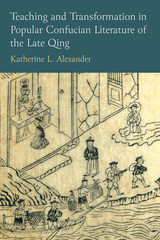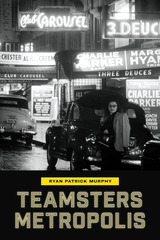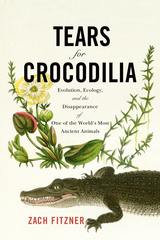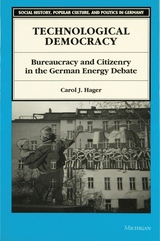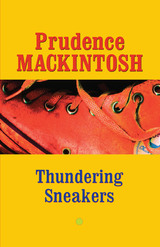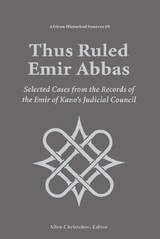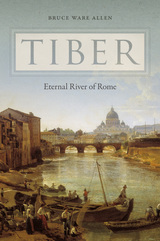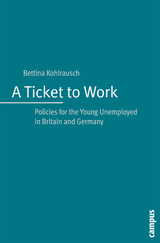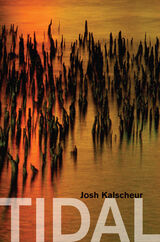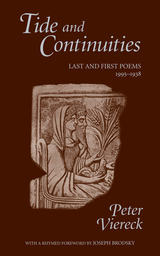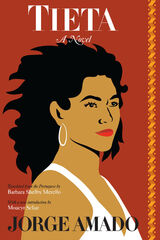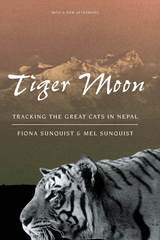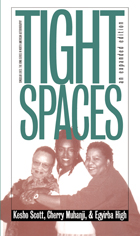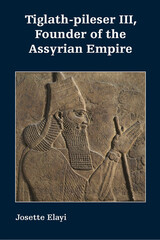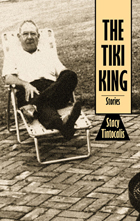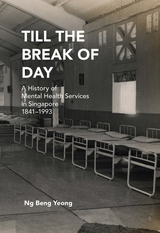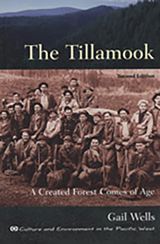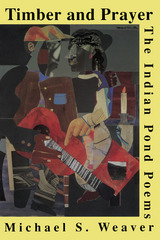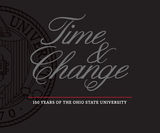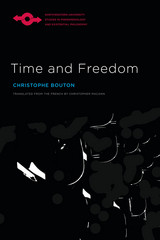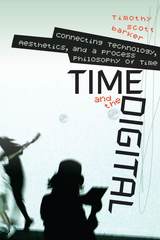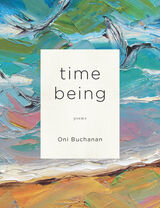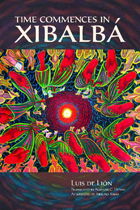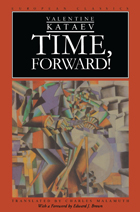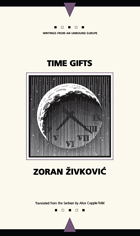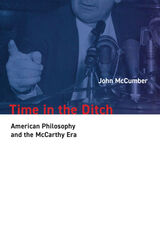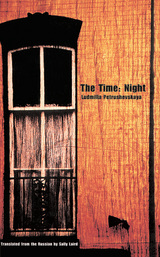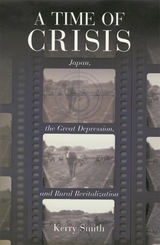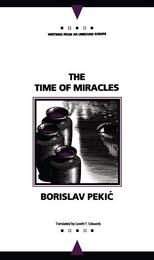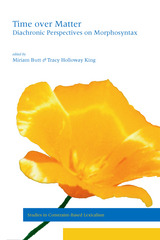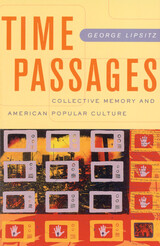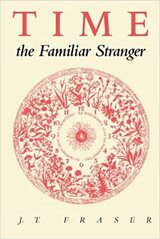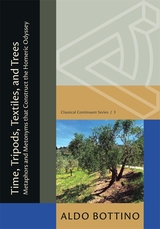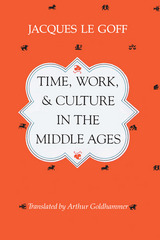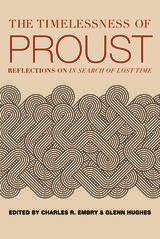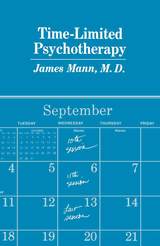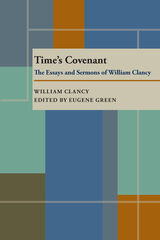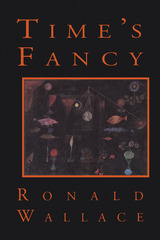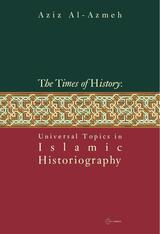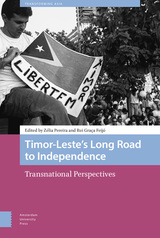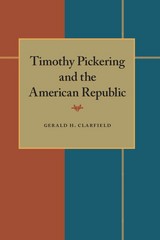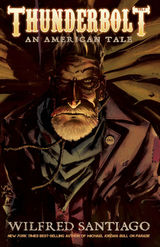 Thunderbolt: An American Tale, Vol. 1
Wilfred Santiago
Ohio State University Press, 2019 Hero. Terrorist. Martyr. Madman. Thunderbolt: An American Tale tells the true story of Old John Brown: abolitionist, insurrectionist, and American legend.
As a young boy in nineteenth-century America, Captain John Brown swore to dedicate his life to the struggle against slavery. Years later, he and his sons have joined the fight in Kansas, the epicenter of the national debate over slavery. As the territory nears statehood, abolitionists and proslavery border ruffians clash in increasingly violent conflict across the territory. But John Brown has more in mind than border skirmishes. He aims to eliminate slavery from US soil once and for all—even if that means raiding a government armory in order to arm a national slave revolt. From the Pottawatomie Massacre to the Battle of Black Jack and the Battle of Osawatomie, this first installment in the story of the legendary John Brown traces the rise of the insurrection in stunning detail.
Gritty, gripping, and masterfully illustrated, Wilfred Santiago’s telling of John Brown’s tale pulls no punches as it unflinchingly recounts the epic struggle across pre–Civil War America. And while John Brown’s methods may be questionable, his story is unforgettable. After all, dying is part of the plan.
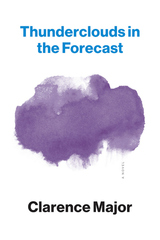 Thunderclouds in the Forecast: A Novel
Clarence Major
Northwestern University Press, 2021 Thunderclouds in the Forecast traverses the linked histories of two friends—one Black, the other white—who grew up wards of the state in New York. It’s April 1976 and Ray is taking Amtrak to San Francisco to reconnect with Scotty, his oldest friend, whom he met in a shelter for abandoned children. While Ray has embraced the stable tedium of steady employment, Scotty’s life has been erratic, a trail of short-lived affairs and dead-end jobs. Maybe Ray, who’s just won the lottery, is finally in a position to help him.
When Ray’s train is delayed in Lorena, a Gold Rush outpost turned college town, he meets Alice. Together they embark on a romance that tempts him to stay. By the time Ray arrives in San Francisco, Scotty has abandoned his bartending job, his rented room, and his scant belongings and skipped town with a married woman from Lorena. Now Ray has more than one reason to return.
A preeminent American writer who thrives on reinvention, Major returns with an unforgettable exploration of life on the brink of sweeping change. With spare prose and subtle poignancy, Thunderclouds in the Forecast probes love, loyalty, and belonging. As Toni Morrison wrote, “Clarence Major has a remarkable mind and the talent to match.”
Thunderhead
Emily Rose Cole
University of Wisconsin Press, 2022
Thundering Sneakers
By Prudence Mackintosh
University of Texas Press, 2002 Thundering Sneakers begins the story of the Mackintosh boys. In these essays, Prudence Mackintosh describes the delights and terrors of living with little boys who are determined to be boys, despite the carefully nonsexist childrearing practices of the 1970s. With telling vignettes of boyish disasters that drive her to despair, as well as the rare quiet moments of hugs and confidences that make it all worthwhile, she perfectly captures the early years when a young mother still looks for "the real mother" to come and bail her out.
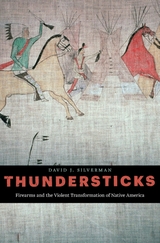 Thundersticks: Firearms and the Violent Transformation of Native America
David J. Silverman
Harvard University Press, 2016 The adoption of firearms by American Indians between the seventeenth and nineteenth centuries marked a turning point in the history of North America’s indigenous peoples—a cultural earthquake so profound, says David Silverman, that its impact has yet to be adequately measured. Thundersticks reframes our understanding of Indians’ historical relationship with guns, arguing against the notion that they prized these weapons more for the pyrotechnic terror guns inspired than for their efficiency as tools of war. Native peoples fully recognized the potential of firearms to assist them in their struggles against colonial forces, and mostly against one another.
The smoothbore, flintlock musket was Indians’ stock firearm, and its destructive potential transformed their lives. For the deer hunters east of the Mississippi, the gun evolved into an essential hunting tool. Most importantly, well-armed tribes were able to capture and enslave their neighbors, plunder wealth, and conquer territory. Arms races erupted across North America, intensifying intertribal rivalries and solidifying the importance of firearms in Indian politics and culture.
Though American tribes grew dependent on guns manufactured in Europe and the United States, their dependence never prevented them from rising up against Euro-American power. The Seminoles, Blackfeet, Lakotas, and others remained formidably armed right up to the time of their subjugation. Far from being a Trojan horse for colonialism, firearms empowered American Indians to pursue their interests and defend their political and economic autonomy over two centuries.
 Thunderstones and Shooting Stars: The Meaning of Meteorites
Robert T. Dodd
Harvard University Press A streak of light crosses the night sky as a bit of extraterrestrial material falls to Earth.
Meteorites, which range from particles of dust to massive chunks of metal and rock, bombard the Earth constantly, adding hundreds of tons of new material to our planet each day. What are these objects? How do we recover and study them? Where do they come from, and what do they tell us about the birth and infancy of the solar system? Why do many scientists now believe that meteorites have played a dramatic, albeit occasional, role in the evolution of life on Earth?
In Thunderstones and Shooting Stars, Robert T. Dodd gives us an up-to-date report on these questions. He summarizes the evidence that leads scientists to believe that most meteorites come from asteroids, although a few come from the moon and a few more from a planet, probably Mars. He explains how chondrites--the most numerous and primitive of meteorites--contribute to our evolving picture of the early solar system, and how some of them may tell us of events that took place beyond the sun and before its birth. Finally, he examines the controversial hypothesis that impacts by asteroids or comets have interrupted the evolution of life on Earth, accounting for such geological puzzles as the rapid demise of the dinosaurs.
Meteorites have been called "the poor man's space probe," for they are the only extraterrestrial rocks that we can collect without benefit of spacecraft. This lively and accessible book both illuminates the complex science of meteoritics and conveys a sense of its excitement. University teachers and students will appreciate its synthesis of new research on a broad range of topics, and amateurs will delight in its lucid presentation of a science that is unlocking many mysteries of Earth and space.
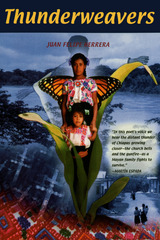 Thunderweavers/ Tejedoras de rayos
Juan Felipe Herrera
University of Arizona Press, 2000 The highlands of Chiapas are smoldering with death.
In the winter of 1997, paramilitary agents ambushed and killed many Mayan villagers in Acteal, Chiapas. Gifted writer Juan Felipe Herrera has composed a stirring poem sequence—published in a bilingual format—written in response and homage to those who died, as well as to all those who call for peace and justice in the Mexican highlands and throughout the Americas.
The sections are written in the voices of four women from a family in Chiapas: Xunka, a lost twelve-year-old girl; Pascuala, the mother; grandmother Maruch; and Makal, an older daughter who is pregnant. Each voice weaves into the others and speaks for still other members of the larger Mayan and Native American family.
Thunderweavers is a story of violent displacements in the lives of the most impoverished residents of southern Mexico.Through these words, readers will learn the meaning of transcendence and continuity in the midst of chaos, suffering, and war.
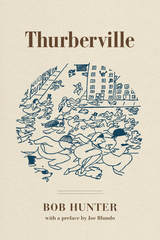 Thurberville
Bob Hunter
Ohio State University Press, 2017 James Thurber’s Columbus was not today’s Columbus—or even yesterday’s. It was a Columbus he both knew and created, a place perched on the fringe of reality and the fringe of his imagination. It is the place Bob Hunter revisits in Thurberville, a book where the author separates truth from fiction and identifies what parts of the famous humorist’s hometown of 180,000 exist in the burgeoning metro area of more than two million today.
Thurber’s Columbus was a wild and crazy place, a city full of fascinating and sometimes peculiar characters, many in his own family. Because of the widespread popularity of his stories, that was also the Columbus that many of his readers around the world came to know.
Thurberville chronicles those characters and explores that world. But it also examines the real city where Thurber struggled and then blossomed as a college student, worked as a newspaper reporter and a press agent, and achieved international fame as a humorist and cartoonist after he left town, in part by writing about the subjects he left behind.
Much of Thurber’s best work was cultivated by experiences Thurber had in Columbus and in his dealings with family, friends, teachers, and acquaintances there. They are worth a revisit and, in some cases, an introduction.
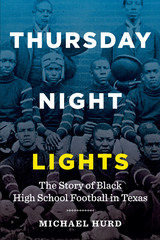 Thursday Night Lights: The Story of Black High School Football in Texas
By Michael Hurd
University of Texas Press, 2019 At a time when “Friday night lights” shone only on white high school football games, African American teams across Texas burned up the gridiron on Wednesday and Thursday nights. The segregated high schools in the Prairie View Interscholastic League (the African American counterpart of the University Interscholastic League, which excluded black schools from membership until 1967) created an exciting brand of football that produced hundreds of outstanding players, many of whom became college All-Americans, All-Pros, and Pro Football Hall of Famers, including NFL greats such as “Mean” Joe Green (Temple Dunbar), Otis Taylor (Houston Worthing), Dick “Night Train” Lane (Austin Anderson), Ken Houston (Lufkin Dunbar), and Bubba Smith (Beaumont Charlton-Pollard). Thursday Night Lights tells the inspiring, largely unknown story of African American high school football in Texas. Drawing on interviews, newspaper stories, and memorabilia, Michael Hurd introduces the players, coaches, schools, and towns where African Americans built powerhouse football programs under the PVIL leadership. He covers fifty years (1920–1970) of high school football history, including championship seasons and legendary rivalries such as the annual Turkey Day Classic game between Houston schools Jack Yates and Phillis Wheatley, which drew standing-room-only crowds of up to 40,000, making it the largest prep sports event in postwar America. In telling this story, Hurd explains why the PVIL was necessary, traces its development, and shows how football offered a potent source of pride and ambition in the black community, helping black kids succeed both athletically and educationally in a racist society.
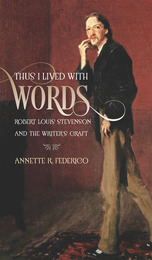 Thus I Lived with Words: Robert Louis Stevenson and the Writer's Craft
Annette R. Federico
University of Iowa Press, 2017 Robert Louis Stevenson (1850–1894) loved more than anything to talk about the craft of writing and the pleasure of reading good books. His dedication to the creative impulse manifests itself in the extraordinary amount of work he produced in virtually every literary genre—fiction, poetry, travel writing, and essays—in a short and peripatetic life. His letters, especially, confess his elation at the richness of words and the companionship of books, often projected against ill health and the shadow of his own mortality.
Stevenson belonged to a newly commercial literary world, an era of mass readership, marketing, and celebrity. He had plenty of practical advice for writers who wanted to enter the profession: study the best authors, aim for simplicity, strike a keynote, work on your style. He also held that a writer should adhere to the truth and utter only what seems sincere to his or her heart and experience of the world. Writers have messages to deliver, whether the work is a tale of Highland adventure, a collection of children’s verse, or an essay on umbrellas. Stevenson believed that an author could do no better than to find the appetite for joy, the secret place of delight that is the hidden nucleus of most people’s lives. His remarks on how to write, on style and method, and on pleasure and moral purpose contain everything in literature and life that he cared most about—adventuring, persisting, finding out who you are, and learning to embrace “the romance of destiny.”
Thus Ruled Emir Abbas: Selected Cases from the Records of the Emir of Kano's Judicial Council
Allen Christelow
Michigan State University Press, 1994 Thus Ruled Emir Abbas is an important new research tool that reveals much about daily life in Kano, the wealthiest and most populous emirate of the African Sokoto Caliphate. It contains a selection of Kano Judicial Council documents, as well as their English translations, that deal with matters such as land disputes, tax collection disputes, and theft. These documents are invaluable resources that reveal much about Kano social, economic, and political life before the region came under the influence of colonial institutions, law, and language. This selection of records for more than 415 cases, along with their translations, will become essential reading for those interested in Nigeria’s past and will certainly become a standard work in the field of Nigerian history and anthropology.
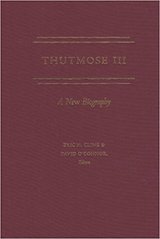 Thutmose III: A New Biography
Eric H. Cline and David O'Connor, Editors
University of Michigan Press, 2006 Thutmose III was without question one of Egypt's greatest pharaohs. His 54-year reign was packed with momentous events as well as being unusually long. Thutmose III includes an overview of his life, and detailed examinations of civil administration, the religion and cults, the monumental architecture and royal building program, royal tombs and iconography, royal portraiture and ideology, the artistic production, the Northern and Southern campaigns, as well as the Aegean and other foreign visitors to Egypt during Thutmose's time. Finally, the book concludes with a look at the end of his reign and the accession of Amenhotep II. This extensive treatment of a pivotal figure in the ancient Mediterranean world during the Late Bronze Age will provide a uniquely comprehensive view of one of Egypt's greatest pharaohs and will be of interest to a wide audience, including specialists in Egypt and the Near East, graduate and undergraduate students, and those with a general interest in Egypt. Eric H. Cline is Associate Professor of Ancient History and Archaeology in the Department of Classical and Semitic Languages and Literatures at George Washington University. David O'Connor is Lila Acheson Wallace Professor of Ancient Egyptian Art and Archaeology at the New York University Institute of Fine Arts.
 Thwarting Enemies at Home and Abroad: How to Be a Counterintelligence Officer
William R. Johnson. Foreword by William Hood
Georgetown University Press, 2009 A Classic in Counterintelligence—Now Back in Print Originally published in 1987, Thwarting Enemies at Home and Abroad is a unique primer that teaches the principles, strategy, and tradecraft of counterintelligence (CI). CI is often misunderstood and narrowly equated with security and catching spies, which are only part of the picture. As William R. Johnson explains, CI is the art of actively protecting secrets but also aggressively thwarting, penetrating, and deceiving hostile intelligence organizations to neutralize or even manipulate their operations. Johnson, a career CIA intelligence officer, lucidly presents the nuts and bolts of the business of counterintelligence and the characteristics that make a good CI officer. Although written during the late Cold War, this book continues to be useful for intelligence professionals, scholars, and students because the basic principles of CI are largely timeless. General readers will enjoy the lively narrative and detailed descriptions of tradecraft that reveal the real world of intelligence and espionage. A new foreword by former CIA officer and noted author William Hood provides a contemporary perspective on this valuable book and its author.
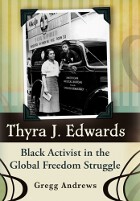 Thyra J. Edwards: Black Activist in the Global Freedom Struggle
Gregg Andrews
University of Missouri Press, 2011 In 1938, a black newspaper in Houston paid front-page tribute to Thyra J. Edwards as the embodiment of “The Spirit of Aframerican Womanhood.” Edwards was a world lecturer, journalist, social worker, labor organizer, women’s rights advocate, and civil rights activist—an undeniably important figure in the social struggles of the first half of the twentieth century. She experienced international prominence throughout much of her life, from the early 1930s to her death in 1953, but has received little attention from historians in years since. Gregg Andrews’s Thyra J. Edwards: Black Activist in the Global Freedom Struggle is the first book-length biographical study of this remarkable, historically significant woman.
Edwards, granddaughter of runaway slaves, grew up in Jim Crow–era Houston and started her career there as a teacher. She moved to Gary, Indiana, and Chicago as a social worker, then to New York as a journalist, and later became involved with the Communist Party, attracted by its stance on race and labor. She was mentored by famed civil rights leader A. Philip Randolph, who became her special friend and led her to pursue her education. She obtained scholarships to college, and after several years of study in the U.S. and then in Denmark, she became a women’s labor organizer and a union publicist.
In the 1930s and 1940s, she wrote about international events for black newspapers, traveling to Europe, Mexico, and the Soviet Union and presenting an anti-imperialist critique of world affairs to her readers. Edwards’s involvement with the Loyalists in the Spanish Civil War, her work in a Jewish refugee settlement in Italy, and her activities with U.S. communists drew the attention of the FBI. She was harassed by government intelligence organizations until she died at the age of just fifty-five. Edwards contributed as much to the radical foundations of the modern civil rights movements as any other woman of her time.
This fascinating new biography details Thyra Edwards’s lifelong journey and myriad achievements, describing both her personal and professional sides and the many ways they intertwined. Gregg Andrews used Edwards’s official FBI file—along with her personal papers, published articles, and civil rights manuscript collections—to present a complete portrait of this noteworthy activist. An engaging volume for the historian as well as the general reader, Thyra J. Edwards explores the complete domestic and international impact of her life and actions.
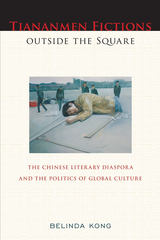 Tiananmen Fictions outside the Square: The Chinese Literary Diaspora and the Politics of Global Culture
Belinda Kong
Temple University Press, 2012 An exciting analysis of the myriad literary effects of Tiananmen, Belinda Kong's Tiananmen Fictions Outside the Square is the first full-length study of fictions related to the 1989 movement and massacre. More than any other episode in recent world history, Tiananmen has brought a distinctly politicized Chinese literary diaspora into stark relief.
Kong redefines Tiananmen's meaning from an event that ended in local political failure to one that succeeded in producing a vital dimension of contemporary transnational writing today. She spotlights key writers-Gao Xingjian, Ha Jin, Annie Wang, and Ma Jian-who have written and published about the massacre from abroad. Their outsider/distanced perspectives inform their work, and reveal how diaspora writers continually reimagine Tiananmen's relevance to the post-1989 world at large.
Compelling us to think about how Chinese culture, identity, and politics are being defined in the diaspora, Tiananmen Fictions Outside the Square candidly addresses issues of political exile, historical trauma, global capital, and state biopower.
Tiber: Eternal River of Rome
Bruce Ware Allen
University Press of New England, 2018 In this rich history of Italy’s Tiber River, Bruce Ware Allen charts the main currents, mythic headwaters, and hidden tributaries of one of the world’s most renowned waterways. He considers life along the river, from its twin springs high in the Apennines all the way to its mouth at Ostia, and describes the people who lived along its banks and how they made the Tiber work for them. The Tiber has served as the realm of protomythic creatures and gods, a battleground for armies and navies, a livelihood for boatmen and fishermen, the subject matter of poets and painters, and the final resting place for criminals and martyrs. Tiber: Eternal River of Rome is a highly readable history and a go-to resource for information about Italy’s most storied river.
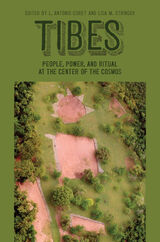 Tibes: People, Power, and Ritual at the Center of the Cosmos
Edited by L. Antonio Curet and Lisa M. Stringer
University of Alabama Press, 2009 The first comprehensive analysis of a strategically located ceremonial center on the island of Puerto Rico
The prehistoric civic-ceremonial center of Tibes is located on the southern coast of Puerto Rico, just north of the modern coastal city of Ponce. Protected on two sides by a river, and on the other two sides by hills, this approximately 10.5-acre site remains as fertile and productive today as when first occupied over 2,000 years ago. Such a rich region would have been a choice location for native peoples because of the diversity in all resources, from land, air, and sea--and also symbolically crucial as a liminal space within the landscape. It may have been regarded as a space charged with numen or cosmic energy where different parts of the cosmos (natural vs. supernatural, or world of the living vs. world of the dead) overlap. Archaeological evidence reveals a long occupation, about 1,000 years, possibly followed by an extensive period of sporadic ceremonial use after the site itself was practically abandoned.
In this volume, nineteen Caribbeanists, across a wide academic spectrum, examine the geophysical, paleoethnobotanical, faunal, lithics, base rock, osteology, bone chemistry and nutrition, social landscape, and ceremonial constructs employed at Tibes. These scholars provide a concise, well-presented, comprehensive analysis of the evidence for local level changes in household economy, internal organization, accessibility to economic, religious, and symbolic resources related to the development and internal operation of socially stratified societies in the Caribbean.
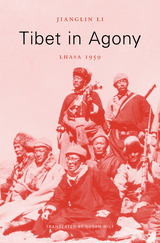 Tibet in Agony: Lhasa 1959
Jianglin Li
Harvard University Press, 2016 The Chinese Communist government has twice invoked large-scale military might to crush popular uprisings in capital cities. The second incident—the notorious massacre in Tiananmen Square in 1989—is well known. The first, thirty years earlier in Tibet, remains little understood today. Yet in wages of destruction, bloodshed, and trampling of human rights, the tragic toll of March 1959 surpassed Tiananmen.
Tibet in Agony provides the first clear historical account of the Chinese crackdown in Lhasa. Sifting facts from the distortions of propaganda and partisan politics, Jianglin Li reconstructs a chronology of events that lays to rest lingering questions about what happened in those fate-filled days and why. Her story begins with throngs of Tibetan demonstrators who—fearful that Chinese authorities were planning to abduct the Dalai Lama, their beloved leader—formed a protective ring around his palace. On the night of March 17, he fled in disguise, only to reemerge in India weeks later to set up a government in exile. But no peaceful resolution awaited Tibet. The Chinese army soon began shelling Lhasa, inflicting thousands of casualties and ravaging heritage sites in the bombardment and the infantry onslaught that followed. Unable to resist this show of force, the Tibetans capitulated, putting Mao Zedong in a position to fulfill his long-cherished dream of bringing Tibet under the Communist yoke.
Li’s extensive investigation, including eyewitness interviews and examination of classified government records, tells a gripping story of a crisis whose aftershocks continue to rattle the region today.
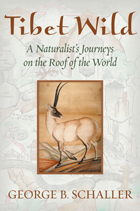 Tibet Wild: A Naturalist's Journeys on the Roof of the World
George B. Schaller
Island Press, 2014 As one of the world’s leading field biologists, George Schaller has spent much of his life traversing wild and isolated places in his quest to understand and conserve threatened species—from mountain gorillas in the Virunga to pandas in the Wolong and snow leopards in the Himalaya. Throughout his celebrated career, Schaller has spent more time in Tibet than in any other part of the world, devoting more than thirty years to the wildlife, culture, and landscapes that captured his heart and continue to compel him to protect them.
Tibet Wild is Schaller’s account of three decades of exploration in the most remote stretches of Tibet: the wide, sweeping rangelands of the Chang Tang and the hidden canyons and plunging ravines of the southeastern forests. As engaging as he is enlightening, Schaller illustrates the daily struggles of a field biologist trying to traverse the impenetrable Chang Tang, discover the calving grounds of the chiru or Tibetan antelope, and understand the movements of the enigmatic snow leopard.
As changes in the region accelerated over the years, with more roads, homes, and grazing livestock, Schaller watched the clash between wildlife and people become more common—and more destructive. Thus what began as a purely scientific endeavor became a mission: to work with local communities, regional leaders, and national governments to protect the unique ecological richness and culture of the Tibetan Plateau.
Whether tracking brown bears, penning fables about the tiny pika, or promoting a conservation preserve that spans the borders of four nations, Schaller has pursued his goal with a persistence and good humor that will inform and charm readers. Tibet Wild is an intimate journey through the changing wilderness of Tibet, guided by the careful gaze and unwavering passion of a life-long naturalist.
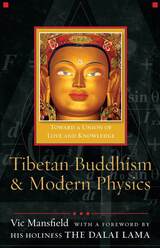 Tibetan Buddhism and Modern Physics: Toward a Union of Love and Knowledge
Vic Mansfield
Templeton Press, 2008 Tibetan Buddhism and Modern Physics: Toward a Union of Love and Knowledge addresses the complex issues of dialogue and collaboration between Buddhism and science, revealing connections and differences between the two. While assuming no technical background in Buddhism or physics, this book strongly responds to the Dalai Lama’s “heartfelt plea” for genuine collaboration between science and Buddhism. The Dalai Lama has written a foreword to the book and the Office of His Holiness will translate it into both Chinese and Tibetan. In a clear and engaging way, this book shows how the principle of emptiness, the philosophic heart of Tibetan Buddhism, connects intimately to quantum nonlocality and other foundational features of quantum mechanics. Detailed connections between emptiness, modern relativity, and the nature of time are also explored. For Tibetan Buddhists, the profound interconnectedness implied by emptiness demands the practice of universal compassion. Because of the powerful connections between emptiness and modern physics, the book argues that the interconnected worldview of modern physics also encourages universal compassion. Along with these harmonies, the book explores a significant conflict between quantum mechanics and Tibetan Buddhism concerning the role of causality.
The book concludes with a response to the question: "How does this expedition through the heart of modern physics and Tibetan Buddhism—from quantum mechanics, relativity, and cosmology, to emptiness, compassion, and disintegratedness—apply to today's painfully polarized world?" Despite differences and questions raised, the book's central message is that there is a solid basis for uniting these worldviews. From this basis, the message of universal compassion can accompany the spread of the scientific worldview, stimulating compassionate action in the light of deep understanding—a true union of love and knowledge.
Tibetan Buddhism and Modern Physics will appeal to a broad audience that includes general readers and undergraduate and graduate students in science and religion courses.
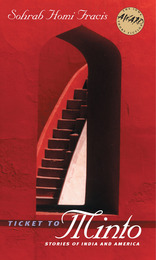 Ticket to Minto: Stories of India and America
Homi Sohrab Fracis
University of Iowa Press, 2001 Ticket to Minto, Sohrab Homi Fracis's premier fiction collection, offers readers a passage to an unfamiliar destination-a world suspended between East and West, India and America, home and away. With piercing insight, Fracis expertly reveals the underlying differences between immersion in India's culture-Hindu, Muslim, or Parsi-and life as an Indian in America. Alternating between East and West, the stories in Ticket to Minto serve as companion pieces, interrelated across continents in both theme and content. A middle-aged man's search for love in Bombay is contrasted with an Indian American family's hopes for the marriage of their westernized daughter. A university student rushes to save the life of a servant in his homeland only to find his own life threatened while attending graduate school in America. Poignant and daring, Ticket to Minto underlines the harsh realization that the immigrant never truly arrives but is in constant limbo between two worlds. As one character relates, "There's a part of me that's American and a part that's Indian. I'm clear about that and comfortable with it, except that sometimes people want me to be just the one or the other."
A Ticket to Work: Policies for the Young Unemployed in Britain and Germany
Bettina Kohlrausch
Campus Verlag, 2009
In A Ticket to Work, Bettina Kohlrausch examines the differing approaches taken by Britain and Germany to assisting young people with the often difficult transition from school to full-time work. Detailing the workings of such programs as skills training and job-placement assistance, the volume places those vocational training methods in the context of the general political and economic climate of the two nations, drawing a contrast between Britain’s more liberal market economy and Germany’s more structured and coordinated regime.
Tidal
Josh Kalscheur
Four Way Books, 2015 Tidal focuses on Chuuk State, a group of islands that are a part of the Federated States of Micronesia. This focus encompasses Micronesia’s morality, its taboos and myths, and how information and stories disseminate between villages, social groups, ethnicities, classes, and genders. Using persona, these poems explore and challenge the idea of witness.
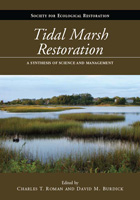 Tidal Marsh Restoration: A Synthesis of Science and Management
Edited by Charles T. Roman and David M. Burdick
Island Press, 2011 Tidal Marsh Restoration offers coastal managers, planners, and restoration professionals the essential knowledge needed to restore tidal flow and ecological function to degraded salt marshes. As roadways, dikes, and development have increasingly restricted natural tidal movement, many marshes have lost their ability to support wildlife, filter water, buffer floods, and sustain healthy ecosystems. This book shows how to bring them back.
Combining scientific insight with real-world application, the book brings together leading voices in hydrology, ecology, soil science, engineering, and public policy. It synthesizes decades of field experience and emerging research to provide a clear, practical roadmap for restoring tidal influence and revitalizing marsh habitats. Readers will find detailed guidance on project design, hydraulic modeling, vegetation dynamics, and monitoring strategies—supported by case studies from successful efforts in New England and Atlantic Canada.
More than just a technical manual, Tidal Marsh Restoration bridges disciplines and scales, helping practitioners understand both the ecological systems at stake and the policy, regulatory, and community contexts in which restoration must happen. For those working to restore salt marshes in the face of sea-level rise, habitat loss, and climate-related challenges, this book provides both the tools and the insight needed to design projects that succeed and endure.
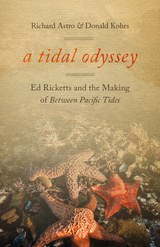 A Tidal Odyssey: Ed Ricketts and the Making of Between Pacific Tides
Richard Astro
Oregon State University Press, 2021 Between Pacific Tides by Edward F. Ricketts and Jack Calvin is arguably the most important book about marine ecology on the Pacific coast of North America. At a time when almost all studies of life in the intertidal zones were taxonomic, Ricketts and Calvin revolutionized the field and helped to lay the groundwork for studies of the impact of environmental change on the natural world. Though Ricketts is perhaps best known as a quirky character in John Steinbeck’s fiction, he was a serious marine biologist who conducted pioneering research.
In A Tidal Odyssey, literary scholar Richard Astro and archivist Donald Kohrs explore how Between Pacific Tides came to be, covering both the writing process and the long journey to publication. They tell three interwoven stories: the development of ecology as a valuable new approach to the study of marine life in the intertidal zone; a case study of how new and dynamic science is published and reaches a larger audience; and the intellectual development of Ed Ricketts.
Not only a scientist but also an expert in music, philosophy, history, and literature, Ricketts and his work impacted a broad range of writers and scholars. A number of these intellectual figures appear in A Tidal Odyssey, including Ricketts’s co-author, Jack Calvin, and illustrator, Ritch Lovejoy; mythologist Joseph Campbell; novelist Henry Miller; composer John Cage; and of course John Steinbeck. The authors have drawn extensively from Ricketts’s archive, including previously unpublished letters, memoranda, notebooks, and photographs.
A Tidal Odyssey is for anyone interested in the world of Ed Ricketts as well as marine biology, intertidal ecology, and how ecological studies underpin our understanding of the impact of environmental change on the well-being of our planet.
 Tidal Power
A.C. Baker
The Institution of Engineering and Technology, 1991 The tides, generated by the revolution of the earth in the gravitational fields of the sun and moon, are an enormous resource of renewable energy. Moreover, the times and heights of tides can be accurately predicted well into the future. However, tidal ranges in the oceans vary from 50cm or less to over 10 m, and it is the largest tides that represent the best energy source. This book describes how large tides develop in particular places and how the energy could be extracted by building suitable barrages. The principal features of a barrage and possible methods of operation are described in detail. Although a tidal power barrage would be non-polluting, the resulting changes in the tidal regime would have important environmental effects. These are discussed together with the economics of tidal power. Methods of assessing the likely cost of electricity from any site are set out and applied to possible sites around the world.
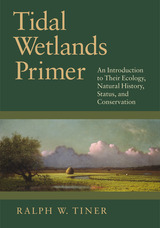 Tidal Wetlands Primer: An Introduction to Their Ecology, Natural History, Status, and Conservation
Ralph W. Tiner
University of Massachusetts Press, 2013 At a time when more than half of the U.S. population lives within fifty miles of the coast, tidal wetlands are a critical and threatened natural resource. The purpose of this book is to introduce the world of tidal wetlands to students and professionals in the environmental fields and others with an interest in the subject.
Illustrated with maps, photographs, and diagrams, this volume provides a clear account of the factors that make these habitats unique and vulnerable. It discusses their formation, the conditions affecting their plant and animal life, and the diversity of types across North America, as well as their history, use by wildlife and humans, current status, conservation, restoration, and likely future. The emphasis is on vegetated wetlands—marshes and swamps—with additional discussion of eelgrass meadows, rocky shores, beaches, and tidal flats.
Ralph Tiner's previous field guides to coastal wetland plants in the Northeast and Southeast have been widely praised. Tidal Wetlands Primer joins Tiner's earlier publications as an authoritative and user-friendly guide that should appeal to anyone with a serious interest in coastal habitats.
Tide and Continuities: Last and First Poems, 1995-1938
Peter Viereck
University of Arkansas Press, 1995 Peter Viereck’s career in poetry is an ongoing experiment in the symbiosis of poetry and history. In Tide and Continuities that experiment has yielded its finest results. Included are many new poems, never before published, and stunning revisions from work as recent as his 1987 epic, Archer in the Marrow: The Applewood Cycles, and as early as his 1948 Pulitzer Prize-winning collection, Terror and Decorum. This collection is the revelation of a great American poet. The Nobel laureate Joseph Brodsky calls Viereck “possibly the greatest rhymer of / the modern period.” This is Viereck’s most lyrical, most passionate book; hence Brodsky rhymes “lyric” with “Viereck.” Tide and Continuities marks Viereck’s complete evolution as a poet, and brilliantly describes the arc of more than a half century’s work.
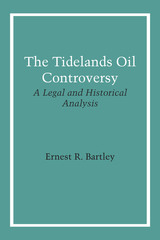 The Tidelands Oil Controversy: A Legal and Historical Analysis
By Ernest R. Bartley
University of Texas Press, 1953 This study is not written from the narrow perspective of “Who gets the oil?” It is a thoughtful probing of an issue—the ownership and control of the submerged soils of the marginal sea—the outcome of which may go far to determine the division of powers between states and nation under the American federal system. American constitutional law, international law, theory of federalism, American politics, the machinations of pressure groups, use of propaganda techniques, and issues of social and economic policy—all these features of American government and many more are inherent in the controversy. In 1947, in a precedent-making decision, the Supreme Court enunciated the principle that the federal government, not the states, has “paramount rights in and power over” the marginal seas which border the coastal states, and has “full dominion over the resources under that water area, including oil.” For more than 150 years the littoral states had exercised uncontested jurisdiction and ownership over the marginal-sea area, subject only to the powers specifically granted to the national government by the Constitution. The states had regulated the fisheries within the three-mile limit, applying state laws to vessels licensed under federal statutes. Long before oil possibilities were thought of, they had granted or leased areas in the marginal seas to private persons and corporations for purposes of land reclamation and harbor development, dredging for sand and gravel, development of oyster beds, and similar projects. These property rights can far exceed in value the wealth to be derived from petroleum. A just settlement of the issue, says the author, calls for restoration to the states of control of the marginal sea out to their historical boundaries—three miles in most cases; three leagues, or ten and one-half miles, in the case of Texas and the west coast of Florida. This study is based upon thorough investigation of all literature on the subject and personal interviews and correspondence with leaders on both sides of the controversy.
 Tides and Floods: New Research on London and the Tidal Thames from the Middle Ages to the Twentieth Century
James Galloway
University of London Press, 2010 The lands bordering the tidal river Thames and the Thames Estuary have historically been highly vulnerable to marine flooding. The most severe of these floods derive from North Sea storm surges, when wind and tide combine to drive huge quantities of water against the coast, as happened to devastating effect in 1953. This project seeks to understand the occurrence of storm flooding in the past, and to explore the ways in which people have responded to the threat. The project draws upon rich surviving documentary sources to study the impact of storm flooding upon the reclaimed marshlands bordering the tidal Thames and its estuary during the period c.1250-1550. Year-by-year accounts of the management of riverside properties have been examined and the degree to which reclaimed land was lost to the sea during the later Middle Ages assessed. The impact of population decline and agrarian recession upon the economics of coastal and river-side defence has been considered. The flood threat to medieval London’s low-lying suburbs has been investigated and the possibility that the long-term flooding of lands down-river spared the city the worst effects of North Sea storm surges explored. Parallels have also been sought in the modern policy of managed retreat or realignment. The volume concludes with an overview of the multi-faceted work of the Thames Discovery Programme, which is increasing our knowledge of many aspects of the Thames’s past, from medieval fish traps, through nineteenth-century shipbuilding, to the Blitz, which posed a new and very real flood threat to the mid-twentieth century metropolis.
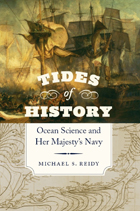 Tides of History: Ocean Science and Her Majesty's Navy
Michael S. Reidy
University of Chicago Press, 2008 In the first half of the nineteenth century, the British sought to master the physical properties of the oceans; in the second half, they lorded over large portions of the oceans’ outer rim. The dominance of Her Majesty’s navy was due in no small part to collaboration between the British Admiralty, the maritime community, and the scientific elite. Together, they transformed the vast emptiness of the ocean into an ordered and bounded grid. In the process, the modern scientist emerged. Science itself expanded from a limited and local undertaking receiving parsimonious state support to worldwide and relatively well financed research involving a hierarchy of practitioners.
Analyzing the economic, political, social, and scientific changes on which the British sailed to power, Tides of History shows how the British Admiralty collaborated closely not only with scholars, such as William Whewell, but also with the maritime community —sailors, local tide table makers, dockyard officials, and harbormasters—in order to systematize knowledge of the world’s oceans, coasts, ports, and estuaries. As Michael S. Reidy points out, Britain’s security and prosperity as a maritime nation depended on its ability to maneuver through the oceans and dominate coasts and channels. The practice of science and the rise of the scientist became inextricably linked to the process of European expansion.
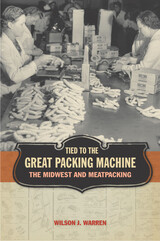 Tied to the Great Packing Machine: The Midwest and Meatpacking
Wilson J. Warren
University of Iowa Press, 2007 Ambitious in its historical scope and its broad range of topics, Tied to the Great Packing Machine tells the dramatic story of meatpacking’s enormous effects on the economics, culture, and environment of the Midwest over the past century and a half. Wilson Warren situates the history of the industry in both its urban and its rural settings—moving from the huge stockyards of Chicago and Kansas City to today’s smaller meatpacking communities—and thus presents a complete portrayal of meatpacking’s place within the larger agro-industrial landscape.
Writing from the vantage point of twenty-five years of extensive research, Warren analyzes the evolution of the packing industry from its early period, dominated by the big terminal markets, through the development of new marketing and technical innovations that transformed the ways animals were gathered, slaughtered, and processed and the final products were distributed. In addition, he concentrates on such cultural impacts as ethnic and racial variations, labor unions, gender issues, and changes in Americans’ attitudes toward the ethics of animal slaughter and patterns of meat consumption and such environmental problems as site-point pollution and microbe contamination, ending with a stimulating discussion of the future of American meatpacking.
Providing an excellent and well-referenced analysis within a regional and temporal framework that ensures a fresh perspective, Tied to the Great Packing Machine is a dynamic narrative that contributes to a fuller understanding of the historical context and contemporary concerns of an extremely important industry.
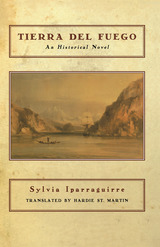 Tierra del Fuego
Sylvia Iparraguirre
Northwestern University Press, 2000 Tierra del Fuego is more than a suspenseful seafaring tale in the tradition of Captain Hornblower; it is also a chilling psychological and cultural tale, reminiscent of Heart of Darkness or Lord of the Flies, that probes deeply into human nature. Based on the true story of the Yámana Indian, Jemmy Button (parts of which are recorded in Chapter 10 of Charles Darwin's The Voyage of the Beagle), the novel explores Captain Robert Fitzroy's abduction of Jemmy Button and his attempt to "civilize" him in England and return him to his country as a bearer of "enlightened society." His experiment leads to tragic consequences. The novel deals with European arrogance and exploitation, but avoids falling into the cliché of "the Noble Savage." Jemmy (the "Other") remains strange and the attempt to co-opt him fails.
Tierra del Fuego has already won two major awards for the Spanish edition: The Sor Juana Inés de la Cruz Award for the best work of fiction written by a woman and The Best Book of the Year Award at the Buenos Aires Book Fair.
 Ties of Kinship: Genealogy and Dynastic Marriage in Kyivan Rus´
Christian Raffensperger
Harvard University Press The warp and weft of political and social relationships among the medieval elite were formed by marriages made between royal families. Ties of Kinship establishes a new standard for tracking the dynastic marriages of the ruling family of Rus´—the descendants of Volodimer (Volodimeroviči). Utilizing a modern scholarly approach and a broad range of primary sources from inside and outside Rus´, Christian Raffensperger has created a fully realized picture of the Volodimeroviči from the tenth through the twelfth centuries and the first comprehensive, scholarly treatment of the subject in English.
Alongside more than twenty-two genealogical charts with accompanying bibliographic information, this work presents an analysis of the Volodimeroviči dynastic marriages with modern interpretations and historical contextualization that highlights the importance of Rus´ in a medieval European framework. This study will be used by Slavists, Byzantinists, and West European medievalists as the new baseline for research on the Volodimeroviči and their complex web of relationships with the world beyond.
The Ties That Bind
Julius M. Moravcsik
Central European University Press, 2004 This book, like in classical times of Plato and Aristotle, treats individual and communal ethics as intertwined. At its heart lies the quartet of respect, concern for welfare of others, trust, and care as the basic communal ties. The community needs to be built on these. Acquisition and practice of other values and goods are within the frame of the four underlying "pillars." The four basic notions are attitudes and as such consist of both rational and emotional elements. Thus our ethics is neither based purely on sentiment nor purely on reason. As such they will yield us guidelines, to be filled in contextually, not rigid rule systems. Moravcsik's proposal for ethics is pluralistic but not relativistic. It does not deny some objective ground for sound communal life, but leaves many alternatives within which the four basic ties can be implemented.
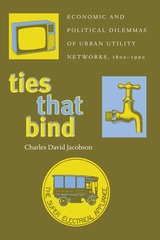 Ties That Bind: Economic and Political Dilemmas of Urban Utility Networks, 1800–1990
Charles Jacobson
University of Pittsburgh Press, 2001
In the early days of utility development, municipalities sought to shape the new systems in a variety of ways even as private firms struggled to retain control and fend off competition. In scope and consequence, some of the battles dwarfed the contemporary one between local jurisdictions and cable companies over broadband access to the Internet.
In this comparative historical study, Jacobson draws upon economic theory to shed light on relationships between technology, market forces, and problems of governance that have arisen in connection with different utility networks over the past two hundred years. He focuses on water, electric, and cable television utility networks and on experiences in four major American cities—Boston, Seattle, San Francisco, and Pittsburgh, arguing that information and transactions costs have played decisive roles in determining how different ownership and regulatory arrangements have functioned in different situations.
Using primary sources and bold conceptualizations, Jacobson begins his study by examining the creation of centralized water systems in the first half of the nineteenth century, moves to the building of electric utilities from the 1880s to the 1980s, and concludes with an analysis of cable television franchising from the 1960s to the 1980s. Ties That Bind addresses highly practical questions of how to make ownership, regulatory, and contracting arrangements work better and also explores broader concerns about private monopoly and the role of government in society.
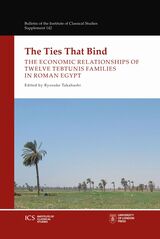 The Ties That Bind: The Economic Relationships of Twelve Tebtunis Families
Edited by Ryosuke Takahashi
University of London Press, 2021 An intimate insight into the lives of twelve families in the Ancient Egyptian village of Tebtunis.
Tebtunis, an ancient village formerly located in lower Egypt, is one of the most enduring subjects of study from the civilization's Roman era. This fascinating volume details a dozen newly-discovered family papers that have survived from the second century AD. Belonging to families of various different classes, this unique documentation provides a rare opportunity to explore how local elites under Roman rule exploited their wealth in the countryside and interacted with its rural inhabitants.
Ties That Bind is the first book to investigate these family papers holistically, focusing on the economic activities in which the families engaged: land leases, loans in cash and kind, and the employment of managers and laborers on landed estates. This study also addresses strategy and decision-making among both elite families and villagers, the complexity of interfamilial relationships, and the implications of this social networking. This micro-historical study elucidates the diversity of socio-economic life in a village where no single family dominated.
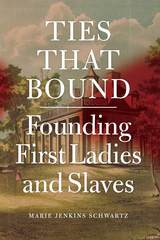 Ties That Bound: Founding First Ladies and Slaves
Marie Jenkins Schwartz
University of Chicago Press, 2017 Behind every great man stands a great woman. And behind that great woman stands a slave. Or so it was in the households of the Founding Fathers from Virginia, where slaves worked and suffered throughout the domestic environments of the era, from Mount Vernon, Monticello, and Montpelier to the nation’s capital. American icons like Martha Washington, Martha Jefferson, and Dolley Madison were all slaveholders. And as Marie Jenkins Schwartz uncovers in Ties That Bound, these women, as the day-to-day managers of their households, dealt with the realities of a slaveholding culture directly and continually, even in the most intimate of spaces.
Unlike other histories that treat the stories of the First Ladies’ slaves as separate from the lives of their mistresses, Ties That Bound closely examines the relationships that developed between the First Ladies and their slaves. For elite women and their families, slaves were more than an agricultural workforce; slavery was an entire domestic way of life that reflected and reinforced their status. In many cases slaves were more constant companions to the white women of the household than were their husbands and sons, who often traveled or were at war. By looking closely at the complicated intimacy these women shared, Schwartz is able to reveal how they negotiated their roles, illuminating much about the lives of slaves themselves, as well as class, race, and gender in early America.
By detailing the prevalence and prominence of slaves in the daily lives of women who helped shape the country, Schwartz makes it clear that it is impossible to honestly tell the stories of these women while ignoring their slaves. She asks us to consider anew the embedded power of slavery in the very earliest conception of American politics, society, and everyday domestic routines.
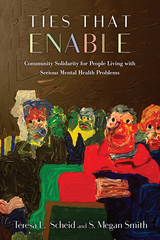 Ties That Enable: Community Solidarity for People Living with Serious Mental Health Problems
Teresa L. Scheid
Rutgers University Press, 2021 Ties that Enable is written for students, providers, and advocates seeking to understand how best to improve mental health care – be it for themselves, their loved ones, their clients, or for the wider community. The authors integrate their knowledge of mental health care as researchers, teachers, and advocates and rely on the experiences of people living with severe mental health problems to help understand the sources of community solidarity. Communities are the primary source of social solidarity, and given the diversity of communities, solutions to the problems faced by individuals living with severe mental health problems must start with community level initiatives. “Ties that Enable” examines the role of a faith-based community group in providing a sense of place and belonging as well as reinforcing a valued social identity. The authors argue that mental health reform efforts need to move beyond a focus on individual recovery to more complex understandings of the meaning of community care. In addition, mental health care needs to move from a medical model to a social model which sees the roots of mental illness and recovery as lying in society, not the individual. It is our society’s inability to provide inclusive supportive environments which restrict the ability of individuals to recover. This book provides insights into how communities and system level reforms can promote justice and the higher ideals we aspire to as a society.
Ties That Stress: The New Family Imbalance
David Elkind
Harvard University Press, 1994 What has happened to the American family in the last few decades? And what are these changes doing to our children? David Elkind, renowned child psychologist and author of The Hurried Child, has devoted his career to these urgent questions. This eloquent book puts together all the puzzling facts and conflicting accounts to show us as never before what the American family has become.
Tieta
Jorge Amado; translated by Barbara Shelby Merello
University of Wisconsin Press, 2003 "Lusty . . . strenuous comedy . . . Amado is Brazil's most illustrious and venerable novelist."
—New York Times
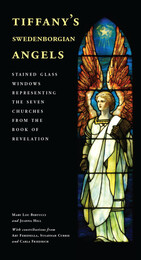 Tiffany's Swedenborgian Angels: Stained Glass Windows Representing the Seven Churches from the Book of Revelation
Mary Lou Bertucci
Swedenborg Foundation Publishers, 2011 In 2001, a Swedenborgian minister found a set of seven magnificent stained-glass windows stored in old crates in a barn in rural Pennsylvania. Their story illuminates a fascinating facet of American art history as well as an important set of spiritual teachings. In 1902, a Swedenborgian church in Glendale, Ohio, commissioned the seven windows as a gift for their sister church in Cincinnati. Each window depicts an angel that represents one of the seven churches described in the book of Revelation. The windows were designed and created in the studios of Louis Comfort Tiffany, and they reflect not only the rich symbolism found in the Bible, but Tiffany’s hallmark color and brilliance. Tiffany’s love of revealing angels in stained glass shines through in every panel. After their original home was torn down in 1964, the windows were put into storage, only to be rediscovered and painstakingly restored years later. Now a traveling exhibition, the seven angels have been given a new life as shining examples of Tiffany’s art and as a focus for spiritual reflection and meditation. Tiffany’s Swedenborgian Angels guides the reader not only through the history of the windows, but the spiritual meaning of each one, weaving Swedenborg’s teachings with the luminous imagery of the angels themselves. If you have seen the exhibition, the book allows you to revisit the windows again any time; if you have not, it is a powerful introduction to a vivid piece of spiritual history.
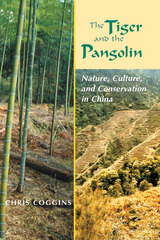 The Tiger and the Pangolin: Nature, Culture, and Conservation in China
Chris Coggins
University of Hawaii Press, 2003 This original and wide-ranging work examines historical perceptions of nature in China and the relationship between insider and outsider, state and village, top-down conservation policy and community autonomy. After an introduction to the history of wildlife conservation and nature reserve management in China, the book places recent tiger conservation efforts in the context of a two-thousand-year gazetteer of tiger attacks--the longest running documentation of human-wildlife encounters for any region in the world. This record offers a unique perspective on the history of the tiger as a dynamic force in the political culture of China. While the tiger has long been identified with political authority, the Chinese pangolin and its earthly magic have exerted a powerful influence in the everyday lives of those working and living in the fields and forests. Today the tiger and the pangolin, government officials and village communities, must work together closely if wildlife habitat conservation programs are to succeed. Extensive fieldwork in the Meihuashan Nature Reserve and other protected areas of western Fujian have led the author to advocate a landscape ecological approach to habitat conservation. By linking economic development to land use practices, he makes a strong case for integrating nature conservation efforts with land tenure and other socio-ecological issues in China and beyond.
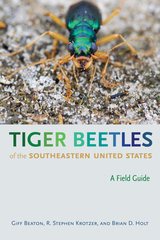 Tiger Beetles of the Southeastern United States: A Field Guide
Giff Beaton, R. Stephen Krotzer, and Brian D. Holt
University of Alabama Press, 2021 Combines current data and taxonomic classifications for tiger beetles in the Southeast with stunning close-up photographs, flight season charts, and distribution maps
Tiger beetles are brightly colored and metallic beetles, often with ivory or cream-colored markings. They are most abundant and diverse in habitats near bodies of water with sandy or clay soils and can be found along rivers, on sea and lake shores, on sand dunes, around dry lakebeds, on clay banks, or on woodland paths. Conservatively estimated, the group comprises more than 2,600 species worldwide.
Tiger Beetles of the Southeastern United States identifies and describes 52 taxa (42 species and 10 additional subspecies) of tiger beetles that occur in Alabama, Florida, Georgia, Mississippi, North Carolina, South Carolina, and Tennessee. Stunning close-up photographs accompany current taxonomic and biological information in a volume designed for a growing audience of enthusiastic amateurs and professionals alike.
The authors provide an in-depth description of the anatomy, life cycle, and behavior of tiger beetles; an overview of the various southeastern habitats in which they occur; instructions for finding, identifying, and photographing them in the wild; and the conservation status of various species. The individual species accounts include stunning, detailed images, flight season charts, county-level regional distribution maps, and discussion of identifying features, habitat, similar species, and subspecies when applicable. The appendix includes two species previously found in Florida but no longer known to exist there.
The result is the most complete field guide to date on tiger beetles in the region. With more than 230 images of beetles and their habitats, as well as life history and distribution data, this book is essential for tiger beetle enthusiasts, naturalists of all kinds, photographers, biologists, and teachers throughout the region.
 Tiger Bone & Rhino Horn: The Destruction of Wildlife for Traditional Chinese Medicine
Richard Ellis
Island Press, 2005 In parts of Korea and China, moon bears, black but for the crescent-shaped patch of white on their chests, are captured in the wild and brought to "bear farms" where they are imprisoned in squeeze cages, and a steel catheter is inserted into their gall bladders. The dripping bile is collected as a cure for ailments ranging from an upset stomach to skin burns. The bear may live as long as fifteen years in this state. Rhinos are being illegally poached for their horns, as are tigers for their bones, thought to improve virility. Booming economies and growing wealth in parts of Asia are increasing demand for these precious medicinals. Already endangered species are being sacrificed for temporary treatments for nausea and erectile dysfunction. Richard Ellis, one of the world's foremost experts in wildlife extinction, brings his alarm to the pages of Tiger Bone & Rhino Horn, in the hope that through an exposure of this drug trade, something can be done to save the animals most direly threatened. Trade in animal parts for traditional Chinese medicine is a leading cause of species endangerment in Asia, and poaching is increasing at an alarming rate. Most of traditional Chinese medicine relies on herbs and other plants, and is not a cause for concern. Ellis illuminates those aspects of traditional medicine, but as wildlife habitats are shrinking for the hunted large species, the situation is becoming ever more critical. One hundred years ago, there were probably 100,000 tigers in India, South China, Sumatra, Bali, Java, and the Russian Far East. The South Chinese, Caspian, Balinese, and Javan species are extinct. There are now fewer than 5,000 tigers in all of India, and the numbers are dropping fast. There are five species of rhinoceros--three in Asia and two in Africa--and all have been hunted to near extinction so their horns can be ground into powder, not for aphrodisiacs, as commonly thought, but for ailments ranging from arthritis to depression. In 1930, there were 80,000 black rhinos in Africa. Now there are fewer than 2,500. Tigers, bears, and rhinos are not the only animals pursued for the sake of alleviating human ills--the list includes musk deer, sharks, saiga antelope, seahorses, porcupines, monkeys, beavers, and sea lions--but the dwindling numbers of those rare species call us to attention. Ellis tells us what has been done successfully, and contemplates what can and must be done to save these animals or, sadly, our children will witness the extinction of tigers, rhinos, and moon bears in their lifetime.
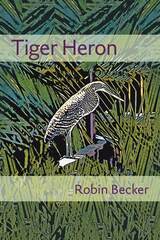 Tiger Heron
Robin Becker
University of Pittsburgh Press, 2014 Appearance and disguise—in a Costa Rican rainforest, a West Village repair shop, or an intimate relationship—reveal the turbulence that undergirds daily life, as families and places undergo change. In "Elegy for the Norther Flying Squirrel" and "Divers," Becker takes up the science of climate change and habitat loss. "Language that is by turns virtuosic and quiet, astonishing and accurate," writes a reviewer of Becker's 2006 collection, Domain of Perfect Affection for Jewish Book World Magazine. The challenge of "aligning loss with love" exerts a potent tension in Tiger Heron, as age comprises mortal bodies and intimacies end. A self-mocking wit propels characters "to find and lose and find each other again"—in the imagination and in the stories these poems tell. The final line of "The Sounds of Yiddish"—"Spare us what we can learn to endure"—closes a playful send-up, dramatizing language, culture, and power. Writing in The Washington Post, former U.S. Poet Laureate Robert Pinsky praises Becker's "comic timing." Longtime readers of Becker's work will delight in poems cast in a variety of stanzas and experimental forms. Their occasions are diverse—an animal shelter, a failed trip to Venice, a hospice bedside—but Becker ultimately yokes a language of praise to our stumbling, humble, human efforts.
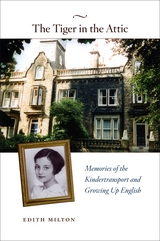 The Tiger in the Attic: Memories of the Kindertransport and Growing Up English
Edith Milton
University of Chicago Press, 2006 In 1939, on the eve of Hitler's invasion of Poland, seven-year-old Edith Milton (then Edith Cohn) and her sister Ruth left Germany by way of the Kindertransport, the program which gave some 10,000 Jewish children refuge in England. The two were given shelter by a jovial, upper-class British foster family with whom they lived for the next seven years. Edith chronicles these transformative experiences of exile and good fortune in The Tiger in the Attic, a touching memoir of growing up as an outsider in a strange land. In this illuminating chronicle, Edith describes how she struggled to fit in and to conquer self-doubts about her German identity. Her realistic portrayal of the seemingly mundane yet historically momentous details of daily life during World War II slowly reveals istelf as a hopeful story about the kindness and generosity of strangers. She paints an account rich with colorful characters and intense relationships, uncanny close calls and unnerving bouts of luck that led to survival. Edith's journey between cultures continues with her final passage to America—yet another chapter in her life that required adjustment to a new world—allowing her, as she narrates it here, to visit her past as an exile all over again. The Tiger in the Attic is a literary gem from a skilled fiction writer, the story of a thoughtful and observant child growing up against the backdrop of the most dangerous and decisive moment in modern European history. Offering a unique perspective on Holocaust studies, this book is both an exceptional and universal story of a young German-Jewish girl caught between worlds. “Adjectives like ‘audacious’ and ‘eloquent,’ ‘enchanting’ and ‘exceptional’ require rationing. . . . But what if the book demands these terms and more? Such is the case with The Tiger in the Attic, Edith Milton’s marvelous memoir of her childhood.”—Kerry Fried, Newsday
“Milton is brilliant at the small stroke . . . as well as broader ones.”—Alana Newhouse, New York Times Book Review
Tiger Moon: Tracking the Great Cats in Nepal
Fiona Sunquist and Mel Sunquist
University of Chicago Press, 2003 Tiger Moon is the powerful, poetic story of the Sunquists' two years studying tigers in Nepal—traveling by elephant, avoiding a rhino attack, and learning to recognize individual tigers by roar. A new afterword tells the story of promising efforts to reconnect fractured Nepalese tiger habitats.
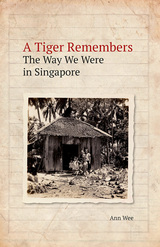 A Tiger Remembers: The Way We Were in Singapore
Ann Wee
National University of Singapore Press, 2017 Born in the Year of the Fire Tiger, Ann Wee moved to Singapore in 1950 to marry into a Singaporean Chinese family, entering into a new world of cultural expectations and domestic rituals. She went on to become a pioneer in Singapore’s fledging social welfare department and is often described as the founding mother of social work in Singapore. In A Tiger Remembers, she draws on her decades of experience getting to know the many shapes and forms of the Singapore family and witnessing how they transformed since the ’50s.
Wee’s talent is for remembering and paying homage to the things history books often deem insignificant—things that can contain some of the most illuminating details about the day to day inner workings of families from many backgrounds, such as terms of endearment; the emotional nuance in social relations; questions of hygiene; the stories of convicts; tales of ghost wives and changeling babies; anecdotes from rural clan settlements and migrant dormitories; and the migration of families from squatter settlements into public housing. Affectionately observed and wittily narrated, with a deep appreciation of how far Singapore has come, this book brings to life generations of social change through a focus on the institution of the family.
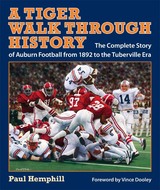 A Tiger Walk through History: The Complete Story of Auburn Football from 1892 to the Tuberville Era
Paul Hemphill
University of Alabama Press, 2008 In this lively and fascinating book, noted writer and Auburn alum Paul Hemphill tells the story of the progress of Auburn from that first game coached by Auburn legend George Petrie through the team’s growth and development into the national force it is today. Hemphill records the many highs and occasional lows, and the heartbreak and jubilation each caused, noting the standouts great and small on the way. A Tiger Walk through History contains 172 photographs, many of them rare and surprising. The text and photos capture the many great players and coaches in the Auburn football experience: Auburn’s first bowl appearance in 1936; coaching eras of innovative football genius John Heisman, after whom the Heisman trophy is named; “Iron Mike” Donahue; Ralph “Shug” Jordan, who brought Auburn its first national championship in 1957; Pat Dye, Terry Bowden, and present coach Tommy Tuberville; Auburn’s two Heisman trophy winners Pat Sullivan and Bo Jackson; and victories over rivals Alabama and Georgia. The 2007-2008 season is highlighted, including the sixth straight win over Alabama and a bowl victory over Clemson. As the game has grown, Auburn and its team have grown with it, and Auburn now ranks as a perennial power both in its conference and in the nation. Vince Dooley states in his foreword that “beyond the famous coaches and players and their heroics on behalf of the Orange and Blue, A Tiger Walk through History is also about time-honored traditions—rallying cries like ‘Sullivan-to-Beasley’ and ‘Punt Bama Punt’ and ‘Rolling Toomer’s Corner’—that echo in resounding fashion from the pages of Paul Hemphill’s remarkable book.” No fan, whether casual or devoted, can afford to miss this riveting account of the Plainsmen’s journey from the very beginning to today, which is the record of a great university as well as the story of the development of a great football team.
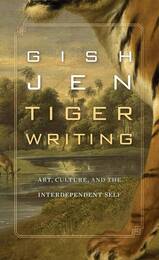 Tiger Writing: Art, Culture, and the Interdependent Self
Gish Jen
Harvard University Press, 2013 For author Gish Jen, the daughter of Chinese immigrant parents, books were once an Outsiders’ Guide to the Universe. But they were something more, too. Through her eclectic childhood reading, Jen stumbled onto a cultural phenomenon that would fuel her writing for decades to come: the profound difference in self-narration that underlies the gap often perceived between East and West.
Drawing on a rich array of sources, from paintings to behavioral studies to her father’s striking account of his childhood in China, this accessible book not only illuminates Jen’s own development and celebrated work but also explores the aesthetic and psychic roots of the independent and interdependent self—each mode of selfhood yielding a distinct way of observing, remembering, and narrating the world. The novel, Jen writes, is fundamentally a Western form that values originality, authenticity, and the truth of individual experience. By contrast, Eastern narrative emphasizes morality, cultural continuity, the everyday, the recurrent. In its progress from a moving evocation of one writer’s life to a convincing delineation of the forces that have shaped our experience for millennia, Tiger Writing radically shifts the way we understand ourselves and our art-making.
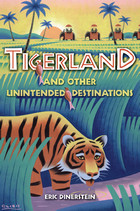 Tigerland and Other Unintended Destinations
Eric Dinerstein
Island Press, 2005 In 1972, Eric Dinerstein was in film school at Northwestern University, with few thoughts of nature, let alone tiger-filled jungles at the base of the Himalayas or the antelope-studded Serengeti plain. Yet thanks to some inspiring teachers and the squawk of a little green heron that awakened him to nature's fundamental wonders, Dinerstein would ultimately become a leading conservation biologist, traveling to these and other remote corners of the world to protect creatures ranging from the striking snow leopard to the homely wrinkle-faced bat. Tigerland and Other Unintended Destinations takes readers on Dinerstein's unlikely journey to conservation's frontiers, from early research in Nepal to recent expeditions as head of Conservation Science at the World Wildlife Fund. We are there as the author renews his resolve after being swept downstream on an elephant's back, tracks snow leopards in the mountains of Kashmir with a remarkable housewife turned zoologist, and finds unexpected grit in a Manhattanite donor he guides into the wildest reaches of the Orinoco River. At every turn, we meet professed and unprofessed ecologists who share
Dinerstein's mission, a cast of free-spirited characters uncommonly committed to-and remarkably successful at-preserving slices of the world's natural heritage. A simple sense of responsibility, one feels, shines through all of Dinerstein's experiences: not just to marvel at what we see, but to join in efforts sustain the planet's exquisite design. Tigerland's message is clear: individuals make all the difference; if we combine science, advocacy, and passion, ambitious visions for conservation can become reality-even against overwhelming odds.
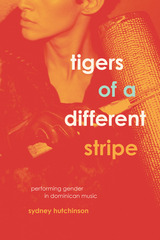 Tigers of a Different Stripe: Performing Gender in Dominican Music
Sydney Hutchinson
University of Chicago Press, 2016 Tigers of a Different Stripe takes readers inside the unique world of merengue típico, a traditional music of the Dominican Republic. While in most genres of Caribbean music women usually participate as dancers or vocalists, in merengue típico they are more often instrumentalists and even bandleaders—something nearly unheard of in the macho Caribbean music scene. Examining this cultural phenomenon, Sydney Hutchinson offers an unexpected and fascinating account of gender in Dominican art and life.
Drawing on over a decade of fieldwork in the Dominican Republic and New York among musicians, fans, and patrons of merengue típico—not to mention her own experiences as a female instrumentalist—Hutchinson details a complex nexus of class, race, and artistic tradition that unsettles the typical binary between the masculine and feminine. She sketches the portrait of the classic male figure of the tíguere, a dandified but sexually aggressive and street-smart “tiger,” and she shows how female musicians have developed a feminine counterpart: the tíguera, an assertive, sensual, and respected female figure who looks like a woman but often plays and even sings like a man. Through these musical figures and studies of both straight and queer performers, she unveils rich ambiguities in gender construction in the Dominican Republic and the long history of a unique form of Caribbean feminism.
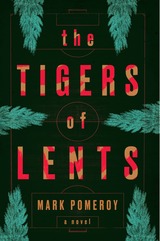 The Tigers of Lents
Mark Pomeroy
University of Iowa Press, 2024 2025 National Indie Excellence Award Finalist, Literary Fiction
2025 Independent Publishers Book Awards (IPPY Awards) gold medalist, Best Regional Fiction: West-Pacific
This is the story of the Garrison family, who live in Lents, an outer neighborhood of Portland, Oregon. At the heart of it all, there are the three Garrison sisters: Sara, the eldest, a fiery soccer star on the precipice of pulling herself out of the life of poverty she’s always known; Elaine, shy and struggling with the weight she carries both physically and mentally; and Rachel, a reader and poet whose imagination stalls at trying to picture a better life.
As the Garrisons struggle to communicate with each other, as they battle self-doubts and self-sabotage, they too draw on a fierce shared strength that allows them to push back at the reality that’s been handed to them. Each Garrison fights to hold on to their dignity—often through daily acts of grace and good humor, to say nothing of quiet perseverance—and to prove to themselves and each other that they shouldn’t be underestimated.
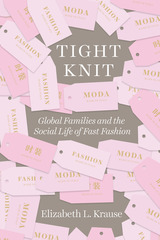 Tight Knit: Global Families and the Social Life of Fast Fashion
Elizabeth L. Krause
University of Chicago Press, 2018 The coveted “Made in Italy” label calls to mind visions of nimble-fingered Italian tailors lovingly sewing elegant, high-end clothing. The phrase evokes a sense of authenticity, heritage, and rustic charm. Yet, as Elizabeth L. Krause uncovers in Tight Knit, Chinese migrants are the ones sewing “Made in Italy” labels into low-cost items for a thriving fast-fashion industry—all the while adding new patterns to the social fabric of Italy’s iconic industry.
Krause offers a revelatory look into how families involved in the fashion industry are coping with globalization based on longterm research in Prato, the historic hub of textile production in the heart of metropolitan Tuscany. She brings to the fore the tensions—over value, money, beauty, family, care, and belonging—that are reaching a boiling point as the country struggles to deal with the same migration pressures that are triggering backlash all over Europe and North America. Tight Knit tells a fascinating story about the heterogeneity of contemporary capitalism that will interest social scientists, immigration experts, and anyone curious about how globalization is changing the most basic of human conditions—making a living and making a life.
Tight Spaces
Kesho Scott
University of Iowa Press, 1999 This expanded edition of Tight Spaces includes six new essays that explore the fulfilling spaces inhabited by Kesho Scott, Cherry Muhanji, and Egyirba High since their book was originally published in 1987. Tight Spaces won the American Book Award in 1988.
Tiglath-pileser III, Founder of the Assyrian Empire
Josette Elayi
SBL Press, 2022 Most modern historians consider Tiglath-pileser III, king of Assyria, to be the true founder of the Assyrian Empire. In Josette Elayi's latest work, she takes up this issue in her biography and history of his reign (745-727 BCE). Elayi explores questions surrounding how Tiglath-pileser managed to expand the Assyrian Empire after a period of weakness, what effects Assyrian domination had on Israel and Judah, and how the two kingdoms' fates differed. Using archaeological and textual remains from the period, she completes her trilogy of biographies, which includes Tiglath-pileser's successors, son Sargon II and grandson Sennacherib, who later led the Assyrian Empire to its greatest heights. Elayi provides yet another essential resource for scholars and students of Assyrian history and the Hebrew Bible.
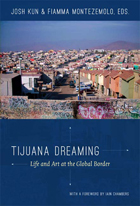 Tijuana Dreaming: Life and Art at the Global Border
Josh Kun and Fiamma Montezemolo, eds.
Duke University Press, 2012 Tijuana Dreaming is an unprecedented introduction to the arts, culture, politics, and economics of contemporary Tijuana, Mexico. With many pieces translated from Spanish for the first time, the anthology features contributions by prominent scholars, journalists, bloggers, novelists, poets, curators, and photographers from Tijuana and greater Mexico. They explore urban planning in light of Tijuana's unique infrastructural, demographic, and environmental challenges. They delve into its musical countercultures, architectural ruins, cinema, and emergence as a hot spot on the international art scene. One contributor examines fictional representations of Tijuana's past as a Prohibition-era "city of sin" for U.S. pleasure seekers. Another reflects on the city's recent struggles with kidnappings and drug violence. In an interview, Néstor García Canclini revisits ideas that he advanced in Culturas híbridas (1990), his watershed book about Latin America and cultural hybridity. Taken together, the selections present a kaleidoscopic portrait of a major border city in the age of globalization. Contributors. Tito Alegría, Humberto Félix Berumen, Roberto Castillo Udiarte, Iain Chambers, Luis Humberto Crosthwaite, Teddy Cruz, Ejival, Tarek Elhaik, Guillermo Fadanelli, Néstor García Canclini, Ingrid Hernández, Jennifer Insley-Pruitt, Kathryn Kopinak, Josh Kun, Jesse Lerner, Fiamma Montezemolo, Rene Peralta, Rafa Saavedra, Lucía Sanromán, Santiago Vaquera-Vásquez, Heriberto Yépez
The Tiki King: Stories
Stacy Tintocalis
Ohio University Press, 2010 A Lebanese housewife, a former horror-film maker, and a cantankerous Russian librarian are among the inhabitants of the offbeat world found in this impressive debut collection. Stacy Tintocalis’s stories take us from a defunct women’s shelter off a Missouri country road to the streets of low-income Hollywood, where her characters yearn for the love that is always just out of reach. The title story explores the conflicted emotions an adolescent boy feels toward a father who obsessively returns to his childhood home. In “Too Bad about Howie,” a divorced poet finds comfort in stolen moments with his ex-wife’s dog. Despite their longing for connection, these characters are victims of their own foibles, trapped in terrifying moments of psychic violence that risk driving away the very people they love.
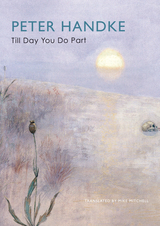 Till Day You Do Part Or A Question of Light
Peter Handke
Seagull Books, 2010 Described as an answer to or at least an echo of Samuel Beckett’s Krapp’s Last Tape?, Till Day You Do Part Or A Question of Light, by esteemed Austrian playwright and novelist Peter Handke, is a monologue delivered by the “she” in Beckett’s play. This unnamed female similarly recalls other significant women protagonists in Handke’s own work such as The Left-handed Woman. Handke prefaces the monologue in Till Day You Do PartOr a Question of Light with a description of two stone figures. While the male figure remains “as dead and gone as anyone can,” the female bursts into life, and her monologue gradually focuses on Krapp’s use of pauses and language to dominate the other characters in the Beckett play. Ultimately, however, her complaints and critique of Krapp become a declaration of her love for Krapp or at least an affirmation of their attachment, as the two of them are ultimately bound together, perhaps even inseparable.
Till Day You Do Part Or a Question of Light is Handke at his best, evidencing the great skill, psychological acumen, and vision for which his work has been celebrated.
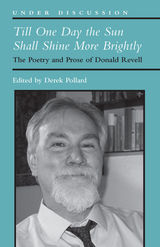 Till One Day the Sun Shall Shine More Brightly: The Poetry and Prose of Donald Revell
Derek Pollard, Editor
University of Michigan Press, 2020 Since the publication of From the Abandoned Cities in 1983, Donald Revell has been among the more consistent influencers in American poetry and poetics. Yet, his work has achieved the status it has—his honors include fellowships from the National Endowment for the Arts and the Guggenheim Foundation and awards from the PEN Center USA and American Poetry Review—in a manner that has often tended to belie its abiding significance. This collection of essays, reviews, and interviews is designed to ignite a more wide-ranging critical appraisal of Revell’s writing, from his fourteen collections of poems to his acclaimed translations of French symbolist and modernist poets to his artfully constructed literary criticism. Contributors such as Marjorie Perloff, Stephanie Burt, Dan Beachy-Quick, and Bruce Bond examine key elements in and across Revell’s work, from his visionary postmodernism (“Our words can never say the mystery of our meanings, but there they are: spoken and meaning worlds to us”) to his poetics of radical attention (“And so a poem has nothing to do with picking and choosing, with the mot juste and reflection in tranquility. It is a plain record of one’s entire presence”), in order to enlarge our understanding of how and why that work has come to occupy the place that it has in contemporary American letters.
Till The Break of Day: A History of Mental Health Services in Singapore, 1841-1993
Ng Beng Yeong
National University of Singapore Press, 2017 This book documents the development of psychiatry in Singapore since its humble beginnings in the British colonial period. It should be of interest to health professionals, medical students, historians interested in the development of medicine and psychiatry and even members of the public with some basic understanding of psychiatry and psychology. Relatives and caregivers of psychiatric patients would also find the information furnished in this book enlightening.
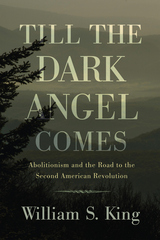 Till the Dark Angel Comes: Abolitionism and the Road to the Second American Revolution
William S. King
Westholme Publishing, 2016 The Transformation of the Abolitionist Movement from Peaceful Demonstration to Radical Confrontation as Embodied in John Brown
Establishing himself as a fresh and important voice in the history of African American emancipation,William S. King provides a critical introduction to the lead-up to the Civil War. A skilled and judicious chronicler, King seamlessly weaves multiple and seemingly disparate threads, including early nineteenth-century Revivalism, the emergence of the Republic of Texas, the fugitive slave laws—and even the explosion of a cannon aboard the U.S.S. Princeton in 1844—to explain how the opposition to slavery in America changed from producing speeches and pamphlets to embracing the reality that slavery could be eradicated only through armed conflict. By tracing this transformation through the life of John Brown, King provides an entirely new assessment of this enigmatic figure who was characterized as a “mad man” in the wake of his butchering of proslavery settlers in Kansas and the inept raid on Harpers Ferry, Virginia. King puts these actions in context to explain the paradox of Brown’s legacy. On one hand he was vilified as an unstable threat to American democracy or a fanatical sideshow to the history of the Civil War, while on the other he was an inspiration to the oppressed, a man who garnered the indomitable Harriet Tubman’s commitment to the righteousness of his endeavor.
Elegantly written with a command of period sources, Till the Dark Angel Comes: Abolitionism and the Road to the Second American Revolution is the story of interracial opposition to slavery, the important debates among free blacks as to their future in America, and the arguments and compromises at the highest levels of government. Here we encounter many personalities of the time, some well known, such as Frederick Douglass,William Lloyd Garrison, and John C. Calhoun, and others less so, but no less important—Martin Delany, Henry Highland Garnet, and Elijah Lovejoy.
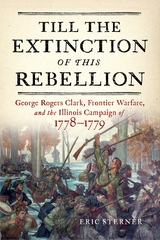 Till the Extinction of This Rebellion: George Rogers Clark, Frontier Warfare, and the Illinois Campaign of 1778–1779
Eric Sterner
Westholme Publishing, 2024 TIn late 1778, leading a small force of one hundred and fifty men, George Rogers Clark entered the Illinois Country where they would capture Great Britain’s major posts along the Mississippi and take British lieutenant governor Henry Hamilton prisoner to achieve one of the most singular victories during the American Revolution. Having suffered at the hands of British-supported Native American raids in Kentucky, Clark and his men embraced a confrontational approach, lumping all Native American nations together as inveterate blood enemies. For years, Clark’s daring achievement was lionized as the embodiment of American initiative. Now, in light of Clark’s treatment and participation in the subjugation of Native peoples, his legacy has reversed, with his statue at the University of Virginia recently being removed. His lack of nuance led him to misinterpret Indian responses to his military campaign and conclude that his approach produced results. In fact, many Native American nations simply used the American presence on the Mississippi to extort greater support from the British. In Till the Extinction of This Rebellion: George Rogers Clark, Frontier Warfare, and the Illinois Campaign of 1778–1779 Eric Sterner views the campaign from the American, British, and Indigenous perspectives and illustrates the wide geographic impact of the American Revolution west of the Appalachians, particularly on the French and Native American communities in the area.
Clark’s expedition was sanctioned by Virginia in order to protect its western border, and the author provides an overview of this rationale along with the strategies, tactics, and logistics Clark employed, particularly his ability to operate over great distances in remote areas. In particular, the author pays close attention to the psychological battlefield and how Clark combined mobility, surprise, and a calculated reputation for violence—a tactic respected by the Native peoples—to achieve dominance over his adversaries, often enabling the Americans to achieve their goals without harming anyone. The book culminates with the capture of Fort Sackville/Vincennes, in which Clark and his men fought the only pitched battle of the Illinois Campaign. The resounding success of Clark’s expedition laid the foundation for credible American postwar claims to lands as far west as the Mississippi, opening even more territory to new settlements at the expense of the Native peoples. Till the Extinction of This Rebellion is an important contribution to understanding the impact of the American Revolution on both Native peoples and westward expansion.
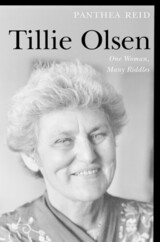 Tillie Olsen: One Woman, Many Riddles
Reid, Panthea
Rutgers University Press, 2011 In Tillie Olsen: One Woman, Many Riddles, Panthea Reid examines the complex life of this iconic feminist hero and twentieth-century literary giant. Born in Omaha, Nebraska, Tillie Olsen spent her young adulthood there, in Kansas City, and in Faribault, Minnesota. She relocated to California in 1933 and lived most of her life in San Francisco. From 1962 on, she sojourned frequently in Massachusetts, New Hampshire, Santa Cruz, and Soquel, California. She was a 1920s "hell-cat"; a 1930s revolutionary; an early 1940s crusader for equal pay for equal work and a war-relief patriot; an ex-GI's ideal wife in the later 1940s; a victim of FBI surveillance in the 1950s;a civil rights and antiwar advocate during the 1960s and 1970s; and a life-long orator for universal human rights. The enigma of Tillie Olsen is intertwined with that of the twentieth century. From the rebellions in Czarist Russia, through the terrors of the Depression and the hopes of the New Deal, to World War II, the Nuremberg Trials, and the United Nations' founding, to the cold war and House Un-American Activities Committee hearings, to later progressive and repressive movements, the story of Olsen's life brings remote events into focus. In her classic short story "I Stand Here Ironing" and her groundbreaking Tell Me a Riddle, Yonnondido, and Silences, Olsen scripted powerful, moving prose about ordinary people's lives, exposing the pervasive effects of sexism, racism, and classism and elevating motherhood and women's creativity into topics of study. Popularly referred to as "Saint Tillie," Olsen was hailed by many as the mother of modern feminism. Based on diaries, letters, manuscripts, private documents, resurrected public records, and countless interviews, Reid's artfully crafted biography untangles some of the puzzling knots of the last century's triumphs and failures and speaks truth to legend, correcting fabrications and myths about and also by Tillie Olsen.
 Tilt / Beautiful People
Denise Duhamel, Maureen Seaton, and Aaron Smith
Bridwell Press, 2024 Tilt / Beautiful People brings to life two innovative poetry books integrated into one.
In Tilt, Denise Duhamel and Maureen Seaton (1947-2023) write through climate change, Maureen’s illness, and the pandemic with their signature wit and poignancy. Their feminist curiosity leads them to poems about gender identity, marriage equality, and the complexities of national politics. Assembled shortly before Maureen’s death, the poems in Tilt tell the story of a friendship rooted in collaborative artistic play. The title of the book gives a nod to the earth’s tilt, which gives us seasons, but also hints that the poems were written at full tilt, these poets hyperaware they only had so much time left to write with one another.
Beautiful People was written back and forth over the course of several months by poets Maureen Seaton and Aaron Smith. Bold and inventive, it moves from sonnets and sestinas to prose poems and so much more. While its center is a love for poetry and art and laughter, the poets also grapple with mortality, sadness, and what it means to be alive on a broken but beautiful planet. Through their literary friendship, they put a mirror to all our lovely faces.
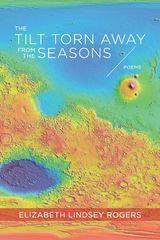 The Tilt Torn Away from the Seasons: Poems
Elizabeth Lindsey Rogers
Acre Books, 2020 The Tilt Torn Away from the Seasons imagines a human mission to Mars, a consequence of Earth’s devastation from climate change and natural disaster. As humans begin to colonize the planet, history inevitably repeats itself. Dystopian and ecopoetic, this collection of poetry examines the impulse and danger of the colonial mindset, and the ways that gendered violence and ecological destruction, body and land, are linked. “This time we’ll form more carefully,” one voice hopes in “Ecopoiesis: The Terraforming.” “We’ve started on empty / plains. We’ll vaccinate. We’ll make the new deal fair.” But the new planet becomes a canvas on which the trespasses of the American Frontier are rehearsed and remade. Featuring a multiplicity of narratives and voices, this book presents the reader with sonnet crowns, application forms, and large-scale landscape poems that seem to float across the field of the page. With these unusual forms, Rogers also reminds us of previous exploitations on our own planet: industrial pollution in rural China, Marco Polo's racist accounts of the Batak people in Indonesia, and natural disasters that result in displaced refugees. Striking, thought-provoking, and necessary, The Tilt Torn Away from the Seasons offers a new parable for our modern times.
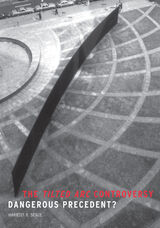 Tilted Arc Controversy: Dangerous Precedent
Harriet F. Senie
University of Minnesota Press, 2001
A comprehensive look at a controversy that continues to fuel debates about the role of public art in America.
Since its installation at and subsequent removal from New York City’s Federal Plaza, noted sculptor Richard Serra’s Tilted Arc has been a touchstone for debates over the role of public art. Installed in 1981, the 10-foot-high, 120-foot-long curved wall of Cor-Ten self-rusting steel instantly became a magnet for criticism. Art critics in the New York Times and the Village Voice labeled it the city’s worst public sculpture, and many denounced it as an example of the elitism associated with art and as an obstacle to the use and enjoyment of the plaza.
Harriet F. Senie explores the history of Tilted Arc, including its 1979 commission and the heated public hearings that eventually led to its removal in 1989 (it was dismantled and is currently stored in a government warehouse in Maryland). Analyzing the archive of popular opinion, Senie shows how the sculpture was caught in an avalanche of shifting local and national discussions about public funding for the arts. She examines the tactics of those opposed to the sculpture and the media’s superficial and sensational coverage of the controversy, reframing the dialogue in terms of public art, public space, and public policy instead of the question of whether the removal of Tilted Arc was poetic justice or a dangerous precedent. Senie provides an enlightening history and analysis of a controversy that will continue to inform our discussions about public art for years to come.
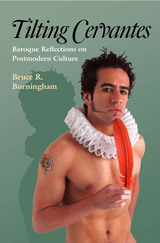 Tilting Cervantes: Baroque Reflections on Postmodern Culture
Bruce R. Burningham
Vanderbilt University Press, 2008 Tilting Cervantes examines several contemporary texts -- Fight Club, Brazil, The Matrix, and The Moor's Last Sigh, among others -- by reflecting them against a cluster of early modern Spanish and Latin American literary works, principally Don Quixote. Through a deliberate juxtaposition of these cross-cultural and cross-epochal texts, this book explores the notion that each of these varied cultural products can be read -in a very Borgesian manner- as precursors to each other, especially for contemporary readers who may not come to them in their "proper" chronological order. At the same time, and within this larger juxtaposition, this book examines the interrelated baroque and postmodern preoccupation with mirrors and self-reflexivity, and thus argues that many postmodern writers and performers do not so much break new ground as simply rediscover terrain already explored by such baroque literary figures as Cervantes, Lope de Vega, Francisco de Quevedo, and Sor Juana Ines de la Cruz.
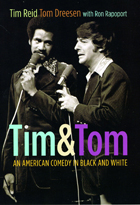 Tim and Tom: An American Comedy in Black and White
Tim Reid and Tom Dreesen with Ron Rapoport
University of Chicago Press, 2008
As the heady promise of the 1960s sagged under the weight of widespread violence, rioting, and racial unrest, two young men--one black and one white--took to stages across the nation to help Americans confront their racial divide: by laughing at it.
Tim and Tom tells the story of that pioneering duo, the first interracial comedy team in the history of show business--and the last. Tim Reid and Tom Dreesen polished their act in the nightclubs of Chicago, then took it on the road, not only in the North, but in the still-simmering South as well, developing routines that even today remain surprisingly frank--and remarkably funny--about race. Most nights, the shock of seeing an integrated comedy team quickly dissipated in uproarious laughter, but on some occasions the audience’s confusion and discomfort led to racist heckling, threats, and even violence. Though Tim and Tom perpetually seemed on the verge of making it big throughout their five years together, they grudgingly came to realize that they were ahead of their time: America was not yet ready to laugh at its own failed promise.
Eventually, the grind of the road took its toll, as bitter arguments led to an acrimonious breakup. But the underlying bond of friendship Reid and Dreesen had forged with each groundbreaking joke has endured for decades, while their solo careers delivered the success that had eluded them as a team. By turns revealing, shocking, and riotously funny, Tim and Tom unearths a largely forgotten chapter in the history of comedy.
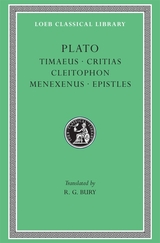 Timaeus. Critias. Cleitophon. Menexenus. Epistles
Plato
Harvard University Press On the creation of the world, and the destruction of Atlantis.
Plato, the great philosopher of Athens, was born in 427 BC. In early manhood an admirer of Socrates, he later founded the famous school of philosophy in the grove Academus. Much else recorded of his life is uncertain; that he left Athens for a time after Socrates’ execution is probable; that later he went to Cyrene, Egypt, and Sicily is possible; that he was wealthy is likely; that he was critical of “advanced” democracy is obvious. He lived to be 80 years old. Linguistic tests including those of computer science still try to establish the order of his extant philosophical dialogues, written in splendid prose and revealing Socrates’ mind fused with Plato’s thought.
In Laches, Charmides, and Lysis, Socrates and others discuss separate ethical conceptions. Protagoras, Ion, and Meno discuss whether righteousness can be taught. In Gorgias, Socrates is estranged from his city’s thought, and his fate is impending. The Apology (not a dialogue), Crito, Euthyphro, and the unforgettable Phaedo relate the trial and death of Socrates and propound the immortality of the soul. In the famous Symposium and Phaedrus, written when Socrates was still alive, we find the origin and meaning of love. Cratylus discusses the nature of language. The great masterpiece in ten books, the Republic, concerns righteousness (and involves education, equality of the sexes, the structure of society, and abolition of slavery). Of the six so-called dialectical dialogues Euthydemus deals with philosophy; metaphysical Parmenides is about general concepts and absolute being; Theaetetus reasons about the theory of knowledge. Of its sequels, Sophist deals with not-being; Politicus with good and bad statesmanship and governments; Philebus with what is good. The Timaeus seeks the origin of the visible universe out of abstract geometrical elements. The unfinished Critias treats of lost Atlantis. Unfinished also is Plato’s last work, Laws, a critical discussion of principles of law which Plato thought the Greeks might accept.
The Loeb Classical Library edition of Plato is in twelve volumes.
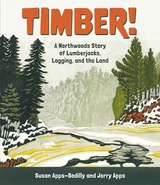 Timber!: A Northwoods Story of Lumberjacks, Logging, and the Land
Susan Apps-Bodilly
Wisconsin Historical Society Press, 2024 A heavily illustrated children’s history of the logging boom in the 19th century and the conservation efforts that followed.
How did the logging boom begin? What was it like to work in the woods? What happened to the land after the trees were cut down? The latest book for young readers from father-daughter duo Jerry Apps and Susan Apps-Bodilly explores the origin story of Wisconsin’s logging boom, the devastation it caused to the land, and the extraordinary efforts to restore the cutover land and log sustainably.
Timber! helps young readers examine a complex and pivotal chapter in our state and nation’s history, covering a wide range of topics, including:
• how Native people used, shared, and relied on natural resources for thousands of years
• the forced removal of Native people from forested lands
• how the lumber industry made possible the westward expansion of the United States
• what it was like to work in a logging camp, on a log drive, and inside a sawmill
• the roles on a logging team, from sawyer to cook
• the destructive legacy of early logging practices and early efforts to restore the land
• the emergence of sustainable forestry practices
This comprehensive yet easy-to-read history includes letters, postcards, and other primary sources paired with discussion questions designed to engage young readers’ creativity and critical-thinking skills. Timber! also features more than 100 images, a glossary, suggested activities, and an extensive list of related resources, including books, websites, teaching materials, museums, and outdoor places to visit. Timber! will inspire readers of all ages to explore, protect, and learn about trees and forests in their own communities.
Timber and Prayer: The Indian Pond Poems
Afaa Michael Weaver
University of Pittsburgh Press, 1995 "Weaver's life studies and lyrics are imbued with a vivid sense of language, a vivid sense of the world, a vivid sense of their inseparability. And his tonal range—from unabashed passion to the subtlest velleity—is impressive indeed. This is a singular talent."—Henry Louis Gates, Jr.
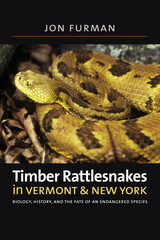 Timber Rattlesnakes in Vermont & New York: Biology, History, and the Fate of an Endangered Species
Jon Furman
University Press of New England, 2007 Today, small populations of timber rattlesnakes (Crotalus horridus) quietly inhabit parts of Rutland County in Vermont, and Warren, Washington, and Essex counties in New York. Because the species is endangered, the exact locations of established dens in this area are a closely guarded secret. Insider, naturalist, and author Jon Furman has devoted years to the study of the snake’s past and present range, its habitat and biology, the period in Vermont and upstate New York history during which timber rattlesnakes were ruthlessly hunted for a bounty, and the outlook for this severely threatened species in both states. Soundly anchored in the latest scientific data, Furman proffers an accessible and engaging account of contemporary fieldwork and first-person interviews with herpetologists and old-time bounty hunters. For expert and lay readers interested in snakes and reptiles, northeastern fauna and natural history, conservation, and endangered species, this volume clearly explicates the timber rattlesnake’s biology as well as what happens and what to do when one bites. It also explores the troubling decline of the northeastern population caused by bounty hunting between the 1890s and the early 1970s, other past and present threats to the species’ survival, and what measures are being taken—and additional ones that must be taken—to ensure that timber rattlesnakes survive and thrive in the northeast. Historical and contemporary illustrations bring these reptiles and their world to life. Timber Rattlesnakes in Vermont & New York shines a new light on a maligned and misunderstood species.
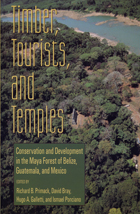 Timber, Tourists, and Temples: Conservation And Development In The Maya Forest Of Belize Guatemala And Mexico
Edited by Richard B. Primack, David Bray, Hugo A. Galletti, and Ismael Ponciano
Island Press, 1998 Stretching across southern Mexico, northern Guatemala, and Belize, the Maya Forest, or Selva Maya, constitutes one of the last large blocks of tropical forest remaining in North and Central America. Home to Mayan-speaking people for more than 5,000 years, the region is also uncommonly rich in cultural and archaeological resources. Timber, Tourists, and Temples brings together the leading biologists, social scientists, and conservationists working in the region to present in a single volume information on the intricate social and political issues, and the complex scientifc and management problems to be resolved there. Following an introductory chapter that presents GIS and remote sensing data, the book: considers perspectives on managing forest resources and the forestry and conservation policies of each nation examines efforts by communities to manage their forest resources explains the connections between resource conservation and use by local people highlights research projects that integrate baseline biological research with impact assessments explains the need to involve local people in conservation effort Timber, Tourists, and Temples explores methods of supporting the biological foundation of the Maya Forest and keeping alive that unique and diverse ecosystem. While many areas face similar development pressures, few have been studied as much or for as long as the Maya Forest. The wealth of information included in this pathbreaking work will be valuable not only for researchers involved with the Maya Forest but for anyone concerned with the protection, use, and management of tropical forest ecosystems throughout the world.
Timberline Tailings: Tales Of Colorado'S Ghost Towns And Mining Camps
Muriel Sibell Wolle
Ohio University Press, 1993 “Timberline Tailings is a follow-up volume which the author published in 1977, after years of receiving letters from people who related their own stories, directions and data about Colorado mining camps after reading Stampede to Timberline. — Sn3 Modeler
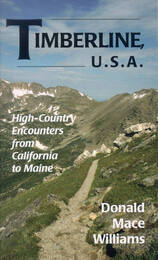 Timberline U.S.A.: High-Country Encounters from California to Maine
Donald Mace Williams
Utah State University Press, 2003 As a youth in Denver, Donald Mace Williams developed an affection for high mountain country. After a journalistic career spent mostly on flat lands, he set out to rediscover what was special about country above timberline. He hiked the high alpine in four of America's major ranges-the Rockies, Sierra Nevada, Cascades, and northern Appalachians-and in his narrative of his travels, he tells us what he saw and learned and who he met. Having visited some of these areas when younger, Williams compares his psychological and physical responses as an older man and how his ideas about how to treat the environment have evolved. A recurring theme is the compromises that people such as he make between the pull of mountains and freedom and the responsibilities of making a living in the lowlands. Mainly, he observes and experiences what is distinctive about the timberline environment. Throughout his book, Williams gently informs readers regarding timberline history, nature, weather, and archaeology; high altitude physiology; and environmental concerns. Frequently, he recounts encounters with interesting and varied people he meets on the trails: a young British hiking companion who has come back to Colorado to repeat a climb on which, a year previously, his two fellow climbers died; a pilot who climbs isolated peaks in the Sierra Nevada in search of bouillon-can scrolls signed by famous early mountaineers; a "Literate Farmer" who pauses on a mountain trail in Vermont to discuss Robert Frost. Donald Mace Williams is a retired journalist who has worked for such newspapers as The Wichita Eagle, Newsday, and the Fort Worth Star-Telegram. He has a Ph.D. in English from the University of Texas, has published one previous book (Interlude in Umbarger: Italian POWs and a Texas Church); poems in Western Humanities Review, Iron Horse Literary Review, and South Dakota Review; and a short story in Southwest Review. He now lives in Texas.
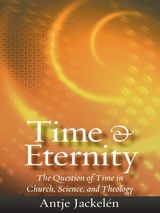 Time & Eternity: The Question of Time in Church, Science and Theology
Antje Jackelen
Templeton Press, 2005
What is time? Is there a link between objective knowledge about time and subjective experience of time? And what is eternity? Does religion have the answer? Does science?
Internationally known scholar Antje Jackelén investigates the problem and concept of time. Her study draws on her experiences in the Continental-European science and religion dialogue, with a particular focus on the German, Scandinavian, and Anglo-American dialogues. Her analysis of the subject includes:
•The notion of time and eternity as it is narrated through Christian hymn books stemming from Germany, Sweden, and the English-speaking world, with insights into changes of the concept and understanding of time in Christian spirituality over the past few decades
•Theological approaches to time and eternity, as well as a look at Trinitarian theology and its relation to time
•The discussion of scientific theories of time, including Newtonian, relativistic, quantum, and chaos theories
•The formulation of a "theology of time," a theological-mathematical model incorporating relational thinking oriented toward the future, the doctrine of trinity, and the notion of eschatology
 Time and Chance
David Z Albert
Harvard University Press, 2000 This book is an attempt to get to the bottom of an acute and perennial tension between our best scientific pictures of the fundamental physical structure of the world and our everyday empirical experience of it. The trouble is about the direction of time. The situation (very briefly) is that it is a consequence of almost every one of those fundamental scientific pictures--and that it is at the same time radically at odds with our common sense--that whatever can happen can just as naturally happen backwards.
Albert provides an unprecedentedly clear, lively, and systematic new account--in the context of a Newtonian-Mechanical picture of the world--of the ultimate origins of the statistical regularities we see around us, of the temporal irreversibility of the Second Law of Thermodynamics, of the asymmetries in our epistemic access to the past and the future, and of our conviction that by acting now we can affect the future but not the past. Then, in the final section of the book, he generalizes the Newtonian picture to the quantum-mechanical case and (most interestingly) suggests a very deep potential connection between the problem of the direction of time and the quantum-mechanical measurement problem.
The book aims to be both an original contribution to the present scientific and philosophical understanding of these matters at the most advanced level, and something in the nature of an elementary textbook on the subject accessible to interested high-school students.
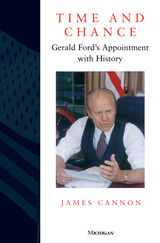 Time and Chance: Gerald Ford's Appointment with History
James Cannon
University of Michigan Press, 1998 Gerald Ford came to the presidency at the time of one of our nation's greatest constitutional crises, the downfall of President Richard M. Nixon in the aftermath of the Watergate affair. His service as president concluded a distinguished career in the House of Representatives during which he served as leader of the Republican Party in the House. With unrestricted access to Gerald Ford's papers, James M. Cannon tells the story of Ford's rise and Nixon's ruin, providing new insights into this troubling period of our history and Ford's role in guiding the nation through it. Cannon tells the story of Ford's difficult early life and the beginnings of his career in politics in the period immediately after World War II. He tells the story of Ford's rise to prominence in the House of Representatives during the 1950s and 1960s, giving us a fascinating picture of the Congress. In addition, in telling us about the personal life of Gerald Ford, he gives us a sense of the price Ford paid for his success.
"James Cannon, formerly national affairs editor at Newsweek and Ford's domestic policy advisor, has written a superbly provocative and arresting biography that traces Ford's life from his July 4, 1913, birth in Omaha, Nebraska, to his September 8,1974, decision to pardon Nixon of the Watergate conspiracy." --Washington Post Book World
James M. Cannon is a journalist and was Domestic Policy Adviser to President Ford and Chief of Staff to Senate Majority Leader Howard Baker.
Time and Change: 150 Years of The Ohio State University
Tamar Chute
Ohio State University Press, 2019 This photographic retrospective of The Ohio State University showcases its rich history and decades of growth, from its earliest years as the Ohio Agricultural and Mechanical College to the prominent land-grant institution it is today. The book includes more than three hundred rarely seen photographs from the collections of the University Archives and contemporary university photographers.
Gain a visually stunning new perspective on iconic landmarks such as Mirror Lake, the Oval, Ohio Stadium, and the neighborhoods surrounding the Columbus and regional campuses. From beloved teams, symbols, and traditions to scenes from academic and campus life, reflect on time and change and rediscover the extraordinary connection that unites generations of Buckeyes.
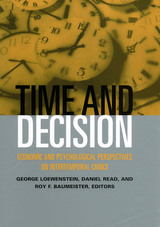 Time and Decision: Economic and Psychological Perspectives of Intertemporal Choice
George Loewenstein
Russell Sage Foundation, 2003 How do people decide whether to sacrifice now for a future reward or to enjoy themselves in the present? Do the future gains of putting money in a pension fund outweigh going to Hawaii for New Year's Eve? Why does a person's self-discipline one day often give way to impulsive behavior the next? Time and Decision takes up these questions with a comprehensive collection of new research on intertemporal choice, examining how people face the problem of deciding over time. Economists approach intertemporal choice by means of a model in which people discount the value of future events at a constant rate. A vacation two years from now is worth less to most people than a vacation next week. Psychologists, on the other hand, have focused on the cognitive and emotional underpinnings of intertemporal choice. Time and Decision draws from both disciplinary approaches to provide a comprehensive picture of the various layers of choice involved. Shane Frederick, George Loewenstein, and Ted O'Donoghue introduce the volume with an overview of the research on time discounting and focus on how people actually discount the future compared to the standard economic model. Alex Kacelnik discusses the crucial role that the ability to delay gratification must have played in evolution. Walter Mischel and colleagues review classic research showing that four year olds who are able to delay gratification subsequently grow up to perform better in college than their counterparts who chose instant gratification. The book also delves into the neurobiology of patience, examining the brain structures involved in the ability to withstand an impulse. Turning to the issue of self-control, Klaus Wertenbroch examines the relationship between consumption and available resources, showing, for example, how a high credit limit can lead people to overspend. Ted O'Donoghue and Matthew Rabin show how people's awareness of their self-control problems affects their decision-making. The final section of the book examines intertemporal choice with regard to health, drug addiction, dieting, marketing, savings, and public policy. All of us make important decisions every day-many of which profoundly affect the quality of our lives. Time and Decision provides a fascinating look at the complex factors involved in how and why we make our choices, so many of them short-sighted, and helps us understand more precisely this crucial human frailty.
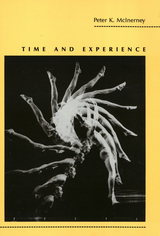 Time and Experience
Peter K. McInerney
Temple University Press, 1992 This book is the only contemporary, systematic study of the relationship of time and conscious experience. Peter K. Mclnerney examines three tightly interconnected issues: how we are able to be conscious of time and temporal entities, whether time exists independently of conscious experience, and whether the conscious experiencer exists in time in the same way that ordinary natural objects are thought to exist in time. Insight is drawn from the views of major phenomenological and existential thinkers on these issues. Building on a detailed explication and critique of the views of Kant, Husserl, Heidegger, and Sartre, Mclnerney develops and defends his own positions. He argues that a revised version of Husserl’s three-feature theory of time-consciousness provides the best explanation of our awareness of temporal features, but that an independently real time is necessary to explain our experience of temporal passage. He also shows that human existence has some special temporal features in addition to those it shares with other entities. Time-consciousness, the conscious exercise of powers, and personal identity through time require that any temporal part of human existence be defined by and "reach across" to earlier and later parts.
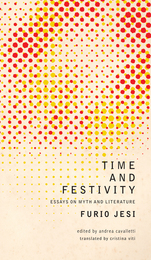 Time and Festivity
Furio Jesi
Seagull Books, 2018 One of the foremost thinkers of his generation, Furio Jesi began to publish scholarly essays in academic journals at the age of fifteen. By the time of his early death in 1980, he had accumulated a body of work that astonishes with its abundance and diversity, its depth and scope, and, above all, for its unfailing rigor and brilliance.
In Time and Festivity, Andrea Cavalletti collects Jesi’s finest essays, ranging from his groundbreaking work on myth and politics to his reflections on time, festivity, and revolt. He explores the significance of texts by Rimbaud, Rilke, Lukács, and Pavese and the mythological language of the biblical story of Susanna. Carefully annotated and referenced, and enriched by a first-person account of Jesi’s intellectual biography, Time and Festivity provides a precious guide to the methodology and approach at the core of Jesi’s thought, displaying how his personal, vitally intense via negativa might in fact originate from his early statement: “All I have ever written is poetry.”
Time and Freedom
Christophe Bouton
Northwestern University Press, 2014 Christophe Bouton's Time and Freedom addresses the problem of the relationship between time and freedom as a matter of practical philosophy, examining how the individual lives time and how her freedom is effective in time. Bouton first charts the history of modern philosophy's reengagement with the Aristotelian debate about future contingents, beginning with Leibniz. While Kant, Husserl, and their followers would engage time through theories of knowledge, Schopenhauer, Schelling, Kierkegaard, and (later), Heidegger, Sartre, and Levinas applied a phenomenological and existential methodology to time, but faced a problem of the temporality of human freedom. Bouton's is the first major work of its kind since Bergson's Time and Free Will (1889), and Bouton's "mystery of the future," in which the individual has freedom within the shifting bounds dictated by time, charts a new direction.
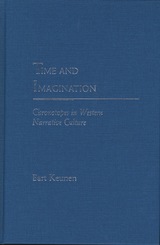 Time and Imagination: Chronotopes in Western Narrative Culture
Bart Keunen
Northwestern University Press, 2011 Bart Keunen’s boldly comprehensive theory of literature springs from the synthesis between narrative time and space forms called the chronotope (from the Greek chronos “time” and topos “place”). The originator of the theory, Mikhail Bakhtin, argued that each literary culture and each genre uses a family of chronotopes that endow the cultures and genres with their specific aesthetic charm, as well as their cognitive and moral strength.
After constructing an archeology of the chronotope, Keunen proposes a remarkably original description of the various types of chronotopes. Chronotypes that emphasize conflict are using Greek mythological names to explain equilibrium, or reconciliation, and conflict chronotopes. He then develops a plot typology that covers the whole history of Western narrative culture. With examples and resonances both ancient and modern, Keunen’s Time and Imagination will equip theorists in a wide range of fields with powerful tools for years to come.
 Time and Its Adversaries in the Seleucid Empire
Paul J. Kosmin
Harvard University Press, 2018 Winner of the Runciman Award
Winner of the Charles J. Goodwin Award
“Tells the story of how the Seleucid Empire revolutionized chronology by picking a Year One and counting from there, rather than starting a new count, as other states did, each time a new monarch was crowned…Fascinating.”
—Harper’s
In the aftermath of Alexander the Great’s conquests, his successors, the Seleucid kings, ruled a vast territory stretching from Central Asia and Anatolia to the Persian Gulf. In 305 BCE, in a radical move to impose unity and regulate behavior, Seleucus I introduced a linear conception of time. Time would no longer restart with each new monarch. Instead, progressively numbered years—continuous and irreversible—became the de facto measure of historical duration. This new temporality, propagated throughout the empire and identical to the system we use today, changed how people did business, recorded events, and oriented themselves to the larger world.
Some rebellious subjects, eager to resurrect their pre-Hellenic past, rejected this new approach and created apocalyptic time frames, predicting the total end of history. In this magisterial work, Paul Kosmin shows how the Seleucid Empire’s invention of a new kind of time—and the rebellions against this worldview—had far reaching political and religious consequences, transforming the way we organize our thoughts about the past, present, and future.
“Without Paul Kosmin’s meticulous investigation of what Seleucus achieved in creating his calendar without end we would never have been able to comprehend the traces of it that appear in late antiquity…A magisterial contribution to this hitherto obscure but clearly important restructuring of time in the ancient Mediterranean world.”
—G. W. Bowersock, New York Review of Books
“With erudition, theoretical sophistication, and meticulous discussion of the sources, Paul Kosmin sheds new light on the meaning of time, memory, and identity in a multicultural setting.”
—Angelos Chaniotis, author of Age of Conquests
Time And Myth: A Meditation on Storytelling as an Exploration of Life and Death
John S. Dunne
University of Notre Dame Press, 1975 Time and Myth analyzes man's confrontation with the inevitability of death in the cultural, personal, and religious spheres, viewing each as a particular kind of myth shaped by the impact of time. With penetrating simplicity the author poses the timeless dilemma of the human condition and seeks to resolve it through stories of adventures, journeys, and voyages inspired by man's encounter with death; stories of childhood, youth, manhood, and age; and, finally, stories of God and of man wrestling with God and the unknown.
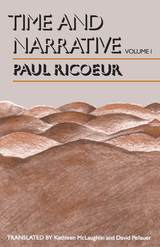 Time and Narrative, Volume 1
Paul Ricoeur
University of Chicago Press, 1990 Time and Narrative builds on Paul Ricoeur's earlier analysis, in The Rule of Metaphor, of semantic innovation at the level of the sentence. Ricoeur here examines the creation of meaning at the textual level, with narrative rather than metaphor as the ruling concern.
Ricoeur finds a "healthy circle" between time and narrative: time is humanized to the extent that it portrays temporal experience. Ricoeur proposes a theoretical model of this circle using Augustine's theory of time and Aristotle's theory of plot and, further, develops an original thesis of the mimetic function of narrative. He concludes with a comprehensive survey and critique of modern discussions of historical knowledge, understanding, and writing from Aron and Mandelbaum in the late 1930s to the work of the Annales school and that of Anglophone philosophers of history of the 1960s and 1970s.
"This work, in my view, puts the whole problem of narrative, not to mention philosophy of history, on a new and higher plane of discussion."—Hayden White, History and Theory
"Superb. . . . A fine point of entrance into the work of one of the eminent thinkers of the present intellectual age."—Joseph R. Gusfield, Contemporary Sociology
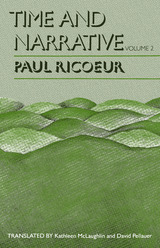 Time and Narrative, Volume 2
Paul Ricoeur
University of Chicago Press, 1990 In volume 1 of this three-volume work, Paul Ricoeur examined the relations between time and narrative in historical writing. Now, in volume 2, he examines these relations in fiction and theories of literature.
Ricoeur treats the question of just how far the Aristotelian concept of "plot" in narrative fiction can be expanded and whether there is a point at which narrative fiction as a literary form not only blurs at the edges but ceases to exist at all. Though some semiotic theorists have proposed all fiction can be reduced to an atemporal structure, Ricoeur argues that fiction depends on the reader's understanding of narrative traditions, which do evolve but necessarily include a temporal dimension. He looks at how time is actually expressed in narrative fiction, particularly through use of tenses, point of view, and voice. He applies this approach to three books that are, in a sense, tales about time: Virgina Woolf's Mrs. Dalloway; Thomas Mann's Magic Mountain; and Marcel Proust's Remembrance of Things Past.
"Ricoeur writes the best kind of philosophy—critical, economical, and clear."—Eugen Weber, New York Times Book Review
"A major work of literary theory and criticism under the aegis of philosophical hermenutics. I believe that . . . it will come to have an impact greater than that of Gadamer's Truth and Method—a work it both supplements and transcends in its contribution to our understanding of the meaning of texts and their relationship to the world."—Robert Detweiler, Religion and Literature
"One cannot fail to be impressed by Ricoeur's encyclopedic knowledge of the subject under consideration. . . . To students of rhetoric, the importance of Time and Narrative . . . is all too evident to require extensive elaboration."—Dilip Parameshwar Gaonkar, Quarterly Journal of Speech
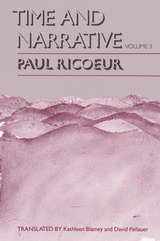 Time and Narrative, Volume 3
Paul Ricoeur
University of Chicago Press, 1990 In the first two volumes of this work, Paul Ricoeur examined the relations between time and narrative in historical writing, fiction, and theories of literature. This final volume, a comprehensive reexamination and synthesis of the ideas developed in volumes 1 and 2, stands as Ricoeur's most complete and satisfying presentation of his own philosophy.
Ricoeur's aim here is to explicate as fully as possible the hypothesis that has governed his inquiry, namely, that the effort of thinking at work in every narrative configuration is completed in a refiguration of temporal experience. To this end, he sets himself the central task of determing how far a poetics of narrative can be said to resolve the "aporias"—the doubtful or problematic elements—of time. Chief among these aporias are the conflicts between the phenomenological sense of time (that experienced or lived by the individual) and the cosmological sense (that described by history and physics) on the one hand and the oneness or unitary nature of time on the other. In conclusion, Ricoeur reflects upon the inscrutability of time itself and attempts to discern the limits of his own examination of narrative discourse.
"As in his previous works, Ricoeur labors as an imcomparable mediator of often estranged philosophical approaches, always in a manner that compromises neither rigor nor creativity."—Mark Kline Taylor, Christian Century
"In the midst of two opposing contemporary options—either to flee into ever more precious readings . . . or to retreat into ever more safe readings . . . —Ricoeur's work offers an alternative option that is critical, wide-ranging, and conducive to new applications."—Mary Gerhart, Journal of Religion
Time and the Digital: Connecting Technology, Aesthetics, and a Process Philosophy of Time
Timothy Scott Barker
Dartmouth College Press, 2012 Eschewing the traditional focus on object/viewer spatial relationships, Timothy Scott Barker’s Time and the Digital stresses the role of the temporal in digital art and media. The connectivity of contemporary digital interfaces has not only expanded the relationships between once separate spaces but has increased the complexity of the temporal in nearly unimagined ways. Invoking the process philosophy of Whitehead and Deleuze, Barker strives for nothing less than a new philosophy of time in digital encounters, aesthetics, and interactivity. Of interest to scholars in the fields of art and media theory and philosophy of technology, as well as new media artists, this study contributes to an understanding of the new temporal experiences emergent in our interactions with digital technologies.
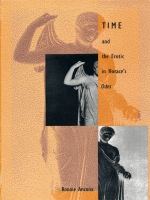 Time and the Erotic in Horace's Odes
Ronnie Ancona
Duke University Press, 1994 In Horace’s Odes love cannot last. Is the poet unromantic, as some critics claim? Is he merely realistic? Or is he, as Ronnie Ancona contends, relating the erotic to time in a more complex and interesting way than either of these positions allows? Rejecting both the notion that Horace fails as a love poet because he undermines the romantic ideal that love conquers time and the notion that he succeeds becauses he eschews illusions about love’s ability to endure, this book challenges the assumption that temporality must inevitably pose a threat to the erotic. The author argues that temporality, understood as the contingency the male poet/lover wants to but cannot control, explains why love "fails" in Horace’s Odes.
Drawing on contemporary theory, including recent work in feminist criticism, Ancona provides close readings of fourteen odes, which are presented in English translation as well as in Latin. Through a discussion of the poet’s use of various temporal devices—the temporal adverb, seasonal imagery, and the lover or beloved’s own temporality—she shows how Horace makes time dominate the erotic context and, further, how the version of love that appears in his poems is characterized by the lover’s desire to control the beloved. The romantic ideal of a timeless love, apparently rejected by the poet, emerges here instead as an underlying element of the poet’s portrayal of the erotic. In a critique of the predominant modes of recent Horatian scholarship on the love odes, Ancona offers an alternative view that takes into account the male gender of the lover and its effect on the structure of desire in the poems. By doing so, she advances a broader project in recent classical studies that aims to include discussion of features of classical literature, such as sexuality and gender, which have previously escaped critical attention.
Addressing aspects of Horace as a love poet—especially the dynamics of gender relations—that critics have tended to ignore, this book articulates his version of love as something not to be championed or condemned but rather to be seen as challengingly problematic. Of primary interest to classicists, it will also engage the attention of scholars and teachers in the humanities with specializations in gender, sexuality, lyric poetry, or feminist theory.
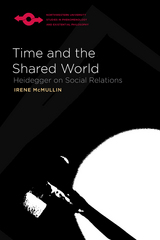 Time and the Shared World: Heidegger on Social Relations
Irene McMullin
Northwestern University Press, 2013 Time and the Shared World challenges the common view that Heidegger offers few resources for understanding humanity’s social nature. The book demonstrates that Heidegger’s reformulation of traditional notions of subjectivity has wide-ranging implications for understanding the nature of human relationships. Irene McMullin shows that, contrary to entrenched critiques, Heidegger’s characterization of selfhood as fundamentally social presupposes the responsive acknowledgment of each person’s particularity and otherness.
In doing so, McMullin argues that Heidegger’s work on the social nature of the self must be located within a philosophical continuum that builds on Kant and Husserl’s work regarding the nature of the a priori and the fundamental structures of human temporality, while also pointing forward to developments of these themes to be found in Heidegger’s later work and in such thinkers as Sartre and Levinas. By developing unrecognized resources in Heidegger’s work, Time and the Shared World is able to provide a Heidegger-inspired account of respect and the intersubjective origins of normativity.
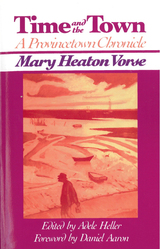 Time and the Town: A Provincetown Chronicle
Adele Heller
Rutgers University Press, 1991 Time and the Town was the last of Mary Heaton Vorse's books. It is about many things —a town and its people, the author, a certain kind of idyllic life. As much as anything else, it is the biography of the house Vorse bought in 1907 and lived in, off and on, for the next thirty-six years. The moods of the house mirrored her own. "Our houses," she wrote, "are our biographies, the stories of our defeats and victories."
Tinged with nostalgia and disenchantment, the book describes a Provincetown that has changed, a place on the verge of modernity. It is no longer a major fishing port. It has become a place whose business is tourism. Contrasting the old and the new, Vorse celebrates the enduring character of the town itself. She tells stories that are engaging and charming, droll and fabulous. The wrinkled Mrs. Mary Mooncusser who, though drunk and stark naked, conducts herself with great decorum when Vorse pays her a call, might have stepped out of the pages of Sherwood Anderson or Eudora Welty. In another anecdote, the townspeople scour the beaches for cases of booze dumped into the sea by rumrunners and are briefly inflated with the spirit of ancestral smugglers and buccaneers.
Vorse herself remained something of an outsider in Provincetown, despite her evident affection for the place and its inhabitants. They surely regarded her as simply another of those artist-intellectuals--many of whom appear in the pages of this book. The "off-Cape" outsiders put the town in the national limelight but took no interest in local matters. Vorse here ponders local matters exclusively, almost, one suspects, as a way of forgetting the more complex matters that occupied her--her agonies of parental guilt, her resentment of domestic obligations, her third marriage, her depressions and breakdowns. The town is in that sense beyond time.
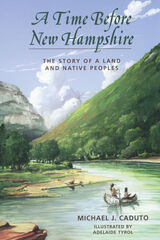 A Time Before New Hampshire: The Story of a Land and Native Peoples
Michael J. Caduto
University Press of New England, 2004 In this masterful and elegant book, Michael J. Caduto tells the complete story of the land of New Hampshire—starting with the formation of earth 4.6 billion years ago and continuing with changes to its peoples and the environment through the seventeenth century. Part I offers a comprehensive look at every aspect of the ancient natural world—including geology, glaciology, botany, climatology, ecology, zoology, and paleobotany. It describes the formation of the land hundreds of millions of years ago as a result of major movements in the tectonic plates; chronicles the rise and fall of reptiles, mammals, birds, and plants and other life forms stemming from climatic changes; and explores the arrival of human beings during and after the relatively recent ice age. The rest of the volume immerses the reader in the history of the human populations in New Hampshire, beginning with the Paleoindian period of hunter gatherers over twelve thousand years ago and continuing through the arrival of horticulture among the Alnôbak (Abenaki) and beyond. Caduto explores the Alnôbak’s day-to-day existence, culture, and traditional tales as preserved by archeologists, anthropologists, historians, and living cultures. Emphasizing the beliefs, cultures, and practices of these native people, Caduto details the Alnôbak’s relationship to the natural world as he tells the story of coevolution between the land and people through time. Caduto takes the reader on an exploration through New Hampshire’s rich and diverse history—using first-hand experiences, re-creations of natural and human environments, journeys through historical landscapes and visits with the families of ancient people—to present a thorough profile of the early beginnings of the Granite State. The volume features an epilogue by Charlie True, Member of the Tribal Council, Abenaki Nation of New Hampshire, and nearly one hundred photographs, illustrations, and detailed maps depicting past peoples, historical trails, and indigenous cultures and environments of New Hampshire.
Time Being
Oni Buchanan
University of Iowa Press, 2020 As time beings, what we have is the time being, the present moment, however compromised, however shattered. Buchanan’s characteristic combination of wry humor, nerve, empathy, wisdom, and outrage exposes the laughably absurd and the evisceratingly tragic all at once.
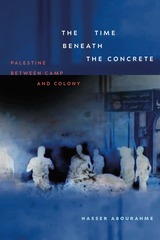 The Time beneath the Concrete: Palestine between Camp and Colony
Nasser Abourahme
Duke University Press, 2025 In The Time beneath the Concrete, Nasser Abourahme argues that settler colonialism is always as much an attempt to conquer time as it is to conquer land. Taking as his primary object Palestinian refugee camps, created in the fallout of the eliminatory violence of Israel’s founding, Abourahme shows how these camps become the primary place where settler colonial attempts to dominate space and time encounter Indigenous refusal. Seen from the camps, Israel becomes a settler colonial project defined by its inability to move past the past—a project stuck at its foundational moment of conquest. At the same time, the Palestinian insistence on return is a refusal to abide by the closure of the past into settler futurity. Palestinian struggle does not just happen in the open time of dispossession; it happens over this time. That struggle, Abourahme demonstrates, is a form of anticolonial refusal that draws its power not from any decisive finality, but precisely from irresolution and keeping time open.
Duke University Press Scholars of Color First Book Award
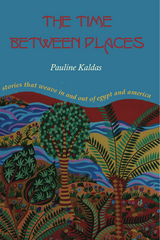 The Time between Places: Stories That Weave In and Out of Egypt and America
Pauline Kaldas
University of Arkansas Press, 2010 This collection of twenty stories delves into the lives of Egyptian characters, from those living in Egypt to those who have immigrated to the United States. With subtle and eloquent prose, the complexities of these characters are revealed, opening a door into their intimate struggles with identity and place. We meet people who are tempted by the possibilities of America and others who are tempted by the desire to return home. Some are in the throes of re-creating themselves in the new world while others seem to be embedded in the loss of their homeland. Many of these characters, although physically located in either the United States or Egypt, have lives that embrace both cultures. "A Game of Chance" follows the actions of a young man when he wins the immigration lottery and then must decide whether or not to change his life. "Cumin and Coriander" takes us inside a woman's thoughts as she tries to come to terms with the path her life has taken while working as a cook for American expatriates in Egypt. "The Top" enters the mind of a man whose immigration results in a loss of identity and sanity. These compelling stories pull us into the lives of many different characters and offer us striking insights into the Arab American experience.
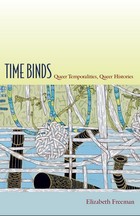 Time Binds: Queer Temporalities, Queer Histories
Elizabeth Freeman
Duke University Press, 2010 Time Binds is a powerful argument that temporal and sexual dissonance are intertwined, and that the writing of history can be both embodied and erotic. Challenging queer theory’s recent emphasis on loss and trauma, Elizabeth Freeman foregrounds bodily pleasure in the experience and representation of time as she interprets an eclectic archive of queer literature, film, video, and art. She examines work by visual artists who emerged in a commodified, “postfeminist,” and “postgay” world. Yet they do not fully accept the dissipation of political and critical power implied by the idea that various political and social battles have been won and are now consigned to the past. By privileging temporal gaps and narrative detours in their work, these artists suggest ways of putting the past into meaningful, transformative relation with the present. Such “queer asynchronies” provide opportunities for rethinking historical consciousness in erotic terms, thereby countering the methods of traditional and Marxist historiography. Central to Freeman’s argument are the concepts of chrononormativity, the use of time to organize individual human bodies toward maximum productivity; temporal drag, the visceral pull of the past on the supposedly revolutionary present; and erotohistoriography, the conscious use of the body as a channel for and means of understanding the past. Time Binds emphasizes the critique of temporality and history as crucial to queer politics.
Time Commences in Xibalbá
Luis de Lión; Translated by Nathan C. Henne
University of Arizona Press, 2012 Time Commences in Xibalbá tells the story of a violent village crisis in Guatemala sparked by the return of a prodigal son, Pascual. He had been raised tough by a poor, single mother in the village before going off with the military. When Pascual comes back, he is changed—both scarred and “enlightened” by his experiences. To his eyes, the village has remained frozen in time. After experiencing alternative cultures in the wider world, he finds that he is both comforted and disgusted by the village’s lingering “indigenous” characteristics.
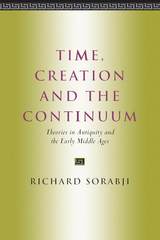 Time, Creation and the Continuum: Theories in Antiquity and the Early Middle Ages
Richard Sorabji
University of Chicago Press, 2006 Richard Sorabji here takes time as his central theme, exploring fundamental questions about its nature: Is it real or an aspect of consciousness? Did it begin along with the universe? Can anything escape from it? Does it come in atomic chunks? In addressing these and myriad other issues, Sorabji engages in an illuminating discussion of early thought about time, ranging from Plato and Aristotle to Islamic, Christian, and Jewish medieval thinkers. Sorabji argues that the thought of these often negelected philosophers about the subject is, in many cases, more complete than that of their more recent counterparts.
“Splendid. . . . The canvas is vast, the picture animated, the painter nonpareil. . . . Sorabji’s work will encourage more adventurers to follow him to this fascinating new-found land.”—Jonathan Barnes, Times Literary Supplement
“One of the most important works in the history of metaphysics to appear in English for a considerable time. No one concerned with the problems with which it deals either as a historian of ideas or as a philosopher can afford to neglect it.”—Donald MacKinnon, Scottish Journal of Theology
“Unusually readable for such scholarly content, the book provides in rich and cogent terms a lively and well-balanced discussion of matters of concern to a wide academic audience.”—Choice
 The Time Divide: Work, Family, and Gender Inequality
Jerry A. Jacobs and Kathleen Gerson
Harvard University Press, 2005 In a panoramic study that draws on diverse sources, Jerry A. Jacobs and Kathleen Gerson explain why and how time pressures have emerged and what we can do to alleviate them. In contrast to the conventional wisdom that all Americans are overworked, they show that time itself has become a form of social inequality that is dividing Americans in new ways—between the overworked and the underemployed, women and men, parents and non-parents. They piece together a compelling story of the increasing mismatch between our economic system and the needs of American families, sorting out important trends such as the rise of demanding jobs and the emergence of new pressures on dual earner families and single parents.Comparing American workers with their European peers, Jacobs and Gerson also find that policies that are simultaneously family-friendly and gender equitable are not fully realized in any of the countries they examine. As a consequence, they argue that the United States needs to forge a new set of solutions that offer American workers new ways to integrate work and family life.
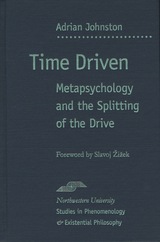 Time Driven: Metapsychology and the Splitting of the Drive
Adrian Johnston
Northwestern University Press, 2005 Elaborating the fundamental concept of Trieb, or drive, Freud outlines two basic types of conflict that at once disturb and organize mental life: the conflict between drives and reality; and the conflict between the drives themselves (as in amorous Eros against the aggressive death drive). In Time Driven, Adrian Johnston identifies a third distinct type of conflict overlooked by Freud: the conflict embedded within each and every drive. By bringing this critical type of conflict to light and explaining its sobering consequences for an understanding of the psyche, Johnston's book makes an essential theoretical contribution to Continental philosophy. His work offers a philosophical interpretation and reassessment of psychoanalysis that places it in relationship to the larger stream of ideas forming our world and, at the same time, clarifies its original contribution to our understanding of the human situation.
Johnston draws on Jacques Lacan's oeuvre in conjunction with certain philosophical resources-elements from transcendental philosophy, structuralism, and phenomenology-to rectify the inconsistencies within the Freudian metapsychological model of drive. In doing so, he helps to answer a question haunting Freud at the end of his career: Why is humanity plagued by a perpetual margin of discontent, despite technological and cultural progress?
In Time Driven, Johnston is able to make sense of Freud's metapsychology both as a whole and in its historical development of Lacan's reinterpretation of Freud, and of the place of both Freud and Lacan in modern philosophy.
 Time, Duration and Change in Contemporary Art: Beyond the Clock
Kate Bretkelly-Chalmers
Intellect Books, 2018 Time, Duration and Change in Contemporary Art presents a major study of time as a key aesthetic dimension of recent art practices. This book explores different aspects of time across a broad range of artistic media and draws on recent movements in philosophy, science, and technology to show how artists generate temporal experiences that resist the standardized time of modernity: Olafur Eliasson’s melting icebergs produce fragile temporal ecologies; Marina Abramović’s performances test the durations of the human body; Christian Marclay’s The Clock conflates past and present chronologies.
This book examines alternative frameworks of time, duration, and change in prominent philosophical, scientific, and technological traditions, including physics, psychology, phenomenology, neuroscience, media theory, and selected environmental sciences. It suggests that art makes a crucial contribution to these discourses not by “visualizing” time, but by entangling viewers in different sensory, material, and imaginary temporalities.
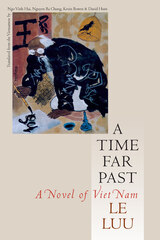 A Time Far Past: A Novel of Viet Nam
Le Luu
University of Massachusetts Press, 1997 This epic novel presents a sweeping portrait of war and peace in northern Vietnam from the defeat of the French to the mid-1980s. The story follows the odyssey of Giang Minh Sai, the son of a Confucian scholar in the rural Red River delta, from his early childhood through his decorated service during the American War and his later efforts to adapt to the postwar world of urban Ha Noi. Through two failed marriages, Giang Minh Sai struggles to come to terms with his responsibilities, his past, and his future. The novel's ending leaves its hero and Vietnamese socialism at a problematic and painful crossroads.
In its intricate sketching of complicated alliances, personal debts, and human interactions, A Time Far Past explores the complex layering of family and village history and Party and feudal authority. It also paints a vivid picture of the vast dislocations in Vietnamese culture caused by the political and military turmoil of the Indochina wars.
A Time Far Past was enormously popular in Vietnam, where it was first published in 1986, selling more than 120,000 copies and winning that country's national prize for fiction.
Time for Change: A New Approach To Environment And Development
Edited by Hal Kane and Linda Starke
Island Press, 1992 The U.S. Citizens Network prepared this guidebook to help American citizens and organizations understand and participate effectively in the United Nations Conference on Environment and Development (UNCED), an unprecedented "Earth Summit," at which heads of state, individuals, and groups from around the world considered how to balance development pressures with an increasingly imperiled global environment.
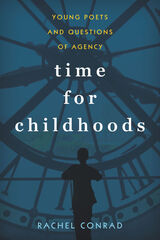 Time for Childhoods: Young Poets and Questions of Agency
Rachel Conrad
University of Massachusetts Press, 2020 Poems written by children are not typically part of the literary canon. Because of cultural biases that frame young people as intellectually and artistically immature, these works are often excluded or dismissed as juvenilia. Rachel Conrad contends that youth-composed poems should be read as literary works in their own right—works that are deserving of greater respect in literary culture.
Time for Childhoods presents a selection of striking twentieth-and twenty-first-century American poetry written by young people, and highlights how young poets imagined and shaped time for their own poetic purposes. Through close engagement with archival materials, as well as select interviews and correspondence with adult mentors, Conrad discerns how young writers figured social realities and political and racial injustices, and discusses what important advocates such as Gwendolyn Brooks and June Jordan can teach us about supporting the agency of young poets. This essential study demonstrates that young poets have much to contribute to ongoing conversations about time and power.
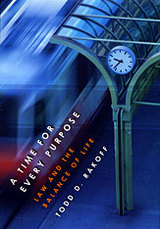 A Time for Every Purpose: Law and the Balance of Life
Todd D. Rakoff
Harvard University Press, 2002 Who organizes our time? Who decides when we must be at work and at school, when we set back our clocks, and when retail stores will close? Todd Rakoff traces the law's effect on our use of time and discovers that the structure of our time is gradually changing. As Rakoff demonstrates, the law's influence is subtle, and so ubiquitous that we barely notice it. But its structure establishes the terms by which society allocates its efforts, coordinates its many players, establishes the rhythms of life, and indeed gives meaning to the time in which we live. Compulsory education law, overtime law, daylight-saving law, and Blue Laws are among the many rules government uses to shape our use of time.
More and more, however, society, and especially the workplace, has come to see time simply as a quantity whose value must be maximized. As lawmakers struggle to deal with accelerating market demands, the average citizen's ability to organize his or her time to accommodate all of life's activities is diminishing. Meanwhile, it is increasingly hard to differentiate weekdays from weekends, and ordinary days from holidays. The law of time, Rakoff argues, may need refashioning to meet modern circumstances, but we continue to need a stable legal structure of time if we are to attain the ancient goal of a balanced life: "A Time for Every Purpose."
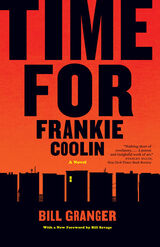 Time for Frankie Coolin: A Novel
Bill Granger
University of Chicago Press, 2014 Known as much for his journalistic reporting as for the fiction he wrote under a variety of pen names, Bill Granger combined his divergent talents in his powerful novel Time for Frankie Coolin. With distinctive voices, compelling characters, on-the-ground observation, and suspense, it offers a serious, illuminating take on the changing tides of race, class, and politics in late twentieth-century Chicago.
Time for Frankie Coolin tells the story of a plasterer turned landlord in Chicago who, in the late 1970s, buys abandoned buildings and makes them just habitable enough that he can charge minimal rent to his mostly black tenants. Frankie—both a tough guy in the trades and a family man—has done well by his wife and kids, moving them to a house in the suburbs. But a casual favor for his wife’s cousin—allowing the man to store some crates in an empty building—and a random act of arson set in motion a cascade of crises, including a menacing pair of G-men and the looming threat of prison if Frankie doesn’t talk. But since talking has never been one of Frankie’s strengths, he copes as he always has: by trying to tough it out on his own.
Calling to mind such gritty poets of the urban scene as George V. Higgins and Nelson Algren, Time for Frankie Coolin is both a psychological thriller and a ’70s Chicago period piece that shines a surprisingly sympathetic light on the often ignored stories of the people who lived, worked, and died at the city’s margins.
A Time for Spies: Theodore Stephanovich Mally and the Era of the Great Illegals
William E. Duff
Vanderbilt University Press, 1999 In this enlightening new book, former FBI Special Agent William E. Duff offers a gripping portrait of Theodore Stephanovich Mally and the historical and psychological factors that influenced and motivated him. By examining this instrumental yet largely ignored figure, Duff provides a unique glimpse into the rapidly evolving world of prewar Soviet intelligence, its people, and its tradecraft.
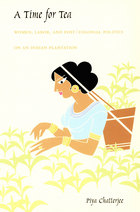 A Time for Tea: Women, Labor, and Post/Colonial Politics on an Indian Plantation
Piya Chatterjee
Duke University Press, 2001 In this creative, ethnographic, and historical critique of labor practices on an Indian plantation, Piya Chatterjee provides a sophisticated examination of the production, consumption, and circulation of tea. A Time for Tea reveals how the female tea-pluckers seen in advertisements—picturesque women in mist-shrouded fields—came to symbolize the heart of colonialism in India. Chatterjee exposes how this image has distracted from terrible working conditions, low wages, and coercive labor practices enforced by the patronage system. Allowing personal, scholarly, and artistic voices to speak in turn and in tandem, Chatterjee discusses the fetishization of women who labor under colonial, postcolonial, and now neofeudal conditions. In telling the overarching story of commodity and empire, A Time for Tea demonstrates that at the heart of these narratives of travel, conquest, and settlement are compelling stories of women workers. While exploring the global and political dimensions of local practices of gendered labor, Chatterjee also reflects on the privileges and paradoxes of her own “decolonization” as a Third World feminist anthropologist. The book concludes with an extended reflection on the cultures of hierarchy, power, and difference in the plantation’s villages. It explores the overlapping processes by which gender, caste, and ethnicity constitute the interlocked patronage system of villages and their fields of labor. The tropes of coercion, consent, and resistance are threaded through the discussion. A Time for Tea will appeal to anthropologists and historians, South Asianists, and those interested in colonialism, postcolonialism, labor studies, and comparative or international feminism. Designated a John Hope Franklin Center book by the John Hope Franklin Seminar Group on Race, Religion, and Globalization.
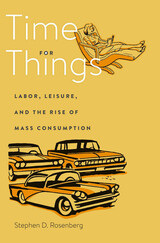 Time for Things: Labor, Leisure, and the Rise of Mass Consumption
Stephen D. Rosenberg
Harvard University Press, 2020 Modern life is full of stuff yet bereft of time. An economic sociologist offers an ingenious explanation for why, over the past seventy-five years, Americans have come to prefer consumption to leisure.
Productivity has increased steadily since the mid-twentieth century, yet Americans today work roughly as much as they did then: forty hours per week. We have witnessed, during this same period, relentless growth in consumption. This pattern represents a striking departure from the preceding century, when working hours fell precipitously. It also contradicts standard economic theory, which tells us that increasing consumption yields diminishing marginal utility, and empirical research, which shows that work is a significant source of discontent. So why do we continue to trade our time for more stuff?
Time for Things offers a novel explanation for this puzzle. Stephen Rosenberg argues that, during the twentieth century, workers began to construe consumer goods as stores of potential free time to rationalize the exchange of their labor for a wage. For example, when a worker exchanges their labor for an automobile, they acquire a duration of free activity that can be held in reserve, counterbalancing the unfree activity represented by work. This understanding of commodities as repositories of hypothetical utility was made possible, Rosenberg suggests, by the standardization of durable consumer goods, as well as warranties, brands, and product-testing, which assured wage earners that the goods they purchased would be of consistent, measurable quality.
This theory clarifies perplexing aspects of behavior under industrial capitalism—the urgency to spend earnings on things, the preference to own rather than rent consumer goods—as well as a variety of historical developments, including the coincident rise of mass consumption and the legitimation of wage labor.
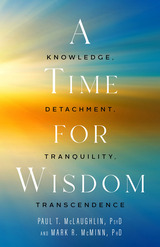 A Time for Wisdom: Knowledge, Detachment, Tranquility, Transcendence
Paul T. McLaughlin
Templeton Press, 2022 These are volatile times. Fear, suspicion, and cynicism are chronic. A mere tweet inflames the passions of millions while click-bait “hot takes” stoke the amygdalas of everyone with an Internet connection. We treat those not in our tribe as a threat and deem anyone with a different opinion as evil. Mistaking myopia for measure, we lack all sense of proportion in our judgments. We are shortsighted, mired in the present, ignorant of history, and blind to the future. We thought that technology would save us by connecting us to each other and the world’s information. Instead, it enticed our vices, encouraged our biases, and eroded the one virtue we need now more than ever: wisdom. A Time for Wisdom is for readers who feel beleaguered by the incivility of the modern world, dispirited by its coarse rhetoric and toxic partisanship. It is an invitation to escape the shallow cacophony and restore peace and perspective to our daily lives. Written by two psychologists, the book takes the best scientific research on wisdom and integrates it with timeless concepts that have, for ages, guided troubled souls through life’s hardships. From this foundation, the authors present four steps we can follow to practice wisdom in the 21st Century: - Receiving knowledge.
- Practicing detachment.
- Experiencing tranquility.
- Cultivating transcendence.
These are profound and spiritual principles that can bring us immense satisfaction when we aspire to live by them.
In A Time for Wisdom, the authors show us how. They commend a course of action towards the Good, the True, and the Beautiful, towards calm and clear moral reasoning. They lead us out of the circus of contemporary life and show us a path beyond our petty self-centeredness. By journeying along that path, we can, like the great sages and scientists before us, rise above the immediacy of the moment and partake of the numinous and the infinite.
Time, Forward!
Valentin Kataev
Northwestern University Press, 1995 A classic of Soviet realism, Time, Forward! captures the enthusiasm and optimism of the first Five-Year Plan in its portrayal of the construction of Magnitogorsk, an enormous metallurgical plant considered one of the finest industrial achievements of the period. It embodies the beliefs of the era—that the collective (here a multinational brigade) through its determination and the application of technology can accomplish the impossible, conquer nature, even overcome time. Utilizing cinematic technique to tell his story, Kataev focuses on a twenty-four hour period when of the Magnitogorsk shock-brigades breaks a world record for pouring cement. The result is a remarkably affecting portrait of the idealism and sacrifice powering the early Soviet era.
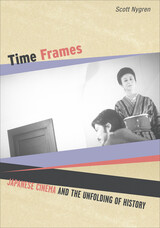 Time Frames: Japanese Cinema and the Unfolding of History
Scott Nygren
University of Minnesota Press, 2007 Until 1951, when Kurosawa’s Rashomon won the Golden Lion award for best film at the Venice Film Festival, Japanese cinema was isolated from world distribution and the international discourse on film. After this historic event, however, Japanese cinema could no longer be ignored.In Time Frames, Scott Nygren explores how Japanese film criticism and history has been written both within and beyond Japan, before and after Rashomon. He takes up the central question of which, and whose, Japan do critics and historians mean when reviewing the country’s cinema—an issue complicated by assumptions about cultural purity, Japan’s appropriation of Western ideas and technologies, and the very existence of a West and an Orientalist non-West.Deftly moving backward and forward from the pivotal 1951 festival, Nygren traces the invention of Japanese film history as a disciplinary mode of knowledge. His analysis includes such topics as the reconfiguration of prewar films in light of postwar recognition, the application of psychoanalytic theory to Japanese art and culture, and the intersection of kanji and cinema. He considers the historical inscription of 1950s Japan as “the golden age of the humanist film,” the identification of a Japanese New Wave and the implications of categorizing Japanese film through analogy to other national cinemas. Bringing the discussion to Japan’s reception of postmodernism, Nygren looks at the emergence of video art and anime and the end of Japanese film history as a meaningful concept in the rise of the Internet and globalization.Nygren highlights the creative exchange among North American, European, and Asian media, places Japanese film at the center of this discourse, and, ultimately, reveals its global role as a cultural medium, capable of transforming theory.Scott Nygren is associate professor of film and media studies at the University of Florida.
Time Gifts
Zoran Zivkovic
Northwestern University Press, 2000 Zoran Zivkovic weaves four mysterious encounters around philosophical questions at the core of human existence. Provocative and original, Time Gifts is a meditation on the nature of time and, especially, on the nature of those at its mercy.
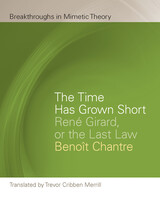 The Time Has Grown Short: René Girard, or the Last Law
Benoît Chantre
Michigan State University Press, 2022 The protagonist of Marcel Proust’s In Search of Lost Time observes with wonder the comings and goings of the crows that roost in the belfry of the village church in Combray, his childhood home. For René Girard, one of Proust’s great interpreters, their mysterious flight, first departing from and then returning to the vertical axis of the steeple, suggests the movement of modern history—the crisis of aristocratic models, the growing servitude of individuals possessed by mimetic desire, and the final irruption of authentic transcendence. In this rich exploration of Girard’s insights, his French editor and longtime collaborator Benoît Chantre brings Saint Paul’s Letter to the Romans into dialogue with both Proust and Girard in order to push to its logical endpoint the idea of a back-and-forth movement from chaos to order. History, Chantre argues, has been driven mad by the revelation of its sacrificial engine. The only way out lies in a transformation internal to the crisis itself—only that faith which is capable of hearing the One who speaks in the Law makes it possible to avoid the perpetual ups and downs of rivalry. Acting and revealing Himself at the heart of history, an intimate model “hidden since the foundation of the world” deals a fatal blow to the circle of sin. Authentic transcendence coincides with the eschaton, the moment when—according to Saint Paul—historical time implodes into eternity.
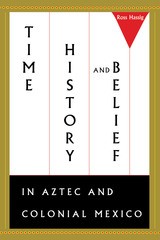 Time, History, and Belief in Aztec and Colonial Mexico
By Ross Hassig
University of Texas Press, 2001 Based on their enormously complex calendars that recorded cycles of many kinds, the Aztecs and other ancient Mesoamerican civilizations are generally believed to have had a cyclical, rather than linear, conception of time and history. This boldly revisionist book challenges that understanding. Ross Hassig offers convincing evidence that for the Aztecs time was predominantly linear, that it was manipulated by the state as a means of controlling a dispersed tribute empire, and that the Conquest cut off state control and severed the unity of the calendar, leaving only the lesser cycles. From these, he asserts, we have inadequately reconstructed the pre-Columbian calendar and so misunderstood the Aztec conception of time and history. Hassig first presents the traditional explanation of the Aztec calendrical system and its ideological functions and then marshals contrary evidence to argue that the Aztec elite deliberately used calendars and timekeeping to achieve practical political ends. He further traces how the Conquest played out in the temporal realm as Spanish conceptions of time partially displaced the Aztec ones. His findings promise to revolutionize our understanding of how the Aztecs and other Mesoamerican societies conceived of time and history.
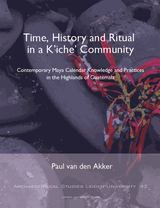 Time, History and Ritual in a K'iche' Community: Contemporary Maya Calendar Knowledge and Practices in the Highlands of Guatemala
Paul van den Akker
Leiden University Press, 2018
This work analyzes ritual practices and knowledge related to the Mesoamerican calendar with the aim of contributing to an understanding of the use and conceptualization of this calendar system in the contemporary K’iche’ community of Momostenango in the Highlands of Guatemala. The research presented here discusses the indigenous calendar system, forms of synergy between the Christian and the Highland Guatemalan calendar, the indigenous perception of history, and continuity in time-related symbolism.
Van den Akker argues that the social role of cultural anthropologists and archaeologists is to contribute to the ongoing process of cultural healing and spiritual recovery of the peoples that suffer(ed) from colonization and oppression. This study therefore places an emphasis on cultural continuity and approaches the continuation of Maya calendar practices as a possible tool for restoring breaks in social memory, which are caused by dramatic events such as colonization.
Throughout this book it is argued that time is an authority which directs human behavior in a cyclical manner through the landscape on a local and regional scale. Time is related to morality and cultural values, and a shared perception of time contributes to the cohesion of the community as it recreates and reaffirms the identity of its members by reiterating their shared social conventions and history. Finally, the conjunction of time and ritual provides a tool to overcome the rupture caused by death and to transmit messages from generation to generation over a long span of time.
 Time, Ignorance, and Uncertainty in Economic Models
Donald W. Katzner
University of Michigan Press, 1998 Emerging from the tradition of Marshall, Knight, Keynes, and Shackle, Time, Ignorance, and Uncertainty in Economic Models is concerned with the character of formal economic analysis when the notions of logical or mechanical time and probabilistic uncertainty and the relatively complete knowledge basis it requires, are replaced, respectively, by historical time, and nonprobabilistic uncertainty and ignorance. Examining that analytical character by constructing and exploring particular models, this book emphasizes doing actual economic analysis in a framework of historical time, nonprobabilistic uncertainty, and ignorance.
Donald W. Katzner begins with an extensive investigation of the distinction between potential surprise and probability. He presents a modified version of Shackle's model of decision-making in ignorance and examines in considerable detail its "comparative statics" and operationality properties. The meaning of aggregation and simultaneity under these conditions is also explored, and Shackle's model is applied to the construction of models of the consumer, the firm, microeconomics, and macroeconomics. Katzner concludes with discussions of the roles of history, hysteresis, and empirical investigation in economic inquiry.
Time, Ignorance, and Uncertainty in Economic Models will be of interest to economists and others engaged in the study of uncertainty, probability, aggregation, and simultaneity. Those interested in the microeconomics of consumer and firm behavior, general equilibrium, and macroeconomics will also benefit from this book.
Donald W. Katzner is Professor of Economics, University of Massachusetts.
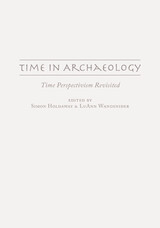 Time in Archaeology: Time Perspectivism Revisited
Simon Holdaway
University of Utah Press, 2011 In archaeology, time is used to convey a wide range of meanings with common usage in just a couple of senses. Thus, we students of time must devote considerable time to establishing the timing of past events, the lapse of time, and learning about times past.
The point of departure for this volume lies in the post-tumultuous times of processual archaeology, in the 1970s and 1980s, when Geoff Bailey, Lewis Binford, David Clarke, Robert Dunnell, Robert Foley, and Michael Schiffer, among others, initiated a deconstruction of time as used in archaeology. Here, the authors further this deconstruction.
Time in Archaeology was originally convened as an electronic symposium held at the Society of American Archaeology meetings in 2003. The result is a tightly focused group of papers that provide both a historical background to the development of the ideas of time perspectivism as well as a range of case studies that illustrate where scholars have taken the ideas. This book demonstrates the importance of concepts of time with excellent discussions and perspectives from twelve scholars working in vastly different arenas. It is a rigorous examination of the assumptions we make and the impacts of those assumptions. After reading this you may never think about time in quite the same way.
 Time in Eternity: Pannenberg, Physics, and Eschatology in Creative Mutual Interaction
Robert John Russell
University of Notre Dame Press, 2012
According to Robert John Russell, one of the foremost scholars on relating Christian theology and science, the topic of “time and eternity” is central to the relation between God and the world in two ways. First, it involves the notion of the divine eternity as the supratemporal source of creaturely time. Second, it involves the eternity of the eschatological New Creation beginning with the bodily Resurrection of Jesus in relation to creaturely time. The key to Russell's engagement with these issues, and the purpose of this book, is to explore Wolfhart Pannenberg’s treatment of time and eternity in relation to mathematics, physics, and cosmology.
Time in Eternity is the first book-length exposition of Russell’s unique method for relating Christian theology and the natural sciences, which he calls “creative mutual interaction” (CMI). This method first calls for a reformulation of theology in light of science and then for the delineation of possible topics for research in science drawing on this reformulated theology. Accordingly, Russell first reformulates Pannenberg’s discussion of the divine attributes—eternity and omnipresence—in light of the way time and space are treated in mathematics, physics, and cosmology. This leads him to construct a correlation of eternity and omnipresence in light of the spacetime framework of Einstein’s special relativity. In the process he proposes a new flowing time interpretation of relativity to counter the usual block universe interpretation supported by most physicists and philosophers of science. Russell also replaces Pannenberg’s use of Hegel’s concept of infinity in relation to the divine attributes with the concept of infinity drawn from the mathematics of Georg Cantor. Russell then addresses the enormous challenge raised by Big Bang cosmology to Christian eschatology. In response, he draws on Pannenberg’s interpretation both of the Resurrection as a proleptic manifestation of the eschatological New Creation within history and the present as the arrival of the future. Russell shows how such a reformulated understanding of theology can shed light on possible directions for fundamental research in physics and cosmology. These lead him to explore preconditions in contemporary physics research for the possibility of duration, copresence, retroactive causality, and prolepsis in nature.
“Time in Eternity bridges the fields of philosophical theology, systematic theology, and the science-religion debate. It makes a distinctive and original contribution to the field of theology and science, as well as being significant for scholars and students in the other two disciplines. The book not only meets high standards for scholarship in this field; it actually sets new standards for future work.” —Philip Clayton, Claremont School of Theology
Time in India’s Development Programmes
Robert Repetto
Harvard University Press, 1971 In India the high cost of savings makes the efficient use of investable resources crucial. Robert Repetto's empirical study of selected Indian development programs shows that efficiency in investment depends largely on the effective management of time and on success in accelerating the benefits of investment projects. The author discusses improvements at program and sectoral levels that have been adopted by Indian planners and managers, as well as others that may be within reach. Selected case studies indicate how his general argument applies to the development of infant industries, the choice of techniques, and the conduct of social programs. This statistically documented study has implications for development planning in all labor-abundant economies.
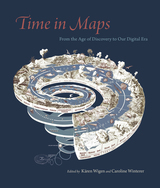 Time in Maps: From the Age of Discovery to Our Digital Era
Edited by Kären Wigen and Caroline Winterer
University of Chicago Press, 2020 Maps organize us in space, but they also organize us in time. Looking around the world for the last five hundred years, Time in Maps shows that today’s digital maps are only the latest effort to insert a sense of time into the spatial medium of maps. Historians Kären Wigen and Caroline Winterer have assembled leading scholars to consider how maps from all over the world have depicted time in ingenious and provocative ways.
Focusing on maps created in Spanish America, Europe, the United States, and Asia, these essays take us from the Aztecs documenting the founding of Tenochtitlan, to early modern Japanese reconstructing nostalgic landscapes before Western encroachments, to nineteenth-century Americans grappling with the new concept of deep time. The book also features a defense of traditional paper maps by digital mapmaker William Rankin. With more than one hundred color maps and illustrations, Time in Maps will draw the attention of anyone interested in cartographic history.
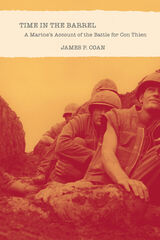 Time in the Barrel: A Marine's Account of the Battle for Con Thien
James P. Coan
University of Alabama Press, 2019 A Marine’s highly personal memoir reliving the hellish days of a pivotal conflict of the Vietnam War
Con Thien, located only two miles from the demilitarized zone dividing North and South Vietnam, was a United States Marine Corps firebase that was the scene of fierce combat for months on end during 1967. Staving off attacks and ambushes while suffering from ineffectual leadership from Washington as well as media onslaughts, courageous American Marines protected this crucial piece of land at all costs. They would hold Con Thien, but many paid the ultimate price. By the end of the war, more than 1,400 Marines had died and more than 9,000 sustained injuries defending the “Hill of Angels.”
For eight months, James P. Coan’s five-tank platoon was assigned to Con Thien while attached to various Marine infantry battalions. A novice second lieutenant at the time, the author kept a diary recording the thoughts, fears, and frustrations that accompanied his life on “The Hill.” Time in the Barrel: A Marine’s Account of the Battle for Con Thien offers an authentic firsthand account of the daily nightmare that was Con Thien. An enticing and fascinating read featuring authentic depictions of combat, it allows readers to fully grasp the enormity of the fierce struggle for Con Thien.
The defenders of Con Thien were bombarded with hundreds of rounds of incoming rockets, mortars, and artillery that pounded the beleaguered outpost daily. Monsoon downpours turned the red laterite clay soil into a morass of oozing mud, flooded bunkers and trenches, and made Con Thien a living hell. .Being at Con Thien came to be ruefully referred to by the Marines stationed there as "time in the barrel” because they were targets as easy as fish in a barrel.
More than a retelling of military movements, Coan’s engrossing narratives focus on the sheer sacrifice and misery of one Marine’s experience in Vietnam. Through his eyes, we experience the abysmal conditions the Marines endured, from monsoon rainstorms to the constant threat of impending attack. Climatic moments in history are captured through the rare, personal perspective of one particularly astute and observant participant.
Time in the Ditch: American Philosophy and the McCarthy Era
John McCumber
Northwestern University Press, 2023 In Time in the Ditch, John McCumber explores the effects of McCarthyism on American philosophy in the 1940s and 1950 and the possibility that the political pressures of the McCarthy era skewed the development of the discipline. Why was silence maintained for so long? And what happens, McCumber asks, when political events and pressures go beyond interfering with individual careers to influence the nature of a discipline itself?
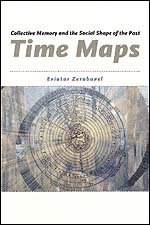 Time Maps: Collective Memory and the Social Shape of the Past
Eviatar Zerubavel
University of Chicago Press, 2003 "Time Maps extends beyond all of the old clichés about linear, circular, and spiral patterns of historical process and provides us with models of the actual legends used to map history. It is a brilliant and elegant exercise in model building that provides new insights into some of the old questions about philosophy of history, historical narrative, and what is called straight history."-Hayden White, University of California, Santa Cruz
Who were the first people to inhabit North America? Does the West Bank belong to the Arabs or the Jews? Why are racists so obsessed with origins? Is a seventh cousin still a cousin? Why do some societies name their children after dead ancestors?
As Eviatar Zerubavel demonstrates in Time Maps, we cannot answer burning questions such as these without a deeper understanding of how we envision the past. In a pioneering attempt to map the structure of our collective memory, Zerubavel considers the cognitive patterns we use to organize the past in our minds and the mental strategies that help us string together unrelated events into coherent and meaningful narratives, as well as the social grammar of battles over conflicting interpretations of history. Drawing on fascinating examples that range from Hiroshima to the Holocaust, from Columbus to Lucy, and from ancient Egypt to the former Yugoslavia, Zerubavel shows how we construct historical origins; how we tie discontinuous events together into stories; how we link families and entire nations through genealogies; and how we separate distinct historical periods from one another through watersheds, such as the invention of fire or the fall of the Berlin Wall.
Most people think the Roman Empire ended in 476, even though it lasted another 977 years in Byzantium. Challenging such conventional wisdom, Time Maps will be must reading for anyone interested in how the history of our world takes shape.
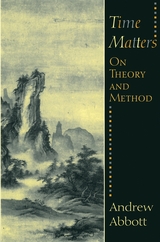 Time Matters: On Theory and Method
Andrew Abbott
University of Chicago Press, 2001 What do variables really tell us? When exactly do inventions occur? Why do we always miss turning points as they transpire? When does what doesn't happen mean as much, if not more, than what does? Andrew Abbott considers these fascinating questions in Time Matters, a diverse series of essays that constitutes the most extensive analysis of temporality in social science today. Ranging from abstract theoretical reflection to pointed methodological critique, Abbott demonstrates the inevitably theoretical character of any methodology.
Time Matters focuses particularly on questions of time, events, and causality. Abbott grounds each essay in straightforward examinations of actual social scientific analyses. Throughout, he demonstrates the crucial assumptions we make about causes and events, about actors and interaction and about time and meaning every time we employ methods of social analysis, whether in academic disciplines, market research, public opinion polling, or even evaluation research. Turning current assumptions on their heads, Abbott not only outlines the theoretical orthodoxies of empirical social science, he sketches new alternatives, laying down foundations for a new body of social theory.
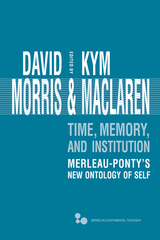 Time, Memory, Institution: Merleau-Ponty's New Ontology of Self
David Morris
Ohio University Press, 2015 This collection is the first extended investigation of the relation between time and memory in Maurice Merleau-Ponty’s thought as a whole and the first to explore in depth the significance of his concept of institution. It brings the French phenomenologist’s views on the self and ontology into contemporary focus. Time, Memory, Institution argues that the self is not a self-contained or self-determining identity, as such; it is gathered out of a radical openness to what is not self, and that it gathers itself in a time that is not merely a given dimension, but folds back upon, gathers, and institutes itself. Access to previously unavailable texts, in particular Merleau-Ponty’s lectures on institution and expression, has presented scholars with new resources for thinking about time, memory, and history. These essays represent the best of this new direction in scholarship; they deepen our understanding of self and world in relation to time and memory; and they give occasion to reexamine Merleau-Ponty’s contribution and relevance to contemporary Continental philosophy. This volume is essential reading for scholars of phenomenology and French philosophy, as well as for the many readers across the arts, humanities, and social sciences who continue to draw insight and inspiration from Merleau-Ponty. Contributors: Elizabeth Behnke, Edward Casey, Véronique Fóti, Donald Landes, Kirsten Jacobson, Galen Johnson, Michael Kelly, Scott Marratto, Glen Mazis, Caterina Rea, John Russon, Robert Vallier, and Bernhard Waldenfels
The Time: Night
Ludmilla Petrushevskaya
Northwestern University Press, 2000 First published in Russia in 1992, The Time: Night is a darkly humorous depiction of the Soviet utopia's underbelly by one of the most brilliant stylists in contemporary Russian literature. Anna Andrianova is a trite poet and disastrous parent. Heading a household dominated by women, she can cling to the myth of the all-powerful yet suffering Russian matriarch. Challenging that myth is her headstrong daughter Alyona, a woman with appalling judgment and several illegitimate children, who both needs Anna and hates her.
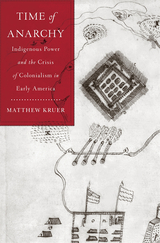 Time of Anarchy: Indigenous Power and the Crisis of Colonialism in Early America
Matthew Kruer
Harvard University Press, 2021 A gripping account of the violence and turmoil that engulfed England’s fledgling colonies and the crucial role played by Native Americans in determining the future of North America.
In 1675, eastern North America descended into chaos. Virginia exploded into civil war, as rebel colonists decried the corruption of planter oligarchs and massacred allied Indians. Maryland colonists, gripped by fears that Catholics were conspiring with enemy Indians, rose up against their rulers. Separatist movements and ethnic riots swept through New York and New Jersey. Dissidents in northern Carolina launched a revolution, proclaiming themselves independent of any authority but their own. English America teetered on the edge of anarchy.
Though seemingly distinct, these conflicts were in fact connected through the Susquehannock Indians, a once-mighty nation reduced to a small remnant. Forced to scatter by colonial militia, Susquehannock bands called upon connections with Indigenous nations from the Great Lakes to the Deep South, mobilizing sources of power that colonists could barely perceive, much less understand. Although the Susquehannock nation seemed weak and divided, it exercised influence wildly disproportionate to its size, often tipping settler societies into chaos. Colonial anarchy was intertwined with Indigenous power.
Piecing together Susquehannock strategies from a wide range of archival documents and material evidence, Matthew Kruer shows how one people’s struggle for survival and renewal changed the shape of eastern North America. Susquehannock actions rocked the foundations of the fledging English territories, forcing colonial societies and governments to respond. Time of Anarchy recasts our understanding of the late seventeenth century and places Indigenous power at the heart of the story.
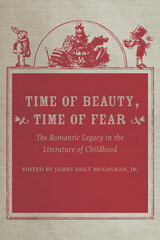 Time of Beauty, Time of Fear: The Romantic Legacy in the Literature of Childhood
James Holt McGavran, Jr.
University of Iowa Press, 2012 It is now two and a half centuries since Jean-Jacques Rousseau first wrote so evocatively of natural man in Social Contract and of experiential education in Emile. His emphasis on the early years as a crucial part of life drove the Romantic reconceptualization of childhood—the idea that children have a special knowledge of nature, politics, and spirituality to teach their elders as well as the other way around. William Wordsworth’s assertion in the “Intimations Ode” that children’s souls come “trailing clouds of glory” from God has continued to haunt Western literature and culture in spite of attacks from writers and critics from then until now, including Mary Wollstonecraft, Robert Thomas Malthus, T. S. Eliot, Judy Blume, Jerome McGann, and Jacqueline Rose. Displaying careful scholarship, sophisticated use of contemporary literary theory, and close readings of texts while recovering and analyzing materials from more than two centuries of British and other Anglophone cultural history, this collection of new essays traces the evolution of the Romantic child. The contributors play off one another, both within the three traditional historical periods—Romantic, Victorian, and modern/postmodern—and across intellectual and disciplinary categories. Time of Beauty, Time of Fear offers a stunning array of essays. In some, the authors focus on canonical texts by such writers as Wordsworth, Maria Edgeworth, Charlotte Smith, and Mrs. Molesworth. Other authors consider the Victorian concerns with missionary literature for children and with the boyish pastime of collecting bird’s nests, folk voices of the 1960s, homeschooling, the Teletubbies television program, and Alan Moore’s Promethea series of graphic novels. Measured in terms of both range and quality, this volume is destined to become essential reading for scholars from numerous disciplines. Contributors Jennifer Smith Daniel Elizabeth A. Dolan Richard Flynn Elizabeth Gargano Mary Ellis Gibson Dorothy H. McGavran Roderick McGillis Claudia Mills Jochen Petzold Malini Roy Andrew J. Smyth Jan Susina
A Time of Crisis: Japan, the Great Depression, and Rural Revitalization
Kerry Smith
Harvard University Press, 2001 This study of Japan's transformation by the economic crises of the 1930s focuses on efforts to overcome the effects of the Great Depression in rural areas, particularly the activities of local activists and policymakers in Tokyo. The author argues that these efforts changed the nation's thinking about the countryside, as well as Japan's conception of its economic and cultural relationship to the nation, in ways that have important implications for our understanding of both the war years and the postwar reconstruction. The reactions of inhabitants of rural areas to the depression shed new light on how average Japanese responded to the problems of modernization and how they re-created the countryside.
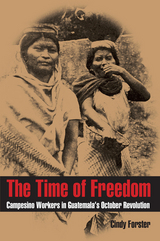 The Time of Freedom: Campesino Workers in Guatemala’s October Revolution
Cindy Forster
University of Pittsburgh Press, 2001
"The time of freedom" was the name that plantation workers—campesinos—gave to Guatemala’s national revolution of 1944–1954. Cindy Forster reveals the critical role played by the poor in organizing and sustaining this period of reform.
Through court records, labor and agrarian ministry archives, and oral histories, Forster demonstrates how labor conflict on the plantations prepared the ground for national reforms that are usually credited to urban politicians. She focuses on two plantation zones that generated exceptional momentum: the coffee belt in the highlands around San Marcos and the United Fruit Company’s banana groves near Tiquisate. Although these regions were unlike in size and complexity, language and race, popular culture and work patterns, both erupted with demands for workers’ rights and economic justice shortly after the fall of Castañeda in 1944.
A welcome balance to the standard "top-down" histories of the revolution, Forster’s sophisticated analysis demonstrates how campesinos changed the course of the urban revolution. By establishing the context of grassroots mobilization, she substantially alters the conventional view of the entire revolution, and particularly the reforms enacted under President Albenz.
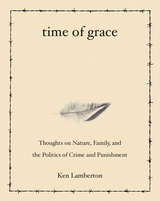 Time of Grace: Thoughts on Nature, Family, and the Politics of Crime and Punishment
Ken Lamberton
University of Arizona Press, 2007 “I hole up in my own cozy cubicle and write, considering ways to make the approaching Thanksgiving holiday not just another day in this place. In prison, hope faces east; time is measured in wake-ups.”
Time of Grace is a remarkable book, written with great eloquence by a former science teacher who was incarcerated for twelve years for his sexual liaison with a teenage student. Far more than a “prison memoir,” it is an intimate and revealing look at relationships—with fellow humans and with the surprising wildlife of the Sonoran Desert, both inside and beyond prison walls. Throughout, Ken Lamberton reflects on human relations as they mimic and defy those of the natural world, whose rhythms calibrate Lamberton’s days and years behind bars. He writes with candor about his life, while observing desert flora and fauna with the insight and enthusiasm of a professional naturalist.
While he studies a tarantula digging her way out of the packed earth and observes Mexican freetail bats sailing into the evening sky, Lamberton ruminates on his crime and on the wrenching effects it has had on his wife and three daughters. He writes of his connections with his fellow inmates—some of whom he teaches in prison classes—and with the guards who control them, sometimes with inexplicable cruelty. And he unflinchingly describes a prison system that has gone horribly wrong—a system entrapped in a self-created web of secrecy, fear, and lies.
This is the final book of Lamberton’s trilogy about the twelve years he spent in prison. Readers of his earlier books will savor this last volume. Those who are only now discovering Lamberton’s distinctive voice—part poet, part scientist, part teacher, and always deeply, achingly human—will feel as if they are making a new friend.
Gripping, sobering, and beautifully written, Lamberton’s memoir is an unforgettable exploration of crime, punishment, and the power of the human spirit.
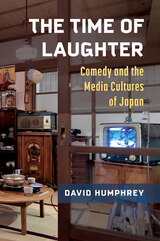 The Time of Laughter: Comedy and the Media Cultures of Japan
David Humphrey
University of Michigan Press, 2023 From broadcast to social media, comedy plays a prominent role in Japan’s cultural landscape and political landscape. The Time of Laughter explores how comedy grew out of the early days of television to become a central force in shaping Japanese media over the past half-century. Comedy and its impact, David Humphrey argues, established a “time of laughter” in the media of the late twentieth and early twenty-first centuries in Japan. Through masterful interrogation of Japanese televisual archives and media discourse, Humphrey demonstrates that the unique temporality of laughter has had a profound role in the cultural atmosphere of Japan’s recent past. Laughter both complemented and absorbed the profound tensions and contradictions that emerged in Japanese television. Joyous and cacophonous, reaffirming and subverting, laughter simultaneously alienated and unified viewers. Through its exploration of the influence of comedy and the culture of laughter, The Time of Laughter presents a vibrant new take on Japan’s recent media history.
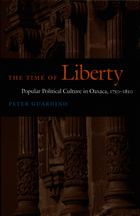 The Time of Liberty: Popular Political Culture in Oaxaca, 1750–1850
Peter Guardino
Duke University Press, 2005 Between 1750 and 1850 Spanish American politics underwent a dramatic cultural shift as monarchist colonies gave way to independent states based at least nominally on popular sovereignty and republican citizenship. In The Time of Liberty, Peter Guardino explores the participation of subalterns in this grand transformation. He focuses on Mexico, comparing local politics in two parts of Oaxaca: the mestizo, urban Oaxaca City and the rural villages of nearby Villa Alta, where the population was mostly indigenous. Guardino challenges traditional assumptions that poverty and isolation alienated rural peasants from the political process. He shows that peasants and other subalterns were conscious and complex actors in political and ideological struggles and that popular politics played an important role in national politics in the first half of the nineteenth century. Guardino makes extensive use of archival materials, including judicial transcripts and newspaper accounts, to illuminate the dramatic contrasts between the local politics of the city and of the countryside, describing in detail how both sets of citizens spoke and acted politically. He contends that although it was the elites who initiated the national change to republicanism, the transition took root only when engaged by subalterns. He convincingly argues that various aspects of the new political paradigms found adherents among even some of the most isolated segments of society and that any subsequent failure of electoral politics was due to an absence of pluralism rather than a lack of widespread political participation.
The Time of Miracles
Borislav Pekic
Northwestern University Press, 1994 Borislav Pekic spent six years in jail as a political prisoner, his only reading material the Bible. In 1965, ten years after his pardon, his first novel, The Time of Miracles, was published and became an overnight sensation. A set of parables based on the miracles of the New Testament, the book rewrites the story of Jesus from the perspective of Judas (who is obsessed with the idea prophecy must be fulfilled) and from that of the individuals upon whom miracles were performed--without their consent and, in most cases, to their eventual dissatisfaction. Filled with humor and poignancy, The Time of Miracles is a trenchant commentary on the power of ideology in one's life, upon what it means to hold beliefs, and upon the nature of faith.
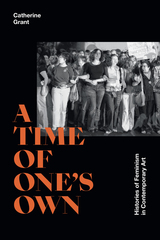 A Time of One's Own: Histories of Feminism in Contemporary Art
Catherine Grant
Duke University Press, 2022 In A Time of One’s Own Catherine Grant examines how contemporary feminist artists are turning to broad histories of feminism ranging from political organizing and artworks from the 1970s to queer art and activism in the 1990s. Exploring artworks from 2002 to 2017 by artists including Sharon Hayes, Mary Kelly, Allyson Mitchell, Deirdre Logue, Lubaina Himid, Pauline Boudry, and Renate Lorenz, Grant maps a revival of feminism that takes up the creative and political implications of forging feminist communities across time and space. Grant characterizes these artists’ engagement with feminism as a fannish, autodidactic, and collective form of learning from history. This fandom of feminism allows artists to build relationships with previous feminist ideas, artworks, and communities that reject a generational model and embrace aspects of feminism that might be seen as embarrassing, queer, or anachronistic. Accounting for the growing interest in feminist art, politics, and ideas across generations, Grant demonstrates that for many contemporary feminist artists, the present moment can only be understood through an embodied engagement with history in which feminist pasts are reinhabited and reimagined.
 The Time of the Goats
Luan Starova; Translated by Christina E. Kramer
University of Wisconsin Press, 2012 It’s the late 1940s in Skopje, Yugoslavia, in the critical year leading to Tito’s break with Stalin. Pushed to leave mountain villages to become the new proletariat in urban factories, a flood of peasants crowds into Skopje—and with them, all of their goats. Suffering from hunger, Skopje’s citizens welcome the newcomers. But municipal leaders are faced with a dilemma when the central government issues an order calling for the slaughter of the country’s goat population. With food so scarce, will they hide the outlawed animals? Or will they comply with the edict and endure the bite of hunger?
The Time of the Goats is the second novel in Luan Starova’s acclaimed multivolume Balkan saga. It follows the main characters from My Father’s Books and the tragicomic events of their lives in Skopje as the narrator’s intellectual father and the head goatherd become friends. As local officials clumsily carry out absurd policies, Starova conveys the bonds of understanding and mutual support that form in Skopje’s poorest neighborhoods. At once historical and allegorical, folkloric and fantastic, The Time of the Goats draws lyrically on Starova’s own childhood.
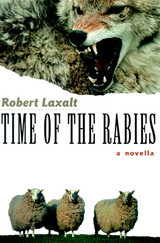 Time of the Rabies: A Novella
Robert Laxalt
University of Nevada Press, 2000 During the 1920s, a rabies epidemic swept across northern Nevada, decimating wildlife and livestock herds. This historic event is the background for acclaimed writer Robert Laxalt’s brilliant new novella. Set on a sheep ranch in the desert foothills near Carson City, Time of the Rabies follows owner Pete Lorda and his family and ranch hands as the epidemic swirls around them, pulling humans and animals into a battle against an invisible but deadly foe. Beginning when a roving coyote is bitten by a rabid bat, the epidemic spreads like wildfire through the local coyote population, and soon whole bands of rabid coyotes are attacking Lorda’s sheep flocks. As he and his hands struggle to protect the sheep, the disease appears on the home ranch itself, infecting first valued animals and then some of the hands. Once again, Robert Laxalt has produced a lively, unforgettable story of the West and its hardy people. No other writer has captured so vividly the character of the Basque sheepmen and their harsh, solitary lives, or the precarious community of a ranch besieged by an insidious, lethal enemy. Laxalt’s genius seems to grow with each new work, and Time of the Rabies is the creation of a major writer at the peak of his powers. This is a tale of the true West, full of authentic heroes and the memorable sense of place that only a writer as skilled and experienced as Laxalt can create.
 A Time of Youth: San Francisco, 1966–1967
William Gedney
Duke University Press, 2021 A year before 1967's famed Summer of Love, documentary photographer William Gedney set out for San Francisco on a Guggenheim Fellowship to record “aspects of our culture which I believe significant and which I hope will become, in time, part of the visual record of American history.” A Time of Youth brings together eighty-seven of the more than two thousand photographs Gedney took in San Francisco's Haight-Ashbury neighborhood between October 1966 and January 1967. In these photographs Gedney documents the restless and intertwined lives of the disenchanted youth who flocked to what became the epicenter of 1960s counterculture. Gedney lived among these young people in their communal homes, where he captured the intimate and varied contours of everyday life: solitude and companionship, joyous celebration and somber quiet, cramped rooms and spacious parks, recreation and contemplation. In these images Gedney presents a portrait of a San Francisco counterculture that complicates popular depictions of late 1960s youth as carefree flower children. The book also includes facsimiles of handwritten descriptions of the scenes Gedney photographed, his thoughts on organizing the book, and other ephemera.
 Time Out of Joint: The Queer and the Customary in Africa
Kirk Fiereck, Neville Hoad, and Danai Mupotsa, special issue editors
Duke University Press Contributors to this special issue investigate how queer theory might change when African texts, experiences, and concepts are placed front and center rather than treated as examples or case studies. The authors consider what the concept of customary does to the dialectic of tradition and modernity that is at the heart of much Africanist scholarship. Can queer theoretical texts travel beyond the North Atlantic world that made them without reproducing imperial ways of knowing? Can there be an African queer theory? In posing these questions, the authors encourage readers to consider queerness from and within Africa, exploring what African customary forms of gender and sexuality might do to the anti-normativity of queer theory and how presumptions within Euro-American queer scholarship contribute to Afro-pessimist and/or Afro-optimist scholarship.
Contributors. Cal (Crystal) Biruk, Laura Edmondson, Kirk Fiereck, Neville Hoad, Phoebe Kisubi, Keguro Macharia, Danai Mupotsa, Edgar Nabutanyi, Eddie Ombagi, Ruth Ramsden-Karelse
Time Passages: Collective Memory and American Popular Culture
George Lipsitz
University of Minnesota Press, 2001 The classic work on collective memory and popular culture in the United States. Probes the complicated relationship between postwar America between historical memory and commercial culture—popular television, music, and film.
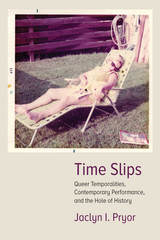 Time Slips: Queer Temporalities, Contemporary Performance, and the Hole of History
Jaclyn I. Pryor
Northwestern University Press, 2017 This bold book investigates how performance can transform the way people perceive trauma and memory, time and history. Jaclyn I. Pryor introduces the concept of "time slips," moments in which past, present, and future coincide, moments that challenge American narratives of racial and sexual citizenship.
Framing performance as a site of resistance, Pryor analyzes their own work and that of four other queer artists—Ann Carlson, Mary Ellen Strom, Peggy Shaw, and Lisa Kron—between 2001 and 2016. Pryor illuminates how each artist deploys performance as a tool to render history visible, trauma recognizable, and transformation possible by laying bare the histories and ongoing systems of violence woven deep into our society. Pryor also includes a case study that examines the challenges of teaching queer time and queer performance within the academy in what Pryor calls a post-9/11 “homeland” security state.
Masterfully synthesizing a wealth of research and experiences, Time Slips will interest scholars and readers in the fields of theater and performance studies, queer studies, and American studies.
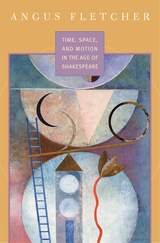 Time, Space, and Motion in the Age of Shakespeare
Angus Fletcher
Harvard University Press, 2006 Theirs was a world of exploration and experimentation, of movement and growth--and in this, the thinkers of the Renaissance, poets and scientists alike, followed their countrymen into uncharted territory and unthought space. A book that takes us to the very heart of the enterprise of the Renaissance, this closely focused but far-reaching work by the distinguished scholar Angus Fletcher reveals how early modern science and English poetry were in many ways components of one process: discovering and expressing the secrets of motion, whether in the language of mathematics or verse.
Throughout his book, Fletcher is concerned with one main crisis of knowledge and perception, and indeed cognition generally: the desire to find a correct theory of motion that could only end with Newton's Laws. Beginning with the achievement of Galileo--which changed the world--Time, Space, and Motion identifies the problem of motion as the central cultural issue of the time, pursued through the poetry of the age, from Marlowe and Shakespeare to Ben Jonson and Milton, negotiated through the limits and the limitless possibilities of language much as it was through the constraints of the physical world.
Time, the Familiar Stranger
J. Fraser
University of Massachusetts Press, 2012 We are currently updating our website and have not yet posted complete information for this title. Many of our books are in the Google preview program, which allows readers to view up to 20% of the book. If this title is active in the program, you will find the Google Preview button in the sidebar below.
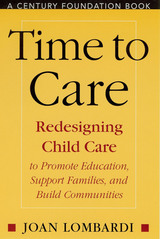 Time To Care: Redesigning Child Care To Promote Education,
Joan Lombardi
Temple University Press, 2002 In this important work, Joan Lombardi, one of Americas foremost experts on child care, shows how our current system is not meeting the needs of America's families and describes a vision for redesigning this system to promote healthy child and youth development. Both as an expert and as a parent, the author guides the reader through the problems that face the current child care system and outlines the possible solutions. Drawing on the most recent innovations from across the country, she offers fresh ideas for improving the quality and availability of child care, both for young children and those in after school programs.From renewal of welfare reform to the administration's efforts to promote literacy, debate at both the state and federal levels about child care will continue for the foreseeable future. Joan Lombardi shows how to bridge the gap between early education and child care by taking advantage of the hours that children spend in care to encourage child and youth development and by creating a system of program and community supports to improve quality.
 A Time to Gather Stones
Vladimir Soloukhin, Translated from the Russian and with an Introduction by Valerie Z. Nollan
Northwestern University Press, 1993
A Time to Gather Stones is a collection of five essays on cultural, historical, and environmental preservation. Vladimir Soloukhin is well known as one of the founders of the "village prose" movement in Soviet Russian literature. Like other village prose writers, he is disturbed by the ravages of the natural environment caused by planned yet ecologically irresponsible industrialization, and by the willful neglect of both agriculture and rural values. Like them, he is also outraged at the systematic destruction of Russia's monuments and cultural artifacts. In their documentary nature and range of subjects the essays in A Time to Gather Stones expound upon the insights, but also expand the parameters, of the village prose genre. The title essay is an account of the famous Optina monastery, its history and founding, and its fate during the years of Soviet rule.
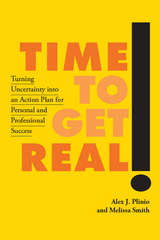 Time to Get Real!: Turning Uncertainty into an Action Plan for Personal and Professional Success
Alex J. Plinio
Rutgers University Press, 2019 You chose this book because there are important things on your mind. This is a market and time-tested guide to leading an intentional life. Our Life and Career Planning Model requires attention and work on your part but the time and effort will pay off. It’s Time to Get Real! helps you take control, directing you through a process leading to actions that result in personal and professional success. Manage unforeseen challenges with resilience, confidence, and self-direction. Make decisions and choices that create opportunities for you. Integrate your life and career and build the future that you desire.
The Life and Career Planning Model in Time to Get Real! has been utilized by individuals in early, mid and later career and life. Too many individuals let life happen to them. Control more of your life through readiness and preparation. We can help you visualize a future that you desire and a road that you can travel to get there.
Written by Alex J. Plinio, and Melissa Smith, acclaimed business leaders and life and career planning specialists, this book is filled with instructive case studies, illuminating stories, interactive exercises, and inspirational quotes enabling you to unlock those things leading to personal satisfaction and success. The Life and Career Planning Model helps you target what matters the most to you in your life while providing the impetus to move you forward in a positive direction. Whether you are 21, 41, or 61, it is now Time to Get Real!
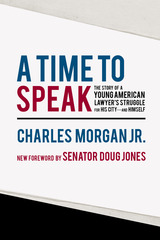 A Time to Speak: The Story of a Young American Lawyer's Struggle for His City—and Himself
Charles Morgan Jr., With a New Foreword by Senator Doug Jones
University of Alabama Press, 2022 Brings back into print a classic account of courage and calamity in the long march toward racial justice in the South, and the nation
On September 15, 1963, a bomb exploded at the Sixteenth Street Baptist Church in Birmingham, Alabama, killing four young Black girls. The very next day, a prominent white lawyer named Charles Morgan Jr. was scheduled to speak at a luncheon held by the Young Men’s Business Club of Birmingham. A well-regarded figure in the city’s legal and business establishment, Morgan had been mentioned frequently as a candidate for political office. To the shock of his longtime friends and associates, Morgan deviated from his planned remarks, instead using his platform to place the blame for the murder of the four young girls squarely on the shoulders of the city’s white middle-class establishment, those seated before him.
As much as his stand was admired nationally, in Birmingham the results were destructive for him personally. Threats against his life and the lives of his family poured in daily by phone and mail, his political career was finished, and he was faced with financial ruin. Within weeks, he moved his family out of the state, and thenceforward committed himself to legal action in the name of racial justice. In 1964, he established the regional office of the ACLU in Atlanta. In the 1964 Supreme Court case Reynolds v. Sims, Morgan successfully argued that districts in state legislatures needed to be of nearly equal size, establishing the principle of “one man, one vote” to effectively end the use of gerrymandering.
A Time to Speak was originally published in 1964, a mere year after Morgan and his family fled Birmingham. The memoir recounts not only his speech, but his entire upbringing and the political, cultural, and social milieus in which he was raised and which gave rise to the cowardice, institutional silence, fear, and hate that those conditions nursed. This new edition features a foreword from US Senator Doug Jones.
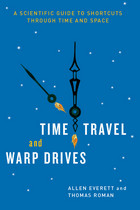 Time Travel and Warp Drives: A Scientific Guide to Shortcuts through Time and Space
Allen Everett and Thomas Roman
University of Chicago Press, 2011 To see video demonstrations of key concepts from the book, please visit this website: http://www.press.uchicago.edu/sites/timewarp/
Sci-fi makes it look so easy. Receive a distress call from Alpha Centauri? No problem: punch the warp drive and you're there in minutes. Facing a catastrophe that can't be averted? Just pop back in the timestream and stop it before it starts. But for those of us not lucky enough to live in a science-fictional universe, are these ideas merely flights of fancy—or could it really be possible to travel through time or take shortcuts between stars?
Cutting-edge physics may not be able to answer those questions yet, but it does offer up some tantalizing possibilities. In Time Travel and Warp Drives, Allen Everett and Thomas A. Roman take readers on a clear, concise tour of our current understanding of the nature of time and space—and whether or not we might be able to bend them to our will. Using no math beyond high school algebra, the authors lay out an approachable explanation of Einstein's special relativity, then move through the fundamental differences between traveling forward and backward in time and the surprising theoretical connection between going back in time and traveling faster than the speed of light. They survey a variety of possible time machines and warp drives, including wormholes and warp bubbles, and, in a dizzyingly creative chapter, imagine the paradoxes that could plague a world where time travel was possible—killing your own grandfather is only one of them!
Written with a light touch and an irrepressible love of the fun of sci-fi scenarios—but firmly rooted in the most up-to-date science, Time Travel and Warp Drives will be a delightful discovery for any science buff or armchair chrononaut.
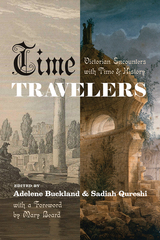 Time Travelers: Victorian Encounters with Time and History
Edited by Adelene Buckland and Sadiah Qureshi
University of Chicago Press, 2020 The Victorians, perhaps more than any Britons before them, were diggers and sifters of the past. Though they were not the first to be fascinated by history, the intensity and range of their preoccupations with the past were unprecedented and of lasting importance. The Victorians paved the way for our modern disciplines, discovered the primeval monsters we now call the dinosaurs, and built many of Britain’s most important national museums and galleries. To a large degree, they created the perceptual frameworks through which we continue to understand the past.
Out of their discoveries, new histories emerged, giving rise to fresh debates, while seemingly well-known histories were thrown into confusion by novel tools and methods of scrutiny. If in the eighteenth century the study of the past had been the province of a handful of elites, new technologies and economic development in the nineteenth century meant that the past, in all its brilliant detail, was for the first time the property of the many, not the few. Time Travelers is a book about the myriad ways in which Victorians approached the past, offering a vivid picture of the Victorian world and its historical obsessions.
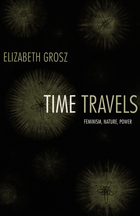 Time Travels: Feminism, Nature, Power
Elizabeth Grosz
Duke University Press, 2005 Recently the distinguished feminist theorist Elizabeth Grosz has turned her critical acumen toward rethinking time and duration. Time Travels brings her trailblazing essays together to show how reconceptualizing temporality transforms and revitalizes key scholarly and political projects. In these essays, Grosz demonstrates how imagining different relations between the past, present, and future alters understandings of social and scientific projects ranging from theories of justice to evolutionary biology, and she explores the radical implications of the reordering of these projects for feminist, queer, and critical race theories. Grosz’s reflections on how rethinking time might generate new understandings of nature, culture, subjectivity, and politics are wide ranging. She moves from a compelling argument that Charles Darwin’s notion of biological and cultural evolution can potentially benefit feminist, queer, and antiracist agendas to an exploration of modern jurisprudence’s reliance on the notion that justice is only immanent in the future and thus is always beyond reach. She examines Henri Bergson’s philosophy of duration in light of the writings of Gilles Deleuze, Maurice Merleau-Ponty, and William James, and she discusses issues of sexual difference, identity, pleasure, and desire in relation to the thought of Deleuze, Friedrich Nietzsche, Michel Foucault, and Luce Irigaray. Together these essays demonstrate the broad scope and applicability of Grosz’s thinking about time as an undertheorized but uniquely productive force.
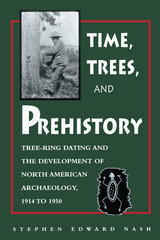 Time, Trees, and Prehistory: Tree Ring dating and the Development of NA Archaeology 1914 to 1950
Stephen E Nash
University of Utah Press, 2006 Dendrochronology, the science of assigning precise calendar dates to annual growth rings in trees, provided accurate dates at a time when North American archaeologists had no absolute dating techniques available to guide their analyses. Time, Trees, and Prehistory examines the growth, development, application, and interpretive implications of North American archaeological tree-ring dating from 1914 to 1950. The development of dendrochronology forced archaeologists to radically revise their understanding of the prehistoric past, compressing by nearly fifty percent the time scale of the archaeological record. Basketmaker sites, for instance, were once thought to be four thousand years old; tree-ring application demonstrated that these sites dated well into the present millennium. Classic sites in Chaco Canyon and Mesa Verde were believed occupied for nearly a thousand years, but tree-ring dates demonstrated that such sites were often built, occupied, and abandoned in just over a century. Other similar changes in temporal scale forced archaeologists to reconsider their interpretations of the rate of prehistoric cultural change, population growth, and the degree of social and political complexity in the Southwest. Time, Trees, and Prehistory examines archaeological practices of the 1920s, 30s, and 40s and demonstrates that tree-ring dating set the stage that enabled revolutionary developments in archaeological method and theory in succeeding decades.
Time, Tripods, Textiles, and Trees: Metaphors and Metonyms that Construct the Homeric Odyssey
Aldo Bottino
Harvard University Press Time, Tripods, Textiles, and Trees focuses on metaphorical and metonymical elements in key episodes and passages of the Odyssey to better understand the architecture of the epic and its causation. Beginning with an investigation of the trees gifted by Laertes to Odysseus and moving to the reunion of father and son in Book 24, Aldo Bottino combines cognitive science and discourse studies, along with oral poetics frameworks developed by Parry-Lord, Gregory Nagy, and Douglas Frame, to offer a new interpretation of the imaginative devices at the core of crucial episodes in Homer’s poem.
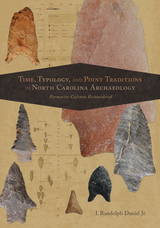 Time, Typology, and Point Traditions in North Carolina Archaeology: Formative Cultures Reconsidered
I. Randolph Daniel Jr.
University of Alabama Press, 2021 A reconsideration of the seminal projectile point typology
In the 1964 landmark publication The Formative Cultures of the Carolina Piedmont, Joffre Coe established a projectile point typology and chronology that, for the first time, allowed archaeologists to identify the relative age of a site or site deposit based on the point types recovered there. Consistent with the cultural-historical paradigm of the day, the “Coe axiom” stipulated that only one point type was produced at one moment in time in a particular location. Moreover, Coe identified periods of “cultural continuity” and “discontinuity” in the chronology based on perceived similarities and differences in point styles through time.
In Time, Typology, and Point Traditions in North Carolina Archaeology: Formative Cultures Reconsidered, I. Randolph Daniel Jr. reevaluates the Coe typology and sequence, analyzing their strengths and weaknesses. Daniel reviews the history of the projectile point type concept in the Southeast and revisits both Coe’s axiom and his notions regarding cultural continuity and change based on point types. In addition, Daniel updates Coe’s typology by clarifying or revising existing types and including types unrecognized in Coe’s monograph. Daniel also adopts a practice-centered approach to interpreting types and organizes them into several technological traditions that trace ancestral-descendent communities of practice that relate to our current understanding of North Carolina prehistory.
Appealing to professional and avocational archaeologists, Daniel provides ample illustrations of points in the book as well as color versions on a dedicated website. Daniel dedicates a final chapter to a discussion of the ethical issues related to professional archaeologists using private artifact collections. He calls for greater collaboration between professional and avocational communities, noting the scientific value of some private collections.
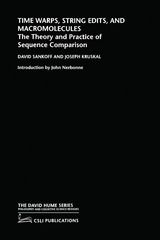 Time Warps, String Edits, and Macromolecules: The Theory and Practice of Sequence Comparision
David Sankoff and Joseph Kruskal
CSLI, 1983 Time Warps, String Edits and Macromolecules is a young classic in computational science. The computational perspective is that of sequence processing, in particular the problem of recognizing related sequences. The book is the first, and still best compilation of papers explaining how to measure distance between sequences, and how to compute that measure effectively. This is called string distance, Levenshtein distance, or edit distance. The book contains lucid explanations of the basic techniques; well-annotated examples of applications; mathematical analysis of its computational (algorithmic) complexity; and extensive discussion of the variants needed for weighted measures, timed sequences (songs), applications to continuous data, comparison of multiple sequences and extensions to tree-structures. This theory finds applications in molecular biology, speech recognition, analysis of bird song and error correcting in computer software.
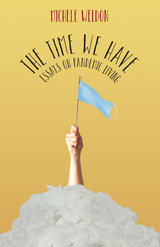 The Time We Have: Essays on Pandemic Living
Michele Weldon
Northwestern University Press, 2024 A candid and cathartic exploration of pandemic life, from family to pop culture to healthcare—and beyond
At a time when so many are dealing with collective and personal grief, award-winning author and journalist Michele Weldon’s new collection of essays navigates the revelatory and upending nature of this extraordinary pandemic era through a lens of love and connection. Weldon explores pain and pleasure alike with emotional texture, empathy, wisdom, vulnerability, and humor. She interrogates moments of joy, despair, and triumph, offering readers the possibility for a richly cathartic experience. With honesty and agility, Weldon creates poignant intersections of her narrative with popular culture, history, media, news, consumerism, family traditions, and healthcare. Employing honest and daring language, Weldon examines the concepts of safety, importance of beloved objects, power of words, shift to remote relationships, concepts of feminism, betrayal of public lies, and more. Ultimately, with grace and heart, Weldon offers in these essays useful pathways toward framing this swath of time so that we might arrive at a sense of understanding, belonging, and peace with our new realities.
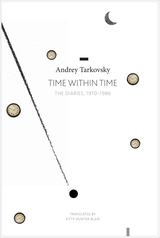 Time within Time: The Diaries, 1970–1986
Andrei Tarkovsky
Seagull Books, 2019 “Tarkovsky for me is the greatest,” wrote Ingmar Bergman. Andrey Tarkovsky only made seven films, but all are celebrated for its striking visual images, quietly patient dramatic structures, and visionary symbolism.
Time within Time is both a diary and a notebook, maintained by Tarkovsky from 1970 until his death. Intense and intimate, it offers reflections on Dostoyevsky, Tolstoy, Hermann Hesse, Thomas Mann, and others. He writes movingly of his family, especially his father, Arseniy Tarkovsky, whose poems appear in his films. He records haunting dreams in detail and speaks of the state of society and the future of art, noting significant world events and purely personal dramas along with fascinating accounts of his own filmmaking. Rounding out this volume are Tarkovsky’s plans and notes for his stage version of Hamlet; a detailed proposal for a film adaptation of Dostoyevsky’s The Idiot; and a glimpse of the more public Tarkovsky answering questions put to him by interviewers.
Time, Work, and Culture in the Middle Ages
Jacques Le Goff
University of Chicago Press, 1980 Jacques Le Goff is a prominent figure in the tradition of French medieval scholarship, profoundly influenced by the Annales school, notably, Bloch, Febvre, and Braudel, and by the ethnographers and anthropologists Mauss, Dumézil, and Lévi-Strauss. In building his argument for "another Middle Ages" (un autre moyen âge), Le Goff documents the emergence of the collective mentalité from many sources with scholarship both imaginative and exact.
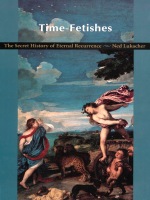 Time-Fetishes: The Secret History of Eternal Recurrence
Ned Lukacher
Duke University Press, 1999 For over two and a half millennia human beings have attempted to invent strategies to “discover” the truth of time, to determine whether time is infinite, whether eternity is the infinite duration of a continuous present, or whether it too rises and falls with the cycles of universal creation and destruction. Time-Fetishes recounts the history of a tradition that runs counter to the dominant tradition in Western metaphysics, which has sought to purify eternity of its temporal character. From the pre-Socratics to Ovid and Plotinus, and from Shakespeare to Hegel, Schelling, Nietzsche, Heidegger, and Derrida, Time-Fetishes traces the secret tradition of the idea of eternal recurrence and situates it as the grounding thought of Western philosophy and literature. The thinkers in this counter-history of the eternal return lingered long enough on the question of time to learn how to resist separating eternity from time, and how to reflect on the possible identity of time and eternity as a way of resisting all prior metaphysical determinations. Drawing out the implications of Nietzsche’s reinvention of the doctrine of return, Lukacher ranges across a broad spectrum of ancient and modern thinkers. Shakespeare’s role in this history as the “poet of time” is particularly significant, for not only does Shakespeare reactivate the pre-Christian arguments of eternal return, he regards them, and all arguments and images concerning the essence of time and Being, from an inimitably ironic perspective. As he makes transitions from literature to philosophy and psychoanalysis, Lukacher displays a theoretical imagination and historical vision that bring to the forefront a host of pre- and post-Christian texts in order to decipher in them an encounter with the thought of eternal recurrence that has been too long buried under layers of rigid metaphysical interpretation.
Time-Limited Psychotherapy
James Mann
Harvard University Press, 1973 Waiting lists in psychiatric clinics and increasing numbers of patients in long-term psychotherapy have highlighted the need for shorter methods of treatment. Existing forms of short-term psychotherapy tend to be vague and uncertain, lacking as they do a clearly formulated rationale and methodology.
The bold and challenging technique for brief psychotherapy designed around the factor of time itself, which James Mann introduces here, is a method he hopes will revolutionize current practice. The significance of time in human life is examined in terms of the development of time sense as well as its unconscious meaning and the ways these are experienced in both the categorical and existential senses. The author shows how the interplay between the regressive pressures of the child’s sense of infinite time and the adult reality of categorical time determine the patient’s unconscious expectations of psychotherapy.
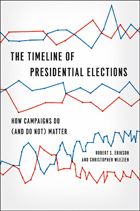 The Timeline of Presidential Elections: How Campaigns Do (and Do Not) Matter
Robert S. Erikson and Christopher Wlezien
University of Chicago Press, 2012 In presidential elections, do voters cast their ballots for the candidates whose platform and positions best match their own? Or is the race for president of the United States come down largely to who runs the most effective campaign? It’s a question those who study elections have been considering for years with no clear resolution. In The Timeline of Presidential Elections, Robert S. Erikson and Christopher Wlezien reveal for the first time how both factors come into play. Erikson and Wlezien have amassed data from close to two thousand national polls covering every presidential election from 1952 to 2008, allowing them to see how outcomes take shape over the course of an election year. Polls from the beginning of the year, they show, have virtually no predictive power. By mid-April, when the candidates have been identified and matched in pollsters’ trial heats, preferences have come into focus—and predicted the winner in eleven of the fifteen elections. But a similar process of forming favorites takes place in the last six months, during which voters’ intentions change only gradually, with particular events—including presidential debates—rarely resulting in dramatic change. Ultimately, Erikson and Wlezien show that it is through campaigns that voters are made aware of—or not made aware of—fundamental factors like candidates’ policy positions that determine which ticket will get their votes. In other words, fundamentals matter, but only because of campaigns. Timely and compelling, this book will force us to rethink our assumptions about presidential elections.
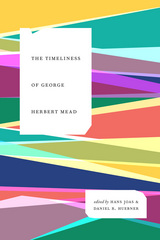 The Timeliness of George Herbert Mead
Edited by Hans Joas and Daniel R. Huebner
University of Chicago Press, 2016 George Herbert Mead is widely considered one of the most influential American philosophers of the twentieth century, and his work remains vibrant and relevant to many areas of scholarly inquiry today. The Timeliness of George Herbert Mead brings together a range of scholars who provide detailed analyses of Mead’s importance to innovative fields of scholarship, including cognitive science, environmental studies, democratic epistemology, and social ethics, non-teleological historiography, and the history of the natural and social sciences.
Edited by well-respected Mead scholars Hans Joas and Daniel R. Huebner, the volume as a whole makes a coherent statement that places Mead in dialogue with current research, pushing these domains of scholarship forward while also revitalizing the growing literature on an author who has an ongoing and major influence on sociology, psychology, and philosophy.
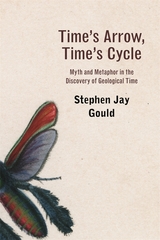 Time’s Arrow, Time’s Cycle: Myth and Metaphor in the Discovery of Geological Time
Stephen Jay Gould
Harvard University Press, 1988 Rarely has a scholar attained such popular acclaim merely by doing what he does best and enjoys most. But such is Stephen Jay Gould’s command of paleontology and evolutionary theory, and his gift for brilliant explication, that he has brought dust and dead bones to life, and developed an immense following for the seeming arcana of this field.
In Time’s Arrow, Time’s Cycle his subject is nothing less than geology’s signal contribution to human thought—the discovery of “deep time,” the vastness of earth’s history, a history so ancient that we can comprehend it only as metaphor. He follows a single thread through three documents that mark the transition in our thinking from thousands to billions of years: Thomas Burnet’s four-volume Sacred Theory of the Earth (1680–1690), James Hutton’s Theory of the Earth (1795), and Charles Lyell’s three-volume Principles of Geology (1830–1833).
Gould’s major theme is the role of metaphor in the formulation and testing of scientific theories—in this case the insight provided by the oldest traditional dichotomy of Judeo-Christian thought: the directionality of time’s arrow or the immanence of time’s cycle. Gould follows these metaphors through these three great documents and shows how their influence, more than the empirical observation of rocks in the field, provoked the supposed discovery of deep time by Hutton and Lyell. Gould breaks through the traditional “cardboard” history of geological textbooks (the progressive march to truth inspired by more and better observations) by showing that Burnet, the villain of conventional accounts, was a rationalist (not a theologically driven miracle-monger) whose rich reconstruction of earth history emphasized the need for both time’s arrow (narrative history) and time’s cycle (immanent laws), while Hutton and Lyell, our traditional heroes, denied the richness of history by their exclusive focus upon time’s arrow.
 Times Beach
John Shoptaw
University of Notre Dame Press, 2015
“Times Beach is brimming, teeming with life. John Shoptaw, with breathtaking expanse and lasting intricacy, somehow writes a book in which we traverse the vastness of the American landscape—its gorgeous yet misguided rivers, its achingly honest and flawed humans, its forgotten bayous and wildlife—with a hand made nimble by reverence. In this, he revivifies American poetry into an optimism that is nearly as infinite as it is pained. This, however, is the only true kind of optimism, and how good it is to have a book of poetry that restores us into that abundance.” —Katie Ford, author of Colosseum and Blood Lyrics
“Times Beach is, like most interesting American books, an original. It’s about a place, the watershed of the Mississippi River, and it is an ecopoetics. Best, perhaps, to think of it as a hybrid of Hart Crane, the depression photographs of Dorothea Lange, and a nineteenth-century lantern show—they called them ‘panoramas’—of the human and environmental history of our mightiest river system. It comes from a deep sense of the rhythms and dialect of a place and from a deeply literary and inventive imagination.” —Robert Hass, poet laureate of the United States (1995–1997) and author of The Apple Trees at Olema: New and Selected Poems
Winner of the Notre Dame Review Book Prize, this ambitious collection of poems evokes the cultural and environmental history of the Mississippi watershed and meditates on how its rivers are ceaselessly shaping, and shaped by, the lives around them. John Shoptaw guides us from the Mississippi’s headwaters in Lake Itasca to its delta in the Gulf of Mexico, weaving together episodes in the life of the river system—the New Madrid earthquakes, the 1927 flood, the EPA’s eradication of the dioxin-laced town of Times Beach—with his own memories of growing up in the Missouri Bootheel: picking cotton, being baptized in a drainage ditch, and working in a lumber mill. Formally renovative, the poems in Times Beach ring the changes on the big muddy place and hymn its everlasting possibilities.
Time’s Covenant: The Essays and Sermons of William Clancy
William Clancy
University of Pittsburgh Press, 1987 Time's Covenant offers a collection of the sermons and essays of William Clancy, one of the most vehement opponents of McCarthyism, who was also an ardent civil libertarian and literate commentator on the changing times of the 1950s and 1960s. The articles originally appeared in Commonweal, dubbed the journal of “liberal Catholics,” as well as the New York Times, Saturday Review and Worldview. Clancy reflects on authors Ignazio Silone, Arnold Toynbee, Walter Lippman, as well as American poets, the Dreyfus Affair, and liberal Catholicism.
Time's Fancy
Ronald Wallace
University of Pittsburgh Press, 1994
Winner of the 1995 Banta Book Prize for a Wisconsin Author
Ronald Wallace is best known for his wit and good humor, his synthesis of technical skill and strong emotion, his sensory immediacy, his accessibility, and charm. Now in Time's Fancy, his fifth collection, Wallace explores the tragic aspects of life more fully, fashioning a declarative poetry that is darker and deeper, more meditative and complex.
 Time’s Monster: How History Makes History
Priya Satia
Harvard University Press, 2020 A New Statesman Best Book of the Year
“Powerful and radically important.”
—Robert Gildea, Times Literary Supplement
“Bracingly describes the ways imperialist historiography has shaped visions of the future as much as the past.”
—Pankaj Mishra, New York Review of Books
“An account of how the discipline of history has itself enabled the process of colonization…A coruscating and important reworking of the relationship between history, historians, and empire.”
—Kenan Malik, The Guardian
For generations, the history of the British Empire was written by its victors, whose accounts of conquest guided the consolidation of imperial rule in India, the Middle East, Africa, and the Caribbean. British historians’ narratives of the development of imperial governance licensed the brutal suppression of colonial rebellion. Their reimagining of empire during the two world wars compromised decolonization. In this brilliant work, Priya Satia shows how these historians not only interpreted the major political events of their time but also shaped the future that followed.
From the imperial histories of John Stuart Mill and Winston Churchill to the works of anticolonial thinkers such as William Blake, Mahatma Gandhi, and E. P. Thompson, Satia captures two opposing approaches to the discipline of history and illuminates the ethical universe that came with them. Against the backdrop of enduring inequalities and a crisis in the humanities, hers is an urgent moral voice.
Times of History: Universal Topics in Islamic Historiography
Aziz Al-Azmeh
Central European University Press, 2007 This is a collection of essays on current questions of historiography, illustrated with reference to Islamic historiography. The main concerns are conceptions of time and temporality, the uses of the past, historical periodisation, historical categorisation, and the constitution of historical objects, not least those called "civilisation" and "Islam". One of the aims of the book is to apply to Islamic materials the standard conceptual equipment used in historical study, and to exercise a large-scale comparativist outlook.
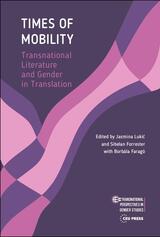 Times of Mobility: Transnational Literature and Gender in Translation
Jasmina Lukic
Central European University Press, 2020 In an era of increased mobility and globalisation, a fast growing body of writing originates from authors who live in-between languages and cultures. In response to this challenge, transnational perspective offers a new approach to the growing body of cultural texts with an emphasis on experiences of migration, transculturation, bilingualism and (cultural) translation. The introductory analysis and the fifteen essays in this collection critically interrogate complex relations between transnational and translation studies, bringing to this dialogue a much needed gender perspective. Divided into three parts (From Transnational to Translational; Reading Across Borders and Transnational in Translation), they address a range of issues relevant for this debate, from theoretical problems to practical questions of literary criticism and translation, understood as an act of cultural interpretation. The volume mostly deals with contemporary literary and cultural production, but also with classical texts and modernist literature. Its particular quality is a strong (although not exclusive) focus on Central and East European literatures, and more generally on women writers. Its interdisciplinary, transnational and intercultural perspective makes it relevant across disciplinary boundaries, from literary and translation studies to gender studies, cultural studies and migration studies.
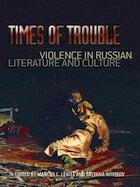 Times of Trouble: Violence in Russian Literature and Culture
Edited by Marcus C. Levitt and Tatyana Novikov
University of Wisconsin Press, 2007 From the country that has added to our vocabulary such colorful terms as "purges," "pogroms," and "gulag," this collection investigates the conspicuous marks of violence in Russian history and culture.
Russians and non-Russians alike have long debated the reasons for this endemic violence. Some have cited Russia's huge size, unforgiving climate, and exposed geographical position as formative in its national character, making invasion easy and order difficult. Others have fixed the blame on cultural and religious traditions that spurred internecine violence or on despotic rulers or unfortunate episodes in the nation's history, such as the Mongol invasion, the rule of Ivan the Terrible, or the "Red Terror" of the revolution. Even in contemporary Russia, the specter of violence continues, from widespread mistreatment of women to racial antagonism, the product of a frustrated nationalism that manifests itself in such phenomena as the wars in Chechnya.
Times of Trouble is the first in English to explore the problem of violence in Russia. From a variety of perspectives, essays investigate Russian history as well as depictions of violence in the visual arts and in literature, including the works of Fyodor Dostoevsky, Isaac Babel, Mikhail Lermontov, and Nina Sadur. From the Mongol invasion to the present day, topics include the gulag, genocide, violence against women, anti-Semitism, and terrorism as a tool of revolution.
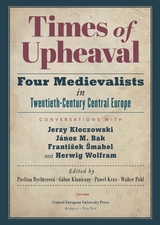 Times of Upheaval: Four Medievalists in Twentieth-Century Central Europe. Conversations with Jerzy Kloczowski, János M. Bak, František Šmahel, and Herwig Wolfram
Pavlína Rychterová
Central European University Press, 2019 The volume unites conversations with four masters of Medieval Studies from east-central Europe: János Bak from Hungary, Jerzy Kloczowski from Poland, František Šmahel from the Czech Republic, and Herwig Wolfram from Austria. The interviews, made by younger colleagues, reveal engaging life stories, with numerous observations, anecdotes and experiences. The four scholars grew up before and during the war, under Nazi occupation, emerged as young scholars in the difficult post-war period, and, for most of their careers worked in the shadow of the Iron Curtain, two of them spending most of their lifetimes under communist regimes. The conversations focus on ways in which open-minded young intellectuals became medieval historians under difficult circumstances, how they experienced the long shadows of totalitarian regimes with their acute sensitivity for historical change, and how their perceptions of the world around them reflected back on their approach to medieval history. The histories of their nations were broken, most of them ceased to exist and then were re-established during their lifetimes, came under foreign domination, were split up, or had their territories shifted. These changes affected these scholars' identities and patriotic feelings, and their present was reflected in the distant mirror of the medieval past.
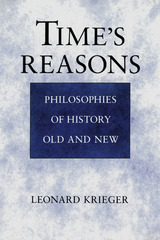 Time's Reasons: Philosophies of History Old and New
Leonard Krieger
University of Chicago Press, 1989 This original work caps years of thought by Leonard Krieger about the crisis of the discipline of history. His mission is to restore history's autonomy while attacking the sources of its erosion in various "new histories," which borrow their principles and methods from disciplines outside of history. Krieger justifies the discipline through an analysis of the foundations on which various generations of historians have tried to establish the coherence of their subject matter and of the convergence of historical patterns.
The heart of Krieger's narrative is an insightful analysis of theories of history from the classical period to the present, with a principal focus on the modern period. Krieger's exposition covers such figures as Ranke, Hegel, Comte, Marx, Acton, Troeltsch, Spengler, Braudel, and Foucault, among others, and his discussion involves him in subtle distinctions among terms such as historism, historicism, and historicity. He points to the impact on history of academic political radicalism and its results: the new social history. Krieger argues for the autonomy of historical principles and methods while tracing the importation in the modern period of external principles for historical coherence.
Time's Reasons is a profound attempt to rejuvenate and restore integrity to the discipline of history by one of the leading masters of nineteenth- and twentieth-century historiography. As such, it will be required reading for all historiographers and intellectual historians of the modern period.
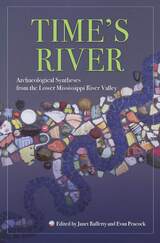 Time's River: Archaeological Syntheses from the Lower Mississippi Valley
Edited by Janet Rafferty and Evan Peacock
University of Alabama Press, 2008 An archaeologically rich region, in advance of impending disturbance This volume stands as a key general resource for archaeologists working in the region extending from Louisiana through Mississippi north to Missouri and Kentucky, and it represents an opportunity to influence for decades a large part of the archaeological work to take place in the Southeast. The book responds to a need for a comprehensive archaeological overview of the Lower Mississippi Valley that forms a portion of an interstate corridor spanning nine states that will run from southern Michigan to the Texas-Mexico border. The culturally sensitive Mississippi Delta is one of the richest archaeological areas in North America, and it is crucial that research designs be comprehensive, coordinated, and meet current preservation and future research needs. The authors are well-respected researchers from both within and outside the region with expertise in the full range of topics that comprise American archaeology. They examine matters of method and theory, the application of materials science, geophysics, and other high-tech tools in archaeology that provide for optimum data-recovery.
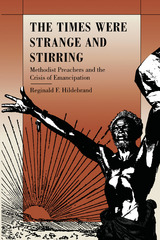 The Times Were Strange and Stirring: Methodist Preachers and the Crisis of Emancipation
Reginald F. Hildebrand
Duke University Press, 1995 With the conclusion of the Civil War, the beginnings of Reconstruction, and the realities of emancipation, former slaves were confronted with the possibility of freedom and, with it, a new way of life. In The Times Were Strange and Stirring, Reginald F. Hildebrand examines the role of the Methodist Church in the process of emancipation—and in shaping a new world at a unique moment in American, African American, and Methodist history.
Hildebrand explores the ideas and ideals of missionaries from several branches of Methodism—the African Methodist Episcopal Church, the Colored Methodist Episcopal Church, and the northern-based Methodist Episcopal Church—and the significant and highly charged battle waged between them over the challenge and meaning of freedom. He traces the various strategies and goals pursued by these competing visions and develops a typology of some of the ways in which emancipation was approached and understood.
Focusing on individual church leaders such as Lucius H. Holsey, Richard Harvey Cain, and Gilbert Haven, and with the benefit of extensive research in church archives and newspapers, Hildebrand tells the dramatic and sometimes moving story of how missionaries labored to organize their denominations in the black South, and of how they were overwhelmed at times by the struggles of freedom.
A Timeshare
Margaret Ross
Omnidawn, 2015 Margaret Ross’s debut unearths the corporeal in the most desolate reaches of corporate speech: Futures exchange. Human resources. Personal life. Lush and visceral, A Timeshare knows that questions and crises of individual existence are inextricably bound to shared experience and its deft music carries from the closest closet to outer space, touching the concrete through the metaphysical: it syncs the bed to the ocean, memory to zero-g, voicemail to lyric, killjar, dive bar, Lascaux, Antarctica, living and waiting rooms. What time is it? What’s time? Your shadow renders you a human sundial. "Countdown," the book begins.
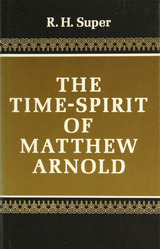 Time-Spirit of Matthew Arnold
R. H. Super
University of Michigan Press, 2025 The Time-Spirit of Matthew Arnold—his remarkable grasp of the main intellectual currents of the day—is the quality of mind that most recommends Arnold to the modern reader. Trained in the classics and theology, Arnold was able to evaluate the writings of his contemporaries in terms of the main traditions of Western thought, and by plotting the direction of intellectual currents in the past he could project the course of the main streams into the future. Dr. Super focuses on Arnold's achievement as a poet, a social political thinker, and a religious mind. He gives detailed treatment to Arnold's major poetical work, Empedocles on Etna; he analyzes Arnold's liberalism and contrasts it with the Utilitarianism of John Stuart Mill; and he examines Arnold's approach to Christianity in a penetrating discussion of Arnold's book Literature and Dogma. The Time-Spirit of Matthew Arnold demonstrates the impact such figures as Carlyle, Mill, and Newman had upon Arnold, as well as the more enduring cast his mind took from Goethe and Spinoza. Throughout, the book reveals the essential homogeneity of Arnold's work and its continued usefulness in dealing with twentieth-century problems in politics, education, and religion.
Timewalkers: The Prehistory of Global Colonization
Clive Gamble
Harvard University Press, 1994 Gamble reconsiders the remarkable record of geographical expansion that began with the early hominids of sub-Saharan Africa. Through this astonishing dispersal of humans, which exceeds that of all other mammals, he traces calculated responses to variations in climate and environment.
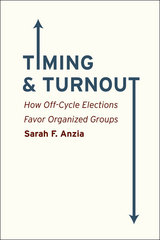 Timing and Turnout: How Off-Cycle Elections Favor Organized Groups
Sarah F. Anzia
University of Chicago Press, 2013 Public policy in the United States is the product of decisions made by more than 500,000 elected officials, and the vast majority of those officials are elected on days other than Election Day. And because far fewer voters turn out for off-cycle elections, that means the majority of officials in America are elected by a politically motivated minority of Americans. Sarah F. Anzia is the first to systemically address the effects of election timing on political outcomes, and her findings are eye-opening.
The low turnout for off-cycle elections, Anzia argues, increases the influence of organized interest groups like teachers’ unions and municipal workers. While such groups tend to vote at high rates regardless of when the election is held, the low turnout in off-cycle years enhances the effectiveness of their mobilization efforts and makes them a proportionately larger bloc. Throughout American history, the issue of election timing has been a contentious one. Anzia’s book traces efforts by interest groups and political parties to change the timing of elections to their advantage, resulting in the electoral structures we have today. Ultimately, what might seem at first glance to be mundane matters of scheduling are better understood as tactics designed to distribute political power, determining who has an advantage in the electoral process and who will control government at the municipal, county, and state levels.
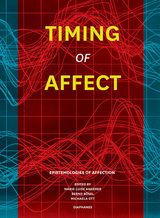 Timing of Affect: Epistemologies of Affection
Edited by Marie-Luise Angerer, Bernd Bösel, and Michaela Ott
Diaphanes, 2014 Affect, or the process by which emotions come to be embodied, is a burgeoning area of interest in both the humanities and the sciences. For Timing of Affect, Marie-Luise Angerer, Bernd Bösel, and Michaela Ott have assembled leading scholars to explore the temporal aspects of affect through the perspectives of philosophy, music, film, media, and art, as well as technology and neurology. The contributions address possibilities for affect as a capacity of the body; as an anthropological inscription and a primary, ontological conjunctive and disjunctive processes; as an interruption of chains of stimulus and response; and as an arena within cultural history for political, media, and psychopharmacological interventions. Showing how these and other temporal aspects of affect are articulated both throughout history and in contemporary society, the editors then explore the implications for the current knowledge structures surrounding affect today.
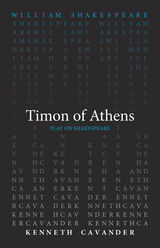 Timon of Athens
William Shakespeare
Arizona Center for Medieval and Renaissance Studies, 2021 In a respectful, but not reverent, adaptation, Kenneth Cavander reimagines Timon of Athens for the twenty-first century.
Never performed in Shakespeare’s lifetime, Timon of Athens presents an intriguing puzzle for contemporary audiences. The disjointed plot and many gaps in the story have led scholars to believe it was a collaboration between Shakespeare and Thomas Middleton, a younger writer known for his satires, and productions for decades have faced choices about the most effective way to present the play. In this translation, Cavander acts as a third playwright in this collaborative process. Wrangling the voices of Shakespeare and Middleton on the page, Cavander unveils poetic lines and phrases that have sat stubbornly in the cobwebs, cutting these voices through the time barrier and into the world as we know it.
This translation was written as part of the Oregon Shakespeare Festival’s Play On! project, which commissioned new translations of thirty-nine Shakespeare plays. These translations present the work of "The Bard" in language accessible to modern audiences while never losing the beauty of Shakespeare’s verse. These volumes make these works available for the first time in print—a new First Folio for a new era.
Timor-Leste’s Long Road to Independence: Transnational Perspectives
Zelia Pereira
Amsterdam University Press, 2023 From a much neglected Portuguese colony to independence, Timor-Leste travelled a belated, long and troubled journey that included a 24-year Indonesian occupation. A classic process of European decolonization (1974–1975) was followed by a nationalist struggle against “Third World Colonialism” (1975–1999), and a final phase under the direct aegis of the United Nations (1999–2002). More than a direct relation between coloniser and colonised, this turbulent process involved the participation of many different actors scattered around the world. The “Timor Issue” brought to the scene a martyred people’s determination, the diplomacy of several nations (friends or foes), the involvement of the United Nations, and the activism of solidarity networks. This collection adopts a transnational approach that highlights the complexity of Timor-Leste’s road to independence.
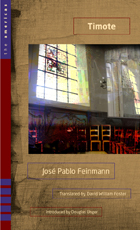 Timote: A Novel
José Pablo Feinmann; translated by David William Foster; introduction by Douglas Unger
Texas Tech University Press, 2012 This much is fact: at noon on May 29, 1970, Argentinean general and former president Pablo Eugenio Aramburu was abducted from his Buenos Aires apartment by the Montoneros, an urban guerilla group that supported the regime—and return—of exiled leader Juan Perón. Only after a month-long search was it discovered that the Montoneros had executed Aramburu three days after kidnapping him, leaving his corpse to rot inside a farmhouse in the remote hamlet of Timote.
José Pablo Feinmann’s brilliant fictionalization of this momentous event in Argentine history raises as many questions as it answers, about issues of ongoing global concern: nationalism, fundamentalism, terrorism, torture. Imagining the abduction, interrogation, and murder as a series of gripping dialogues between the captor Fernando and the captive general, Feinmann delivers readers deep into the psyches of warring ideological factions. Who are the Montoneros, who claim to represent an injured people? Who are Perón and his idolized late wife, who claimed to love their country? Who is Aramburu, who claims to protect democracy? Combining adroit political analysis with true-life characters, Timote illuminates for English-language readers a dark episode of history and a darker side of the human mind
Timothy Pickering and the American Republic
Gerard H. Clarfield
University of Pittsburgh Press, 1980 Timothy Pickering was an important figure in the early American republic. For more than fifty years, he was deeply entrenched in the political, military and diplomatic affairs of the young nation. He held important administrative posts during the Revolution, two cabinet posts, and served as a congressman, senator, and as a spokesman for the extremist element of New England's Federalists. Clarfield presents the first comprehensive biography of Pickering, and a critical assessment of this controversial and often intractable man.
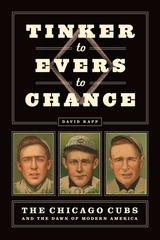 Tinker to Evers to Chance: The Chicago Cubs and the Dawn of Modern America
David Rapp
University of Chicago Press, 2018 Their names were chanted, crowed, and cursed. Alone they were a shortstop, a second baseman, and a first baseman. But together they were an unstoppable force. Joe Tinker, Johnny Evers, and Frank Chance came together in rough-and-tumble early twentieth-century Chicago and soon formed the defensive core of the most formidable team in big league baseball, leading the Chicago Cubs to four National League pennants and two World Series championships from 1906 to 1910. At the same time, baseball was transforming from small-time diversion into a nationwide sensation. Americans from all walks of life became infected with “baseball fever,” a phenomenon of unprecedented enthusiasm and social impact. The national pastime was coming of age.
Tinker to Evers to Chance examines this pivotal moment in American history, when baseball became the game we know today. Each man came from a different corner of the country and brought a distinctive local culture with him: Evers from the Irish-American hothouse of Troy, New York; Tinker from the urban parklands of Kansas City, Missouri; Chance from the verdant fields of California’s Central Valley. The stories of these early baseball stars shed unexpected light not only on the evolution of baseball and on the enthusiasm of its players and fans all across America, but also on the broader convulsions transforming the US into a confident new industrial society. With them emerged a truly national culture.
This iconic trio helped baseball reinvent itself, but their legend has largely been relegated to myths and barroom trivia. David Rapp’s engaging history resets the story and brings these men to life again, enabling us to marvel anew at their feats on the diamond. It’s a rare look at one of baseball’s first dynasties in action.
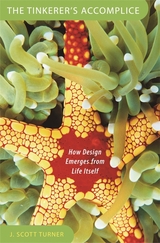 The Tinkerer's Accomplice: How Design Emerges from Life Itself
J. Scott Turner
Harvard University Press, 2010 Most people, when they contemplate the living world, conclude that it is a designed place. So it is jarring when biologists come along and say this is all wrong. What most people see as design, they say--purposeful, directed, even intelligent--is only an illusion, something cooked up in a mind that is eager to see purpose where none exists. In these days of increasingly assertive challenges to Darwinism, the question becomes acute: is our perception of design simply a mental figment, or is there something deeper at work?
Physiologist Scott Turner argues eloquently and convincingly that the apparent design we see in the living world only makes sense when we add to Darwin's towering achievement the dimension that much modern molecular biology has left on the gene-splicing floor: the dynamic interaction between living organisms and their environment. Only when we add environmental physiology to natural selection can we begin to understand the beautiful fit between the form life takes and how life works.
In The Tinkerer's Accomplice, Scott Turner takes up the question of design as a very real problem in biology; his solution poses challenges to all sides in this critical debate.
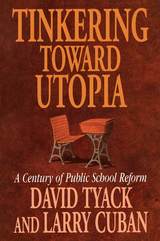 Tinkering toward Utopia: A Century of Public School Reform
David Tyack and Larry Cuban
Harvard University Press, 1997 For over a century, Americans have translated their cultural anxieties and hopes into dramatic demands for educational reform. Although policy talk has sounded a millennial tone, the actual reforms have been gradual and incremental. Tinkering toward Utopia documents the dynamic tension between Americans’ faith in education as a panacea and the moderate pace of change in educational practices.
In this book, David Tyack and Larry Cuban explore some basic questions about the nature of educational reform. Why have Americans come to believe that schooling has regressed? Have educational reforms occurred in cycles, and if so, why? Why has it been so difficult to change the basic institutional patterns of schooling? What actually happened when reformers tried to “reinvent” schooling?
Tyack and Cuban argue that the ahistorical nature of most current reform proposals magnifies defects and understates the difficulty of changing the system. Policy talk has alternated between lamentation and overconfidence. The authors suggest that reformers today need to focus on ways to help teachers improve instruction from the inside out instead of decreeing change by remote control, and that reformers must also keep in mind the democratic purposes that guide public education.
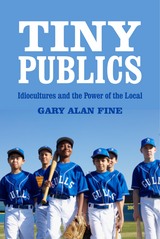 Tiny Publics: A Theory of Group Action and Culture
Gary Alan Fine
Russell Sage Foundation, 2012 If all politics is local, then so is almost everything else, argues sociologist Gary Alan Fine. We organize our lives by relying on those closest to us—family members, friends, work colleagues, team mates, and other intimates—to create meaning and order. In this thoughtful and wide-ranging book, Fine argues that the basic building blocks of society itself are forged within the boundaries of such small groups, the "tiny publics" necessary for a robust, functioning social order at all levels. Action, meaning, authority, inequality, organization, and institutions all have their roots in small groups. Yet for the past twenty-five years social scientists have tended to ignore the power of groups in favor of an emphasis on organizations, societies, or individuals. Based on over thirty-five years of Fine's own ethnographic research across an array of small groups, Tiny Publics presents a compelling new theory of the pivotal role of small groups in organizing social life. No social system can thrive without flourishing small groups. They provide havens in an impersonal world, where faceless organizations become humanized. Taking examples from such diverse worlds as Little League baseball teams, restaurant workers, high school debate teams, weather forecasters, and political volunteers, Fine demonstrates how each group has its own unique culture, or idioculture—the system of knowledge, beliefs, behavior, and customs that define and hold a group together. With their dense network of relationships, groups serve as important sources of social and cultural capital for their members. The apparently innocuous jokes, rituals, and nicknames prevalent within Little League baseball teams help establish how teams function internally and how they compete with other teams. Small groups also provide a platform for their members to engage in broader social discourse and a supportive environment to begin effecting change in larger institutions. In his studies of mushroom collectors and high school debate teams, Fine demonstrates the importance of stories that group members tell each other about their successes and frustrations in fostering a strong sense of social cohesion. And Fine shows how the personal commitment political volunteers bring to their efforts is reinforced by the close-knit nature of their work, which in turn has the power to change larger groups and institutions. In this way, the actions and debates begun in small groups can eventually radiate outward to affect every level of society. Fine convincingly demonstrates how small groups provide fertile ground for the seeds of civic engagement. Outcomes often attributed to large-scale social forces originate within such small-scale domains. Employing rich insights from both sociology and social psychology, as well as vivid examples from a revealing array of real-work groups, Tiny Publics provides a compelling examination of the importance of small groups and of the rich vitality they bring to social life. A Volume in the Russell Sage Foundation Series on Trust
|
|

